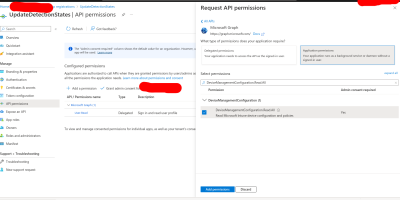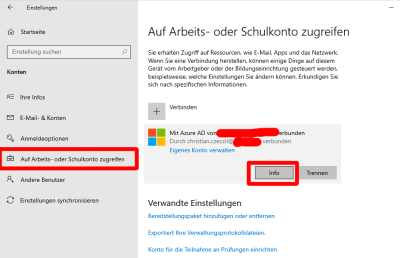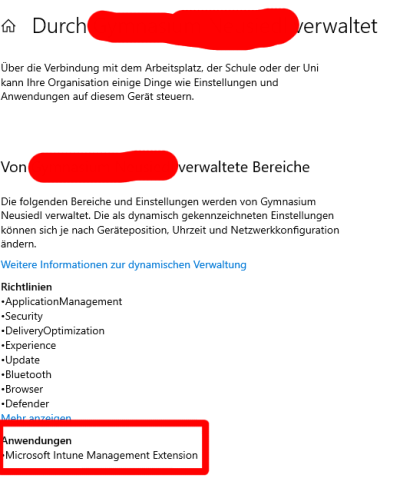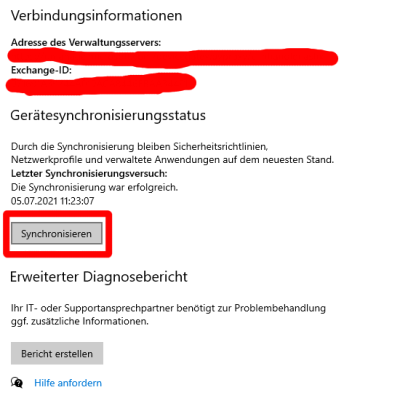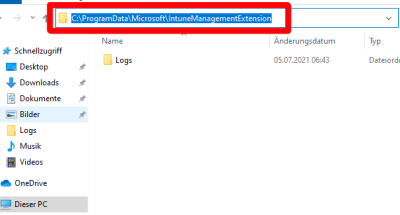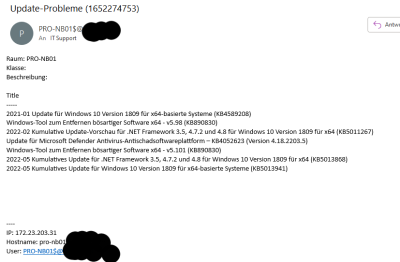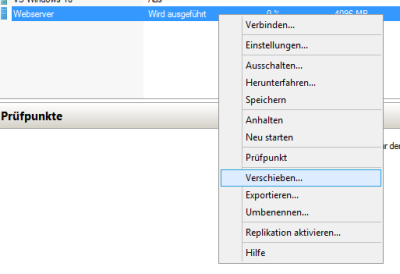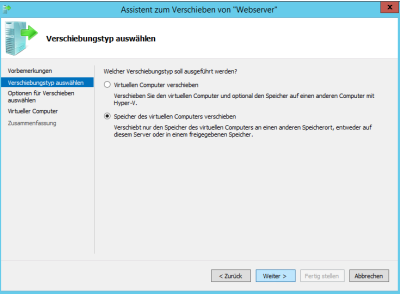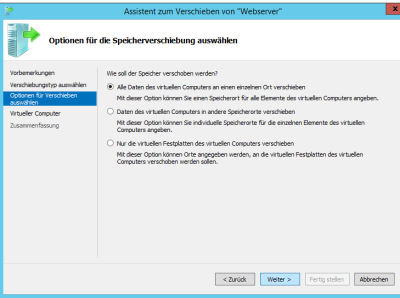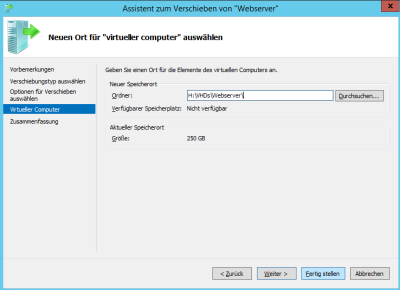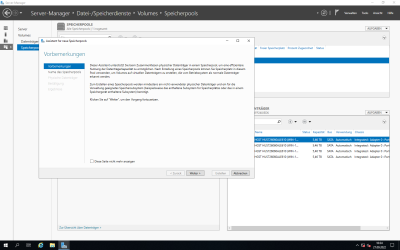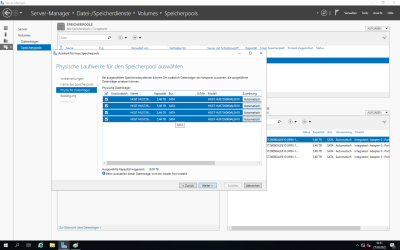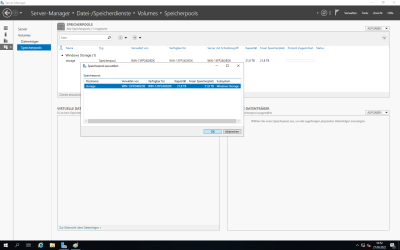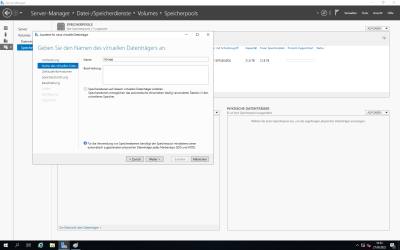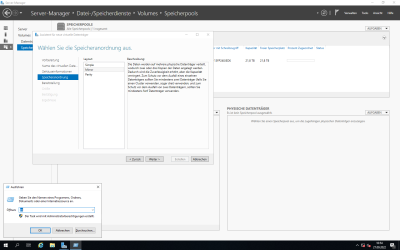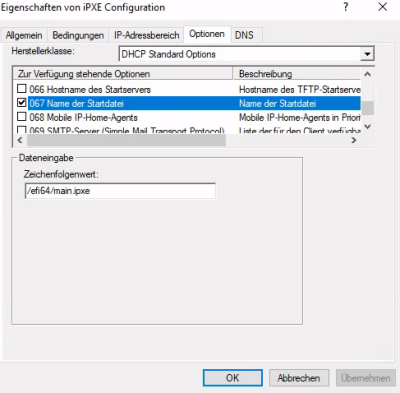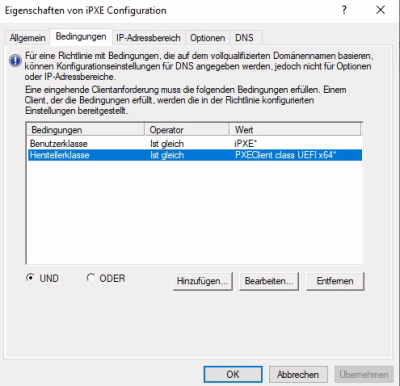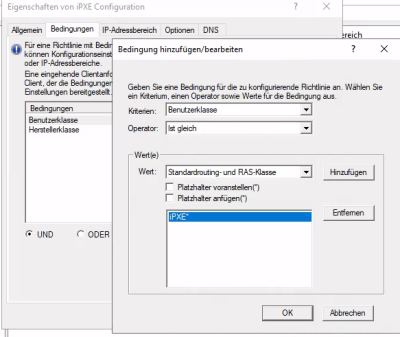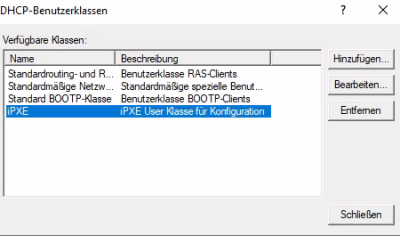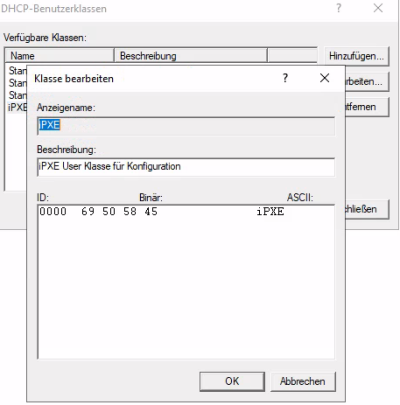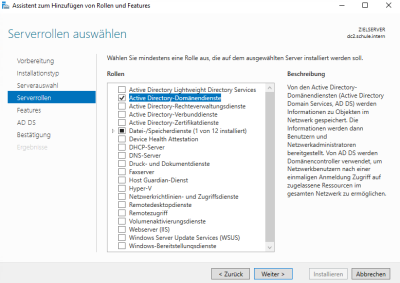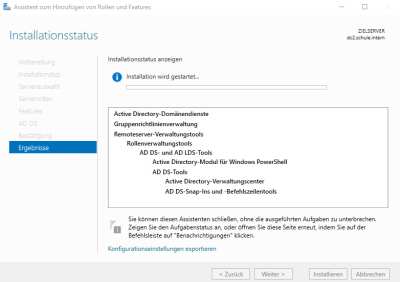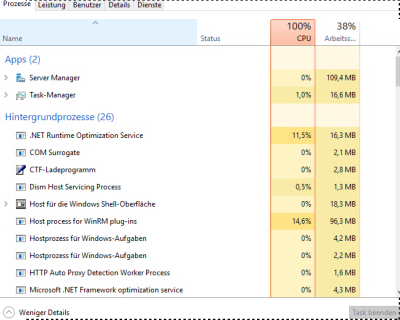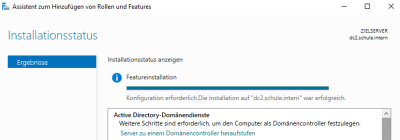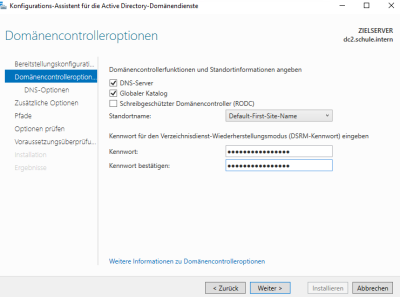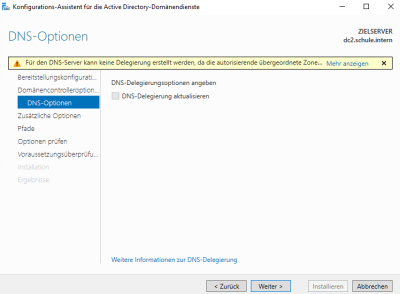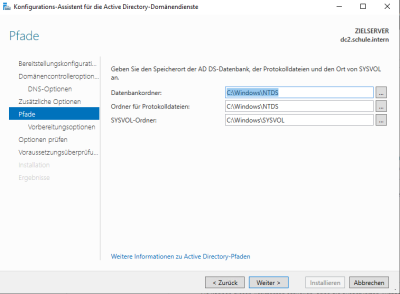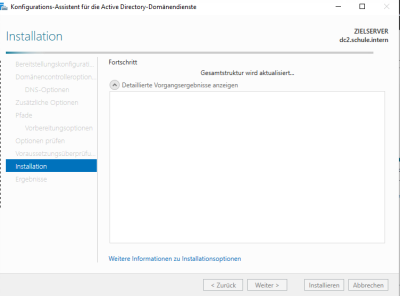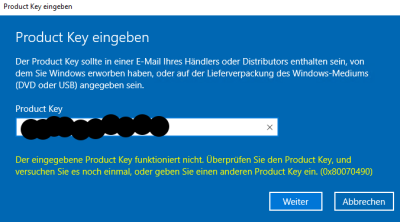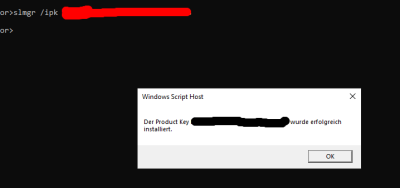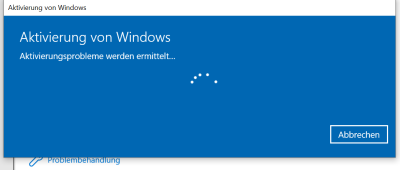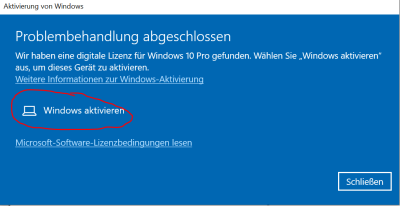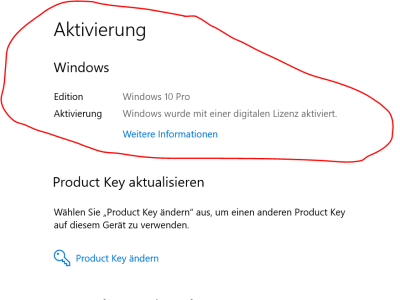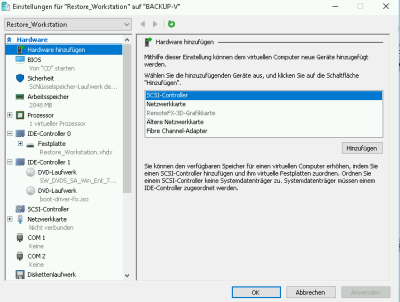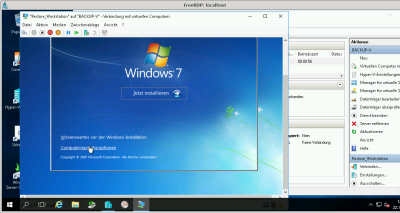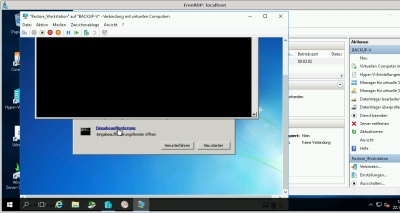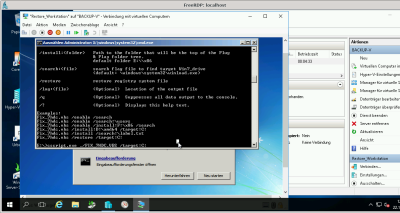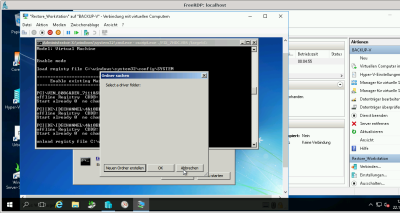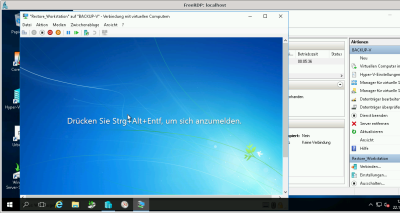
reportMalwareDevices.php
Analog zu reportUpdateStates.php Permissions von deviceManagement read reicht aus
Lass dir von Microsoft einen Intune Malware Report geben und zeige mir alle Systeme auf denen Malware gefunden wurde / kann als Cron Job täglich ausgeführt werden , dann muss $past_timestamp entsprechend angepasst werden - damit nicht immer die gleichen Devices angezeigt werden
-
<?php
#2022-11-14 cc: Thanks https://stackoverflow.com/questions/3892635/how-to-have-php-to-use-proxy-setting-to-connect-to-internet
stream_context_set_default(['http'=>['proxy'=>'10.0.0.1:8080']]);
$curl_token= curl_init();
//Azure AD Administration: Tenant properties / Tenant ID: 12345678-9-10-11
//
// Details: https://docs.microsoft.com/en-us/graph/auth-v2-service
curl_setopt($curl_token,CURLOPT_URL, "https://login.microsoftonline.com/12345678-9-10-11/oauth2/v2.0/token");
curl_setopt($curl_token,CURLOPT_HEADER,0);
curl_setopt($curl_token,CURLOPT_POST,1);
curl_setopt($curl_token,CURLOPT_POSTFIELDS,"client_id=APP_ID&scope=https%3A%2F%2Fgraph.microsoft.com%2F.default&client_secret=SHARED_SECRET_TOKEN&grant_type=client_credentials");
curl_setopt($curl_token,CURLOPT_RETURNTRANSFER,1);
$json_response=curl_exec($curl_token) or die("Cannot exec url request");
curl_close($curl_token);
$access_array=json_decode($json_response,true) or die("Cannot decode json");
//print_r($access_array);
if(!isset($access_array["access_token"]))
{
die("Cannot receive access_token");
}
$curl_token= curl_init();
#if called weekly 86400*7
$past_timestamp=time()-(86400*2);
$report_details='{ "reportName": "Malware", "localizationType": "LocalizedValuesAsAdditionalColumn", "format": "csv", "select": [ "DeviceName" ,"DetectionCount", "UPN" , "MalwareName", "MalwareCategory", "InitialDetectionDateTime", "ExecutionState" ] }';
//
//
curl_setopt($curl_token,CURLOPT_URL, "https://graph.microsoft.com/beta/deviceManagement/reports/exportJobs");
curl_setopt($curl_token,CURLOPT_HEADER,0);
curl_setopt($curl_token,CURLOPT_POST,1);
curl_setopt($curl_token, CURLOPT_POSTFIELDS, $report_details);
curl_setopt($curl_token,CURLOPT_HTTPHEADER,array("Authorization: Bearer ".$access_array["access_token"],'Content-type: application/json'));
curl_setopt($curl_token,CURLOPT_RETURNTRANSFER,1);
$json_response=curl_exec($curl_token) or die("Cannot exec url request");
curl_close($curl_token);
//print_r($json_response);
$intune_array=json_decode($json_response,true) or die("Cannot decode json");
if(!isset($intune_array["id"]))
{
echo "FAIL\n";
print_r($intune_array);
exit;
}
$success=false;
$failsafe=1;
#Failsafe is 5 hours -> 300 minutes
while (!$success && $failsafe != 300 )
{
$curl_token= curl_init();
// https://docs.microsoft.com/en-us/graph/api/intune-devices-manageddevice-list?view=graph-rest-1.0
//
curl_setopt($curl_token,CURLOPT_URL, "https://graph.microsoft.com/beta/deviceManagement/reports/exportJobs('".$intune_array["id"]."')");
curl_setopt($curl_token,CURLOPT_HEADER,0);
curl_setopt($curl_token,CURLOPT_POST,0);
curl_setopt($curl_token,CURLOPT_HTTPHEADER,array("Authorization: Bearer ".$access_array["access_token"]));
curl_setopt($curl_token,CURLOPT_RETURNTRANSFER,1);
$json_response=curl_exec($curl_token) or die("Cannot exec url request");
curl_close($curl_token);
$failsafe++;
$foo=json_decode($json_response,true);
//print_r($foo);
sleep(60);
if(isset($foo["status"]) && $foo["status"] == "completed" )
{
$success=true;
}
}
if($failsafe == 300)
{
echo "Failsafe time reached - TIMEOUT";
exit;
}
#echo "Success url: ".$foo["url"];
$zipped_content=file_get_contents($foo["url"]);
file_put_contents("/tmp/malware_report.zip",$zipped_content);
$filename_unzipped_report=exec("unzip -d /tmp/ -o /tmp/malware_report.zip | grep \"inflating:\" | cut -d\":\" -f\"2\" | tr -d [:space:]");
if(!is_readable($filename_unzipped_report))
{
echo "Cannot read $filename_unzipped_report";
exit;
}
$contents_file=file_get_contents($filename_unzipped_report);
$file_handle=fopen($filename_unzipped_report,"r") or die("cannot read report");
$results=array();
while(($line=fgetcsv($file_handle,1000,","))!==FALSE)
{
array_push($results,$line);
}
unlink($filename_unzipped_report);
if(count($results)>1)
{
for($i=1 ; $i<count($results) ;$i++)
{
$malwareTimestamp=strtotime($results[$i][6]);
if($malwareTimestamp >= $past_timestamp )
{
print_r($results[$i]);
#"DeviceName" ,"DetectionCount", "UPN" , "MalwareName", "MalwareCategory", "InitialDetectionDateTime", "ExecutionState"
echo "0=> DeviceName , 1=> DetectionCount , 2=> UPN des MDM Deployment Benutzers, 3=>MalwareName , 4=>MalwareCategory, 5=> InitialDetectionTime , 6=> ExecutionState\n-------------------------------------------\n";
}
}
}
exit;
?>
reportUpdateStates.php
Array
(
[error] => Array
(
[code] => BadRequest
[message] => Resource not found for the segment 'deviceUpdateStates
.....
Ich möchte einen Report erhalten der mir zeigt wie viele Intune Devices die letztmöglichen Funktions/Qualitäts Updates erhalten haben, um zu sehen ob der Update Ring greift
Es ist wirklich sehr schön die Quality Version Strings in der Form von zB: „10.0.19043.2006“ zu bekommen - das Release Date bzw. der Bezug zum Erscheinungsdatum wär auch wünschenswert - leider gibt es offenbar keine einfache Möglichkeit diese Information zu erhalten - daher wird sie über wikipedia bezogen und ggf. geparsed wenn möglich
<?php
#2022-11-14 cc: Thanks https://stackoverflow.com/questions/3892635/how-to-have-php-to-use-proxy-setting-to-connect-to-internet
stream_context_set_default(['http'=>['proxy'=>'IP_PROXY:PORT_PROXY']]);
$curl_token= curl_init();
//Azure AD Administration: Tenant properties / Tenant ID: determine TENANT ID
//
// Details: https://docs.microsoft.com/en-us/graph/auth-v2-service
curl_setopt($curl_token,CURLOPT_URL, "https://login.microsoftonline.com/TENANT_ID/oauth2/v2.0/token");
curl_setopt($curl_token,CURLOPT_HEADER,0);
curl_setopt($curl_token,CURLOPT_POST,1);
curl_setopt($curl_token,CURLOPT_POSTFIELDS,"client_id=CLIENT_ID&scope=https%3A%2F%2Fgraph.microsoft.com%2F.default&client_secret=CLIENT_SHARED_SECRET&grant_type=client_credentials");
curl_setopt($curl_token,CURLOPT_RETURNTRANSFER,1);
$json_response=curl_exec($curl_token) or die("Cannot exec url request");
curl_close($curl_token);
$access_array=json_decode($json_response,true) or die("Cannot decode json");
//print_r($access_array);
if(!isset($access_array["access_token"]))
{
fwrite(STDERR,"Cannot receive access_token");
die("Cannot receive access_token");
}
$curl_token= curl_init();
#2022-11-10 cc: Nice this way i get tendant wide security alerts that have occured .. another project :)
#curl_setopt($curl_token,CURLOPT_URL,"https://graph.microsoft.com/beta/security/alerts_v2");
#2022-11-10 cc: This way i get all the configuration for all devices in json style objects with ID's - i need Update configuration ID foo
#curl_setopt($curl_token,CURLOPT_URL,"https://graph.microsoft.com/beta/deviceManagement/deviceConfigurations");
/*
[6] => stdClass Object
(
[@odata.type] => #microsoft.graph.windowsUpdateForBusinessConfiguration
[id] => DEVICE_CONFIGURATION_ID
[lastModifiedDateTime] => 2022-11-09T08:38:57.0592898Z
[roleScopeTagIds] => Array
(
[0] => 0
)
[supportsScopeTags] => 1
[deviceManagementApplicabilityRuleOsEdition] =>
[deviceManagementApplicabilityRuleOsVersion] =>
[deviceManagementApplicabilityRuleDeviceMode] =>
[createdDateTime] => 2020-12-21T10:13:02.1935774Z
[description] => Windows Update-Richtlinie
[displayName] => Windows Update-Richtlinie
[version] => 10
[deliveryOptimizationMode] => httpWithPeeringNat
[prereleaseFeatures] => notAllowed
[automaticUpdateMode] => autoInstallAndRebootAtMaintenanceTime
[microsoftUpdateServiceAllowed] => 1
[driversExcluded] =>
[qualityUpdatesDeferralPeriodInDays] => 0
[featureUpdatesDeferralPeriodInDays] => 0
[qualityUpdatesPaused] =>
[featureUpdatesPaused] =>
[qualityUpdatesPauseExpiryDateTime] => 0001-01-01T00:00:00Z
[featureUpdatesPauseExpiryDateTime] => 0001-01-01T00:00:00Z
[businessReadyUpdatesOnly] => businessReadyOnly
[skipChecksBeforeRestart] => 1
[updateWeeks] =>
[qualityUpdatesPauseStartDate] =>
[featureUpdatesPauseStartDate] =>
[featureUpdatesRollbackWindowInDays] => 30
[qualityUpdatesWillBeRolledBack] =>
[featureUpdatesWillBeRolledBack] =>
[qualityUpdatesRollbackStartDateTime] => 0001-01-01T00:00:00Z
[featureUpdatesRollbackStartDateTime] => 0001-01-01T00:00:00Z
[engagedRestartDeadlineInDays] =>
[engagedRestartSnoozeScheduleInDays] =>
[engagedRestartTransitionScheduleInDays] =>
[deadlineForFeatureUpdatesInDays] =>
[deadlineForQualityUpdatesInDays] =>
[deadlineGracePeriodInDays] =>
[postponeRebootUntilAfterDeadline] =>
[autoRestartNotificationDismissal] => notConfigured
[scheduleRestartWarningInHours] =>
[scheduleImminentRestartWarningInMinutes] => 15
[userPauseAccess] => disabled
[userWindowsUpdateScanAccess] => disabled
[updateNotificationLevel] => restartWarningsOnly
[allowWindows11Upgrade] =>
[installationSchedule] => stdClass Object
(
[@odata.type] => #microsoft.graph.windowsUpdateActiveHoursInstall
[activeHoursStart] => 08:00:00.0000000
[activeHoursEnd] => 17:00:00.0000000
)
)
)
)
*/
/* Request contains the Configuration ID of the defined Update Ring */
curl_setopt($curl_token,CURLOPT_URL,"https://graph.microsoft.com/beta/deviceManagement/deviceConfigurations/DEVICE_CONFIGURATION_ID/microsoft.graph.windowsUpdateForBusinessConfiguration/deviceUpdateStates");
curl_setopt($curl_token,CURLOPT_HEADER,0);
curl_setopt($curl_token,CURLOPT_POST,0);
curl_setopt($curl_token,CURLOPT_HTTPHEADER,array("Authorization: Bearer ".$access_array["access_token"]));
curl_setopt($curl_token,CURLOPT_RETURNTRANSFER,1);
$json_response=curl_exec($curl_token) or die("Cannot exec url request");
curl_close($curl_token);
//print_r(json_decode($json_response,true));
$update_array=json_decode($json_response,true);
if(!$update_array)
{
fwrite(STDERR,"Cannot decode json");
die("Cannot decode json");
}
$update_array=$update_array["value"];
$quality_updates=array();
fwrite(STDOUT,"Number of Update Ring Devices the ms oracle sees: ".count($update_array)."\n");
$featureNotLatest=0;
$updateStateNotOk=0;
fwrite(STDOUT,"------------------------"."\n");
for($i=0; $i<count($update_array); $i++)
{
if($update_array[$i]["featureUpdateVersion"] != "Latest")
{
$featureNotLatest++;
}
if($update_array[$i]["status"] != "upToDate")
{
$updateStateNotOk++;
print_r($update_array[$i]);
}
if( !isset($quality_updates[$update_array[$i]["qualityUpdateVersion"]]["count"]))
{
$quality_updates[$update_array[$i]["qualityUpdateVersion"]]["count"]=1;
$versionInfos=searchWindowsVersion("https://en.wikipedia.org/wiki/Windows_10_version_history",$update_array[$i]["qualityUpdateVersion"]);
if($versionInfos!==false && count($versionInfos) !== 0)
{
$versionInfos=$versionInfos[0];
$quality_updates[$update_array[$i]["qualityUpdateVersion"]]["main_os"]="Windows 10";
$quality_updates[$update_array[$i]["qualityUpdateVersion"]]["version_infos"]=$versionInfos;
}
else
{
$versionInfos=searchWindowsVersion("https://en.wikipedia.org/wiki/Windows_11_version_history",$update_array[$i]["qualityUpdateVersion"]);
if($versionInfos!== false && count($versionInfos) !== 0)
{
$versionInfos=$versionInfos[0];
$quality_updates[$update_array[$i]["qualityUpdateVersion"]]["main_os"]="Windows 11";
$quality_updates[$update_array[$i]["qualityUpdateVersion"]]["version_infos"]=$versionInfos;
}
else
{
$quality_updates[$update_array[$i]["qualityUpdateVersion"]]["main_os"]="Unknown";
$quality_updates[$update_array[$i]["qualityUpdateVersion"]]["version_infos"]="Unknown";
}
}
}
else
{
$quality_updates[$update_array[$i]["qualityUpdateVersion"]]["count"]++;
}
//print_r($update_array[$i]);
}
fwrite(STDOUT,"------------------------"."\n");
fwrite(STDOUT,"Number of Devices Update State NOT upToDate: ".$updateStateNotOk."\n");
fwrite(STDOUT,"Number of Devices not the latest and greatest features: ".$featureNotLatest."\n");
fwrite(STDOUT,"Oracle percentage devices OK: ".(((count($update_array)-$updateStateNotOk)/count($update_array))*100)."\n");
fwrite(STDOUT,"Oracle sees the following quality Update versions: "."\n");
array_multisort($quality_updates);
print_r($quality_updates);
/*
Array
(
[id] => ID
[deviceId] => ID
[userId] => ID
[deviceDisplayName] => FOOHOO
[userPrincipalName] => FOOHOO@SCHOOL
[status] => upToDate
[qualityUpdateVersion] => 10.0.19043.2006
[featureUpdateVersion] => Latest
[lastScanDateTime] => 2022-11-03T17:34:03Z
[lastSyncDateTime] => 2022-11-10T02:28:53.6236504Z
)
* */
/*
Array
(
[0] => Array
(
[versionId] => 10.0.22000.1219[58]
[releaseInfo] => Release Preview Channel and public release:November 8, 2022
)
)
*/
function searchWindowsVersion($url,$version)
{
$html=file_get_contents($url);
if(!$html)
{
return false;
}
#2022-11-14 cc: Thanks https://www.tutorialspoint.com/php/php_dom_parser_example.htm#
/*** a new dom object ***/
$dom = new domDocument;
/*** load the html into the object ***/
@$dom->loadHTML($html);
/*** discard white space ***/
$dom->preserveWhiteSpace = false;
/*** the table by its tag name ***/
$tables = $dom->getElementsByTagName('table');
$results=array();
for($i=0 ; $i< $tables->length ; $i++)
{
/*** get all rows from the table ***/
$rows = $tables->item($i)->getElementsByTagName('tr');
/*** loop over the table rows ***/
foreach ($rows as $row) {
/*** get each column by tag name ***/
$cols = $row->getElementsByTagName('td');
if(isset($cols->item(0)->nodeValue) )
{
if(stripos($cols->item(0)->nodeValue,$version)!==false)
{
$result=array();
$result["versionId"]=@$cols->item(0)->nodeValue;
#2022-11-14 cc: Decide if you want KBINFO or not - it's not consistent in the Wikipedia pages
#$result["releaseInfo"]=@$cols->item(1)->nodeValue." ".@$cols->item(2)->nodeValue;
$result["releaseInfo"]=@$cols->item(2)->nodeValue;
array_push($results,$result);
}
}
}
}
return $results;
}
?>
Azure App Registrierung
reportLegacyNotebooks.php
<?php
$server = "ldaps://FQDN_AD_SERVER:636";
//domain user to connect to LDAP
$user = "STANDARD_USER_AD";
//user password
$passwd = "PASSWD";
$dn = "DINSTINGUISHED_NAME_USERS_OU";
$errUser=0;
$countAll=0;
$okUser=0;
$intuneDevices=getIntuneDevices();
if(!is_array($intuneDevices))
{
die("Cannot read intuneDevices");
}
echo "All notebooks that don't have a user anymore: "."\n";
$countAll=count($intuneDevices);
for ($k=0; $k<count($intuneDevices) ; $k++)
{
$ds=ldap_connect($server);
$r=ldap_bind($ds, $user , $passwd);
$sr=ldap_search($ds, $dn, "(|(proxyAddresses=smtp:".$intuneDevices[$k]["userPrincipalName"].")(userprincipalname=".$intuneDevices[$k]["userPrincipalName"]."))", array(0=>"UserPrincipalName",1=>"proxyAddresses"));
$data = ldap_get_entries($ds, $sr);
//print_r($data);
//exit;
if($data["count"]===0)
{
echo "FAIL - Device: ".$intuneDevices[$k]["deviceName"]." / ManagedName: ".$intuneDevices[$k]["managedDeviceName"]." has no user Account anymore: ".$intuneDevices[$k]["userPrincipalName"]."\n";
$errUser++;
}
else
{
$okUser++;
}
ldap_close($ds);
}
echo "Summary:\n";
echo "All notebook objects found: ".$countAll."\n";
echo "All notebook objects ok: ".$okUser."\n";
echo "Consistency integrity: ";
printf("%.2f \n",(($okUser/$countAll)*100));
echo "Errors Notebook/User count: ".$errUser."\n";
echo "OU's that i looked for :\n";
print_r($dn);
echo "\n";
function getIntuneDevices()
{
$curl_token= curl_init();
//Azure AD Administration: Tenant properties / Tenant ID: 123-123-123
//
// Details: https://docs.microsoft.com/en-us/graph/auth-v2-service
curl_setopt($curl_token,CURLOPT_URL, "https://login.microsoftonline.com/123-123-123/oauth2/v2.0/token");
curl_setopt($curl_token,CURLOPT_HEADER,0);
curl_setopt($curl_token,CURLOPT_POST,1);
curl_setopt($curl_token,CURLOPT_POSTFIELDS,"client_id=123-123-123&scope=https%3A%2F%2Fgraph.microsoft.com%2F.default&client_secret=SHARED_SECRET_CREDENTIALS&grant_type=client_credentials");
curl_setopt($curl_token,CURLOPT_RETURNTRANSFER,1);
$json_response=curl_exec($curl_token) or die("Cannot exec url request");
curl_close($curl_token);
$access_array=json_decode($json_response,true) or die("Cannot decode json");
//print_r($access_array);
if(!isset($access_array["access_token"]))
{
die("Cannot receive access_token");
}
$curl_token= curl_init();
// https://docs.microsoft.com/en-us/graph/api/intune-devices-manageddevice-list?view=graph-rest-1.0
//
curl_setopt($curl_token,CURLOPT_URL, "https://graph.microsoft.com/v1.0/deviceManagement/managedDevices");
curl_setopt($curl_token,CURLOPT_HEADER,0);
curl_setopt($curl_token,CURLOPT_POST,0);
curl_setopt($curl_token,CURLOPT_HTTPHEADER,array("Authorization: Bearer ".$access_array["access_token"]));
curl_setopt($curl_token,CURLOPT_RETURNTRANSFER,1);
$json_response=curl_exec($curl_token) or die("Cannot exec url request");
curl_close($curl_token);
//print_r($json_response);
$intune_array=json_decode($json_response,true) or die("Cannot decode json");
$intune_array=$intune_array["value"];
return $intune_array;
}
?>
...
if(preg_match("/^[a-z,0-9]{33}/i",$intuneDevices[$k]["userPrincipalName"])===1)
{
echo "FAIL - Device: ".$intuneDevices[$k]["deviceName"]." / ManagedName: ".$intuneDevices[$k]["managedDeviceName"]." has no user Account anymore: ".$intuneDevices[$k]["userPrincipalName"]."\n";
$errUser++;
}
else
{
$okUser++;
}
...
reportMissingNotebooksOwnerBased.php
Analog zu reportMissingNotebooks.php nur um die Schüler der 3. und 4. Klasse ergänzt
Achtung - Da die
API bei 500 Devices deckelt muss ab 500 eine andere Lösung gefunden werden / Ermittle alle betroffenen User über LDAP im AD und ermittle für jeden einzelnen User die Zugehörigkeit zu einem registrierten Gerät
Update - es ist doch möglich mehr als 500 Devices zu erhalten mit pagination kann zum nächsten Link geblättert werden - danke an Herrn Christoph Pachler
<?php
$server = "ldaps://FQDN:636";
//domain user to connect to LDAP
$user = "USERNAME";
//user password
$passwd = "PASSWORD";
$dn = array(0=>"OU_PATH_ALL_PUPILS");
$classesRegex="/^(1|2|3|4).*$/";
$search="(objectClass=user)";
$errUser=0;
$countAll=0;
$okUser=0;
echo "All Users that haven't enrolled a device: "."\n";
for ($j=0; $j<count($dn); $j++)
{
$ds=ldap_connect($server);
$r=ldap_bind($ds, $user , $passwd);
$sr=ldap_search($ds, $dn[$j], $search, array(0=>"UserPrincipalName",1=>"distinguishedName",2=>"department",3=>"description"));
$data = ldap_get_entries($ds, $sr);
// $countAll+=$data["count"];
for ($i=0; $i<$data["count"]; $i++)
{
//echo ($data[$i]["distinguishedname"][0])."\n";
//echo ($data[$i]["userprincipalname"][0])."\n";
//echo ($data[$i]["department"][0])."\n";
$distinguishedName=strtolower($data[$i]["distinguishedname"][0]);
$userPrincipalName=strtolower($data[$i]["userprincipalname"][0]);
$department=strtolower(@$data[$i]["department"][0]);
$regMatch=preg_match($classesRegex,$department);
if($regMatch !== 0)
{
if(!isset($data[$i]["department"][0]))
{
echo "FAIL - User: ".$distinguishedName." has no Department"."\n";
$errUser++;
}
$countAll++;
//Debugging is phun
//echo $distinguishedName."\n";
//echo $department."\n";
$notFound=true;
$intuneDevices=getIntuneDevices($userPrincipalName);
#Don't hammer microsofts api
sleep(rand(3,15));
for ($k=0; $k<count($intuneDevices) && $notFound; $k++)
{
/*
[deviceOwnership] => Personal
[deviceVersion] => 2
[displayName] => LAPTOP
[domainName] =>
[enrollmentProfileName] =>
[enrollmentType] => UserEnrollment
[externalSourceName] =>
[isCompliant] => 1
[isManaged] => 1
[isRooted] =>
[managementType] => MDM
[manufacturer] => LENOVO
*/
if($intuneDevices[$k]["enrollmentType"]=="UserEnrollment" && $intuneDevices[$k]["manufacturer"]=="LENOVO" &&$intuneDevices[$k]["deviceOwnership"]== "Personal" )
{
$notFound=false;
}
}
if($notFound)
{
echo "FAIL - User: ".$distinguishedName." has no enrolled device"."\n";
$errUser++;
}
else
{
$okUser++;
}
// Device Details: print_r($intuneDevices[--$k]);
}
}
// close connection
ldap_close($ds);
}
echo "Summary:\n";
echo "All user objects found: ".$countAll."\n";
echo "All user objects ok: ".$okUser."\n";
echo "Consistency integrity: ";
printf("%.2f \n",(($okUser/$countAll)*100));
echo "Errors User count: ".$errUser."\n";
echo "Regex Classroom check: ".$classesRegex."\n";
echo "OU's that i looked for :\n";
print_r($dn);
echo "\n";
function getIntuneDevices($userUPN)
{
$curl_token= curl_init();
//Azure AD Administration: Tenant properties / Tenant ID: 123-123-123-123
//
// Details: https://docs.microsoft.com/en-us/graph/auth-v2-service
curl_setopt($curl_token,CURLOPT_URL, "https://login.microsoftonline.com/123-123-123-123/oauth2/v2.0/token");
curl_setopt($curl_token,CURLOPT_HEADER,0);
curl_setopt($curl_token,CURLOPT_POST,1);
curl_setopt($curl_token,CURLOPT_POSTFIELDS,"client_id=CLIENT_ID_APP&scope=https%3A%2F%2Fgraph.microsoft.com%2F.default&client_secret=SHARED_SECRET&grant_type=client_credentials");
curl_setopt($curl_token,CURLOPT_RETURNTRANSFER,1);
$json_response=curl_exec($curl_token) or die("Cannot exec url request");
curl_close($curl_token);
$access_array=json_decode($json_response,true) or die("Cannot decode json");
//print_r($access_array);
if(!isset($access_array["access_token"]))
{
die("Cannot receive access_token");
}
$curl_token= curl_init();
curl_setopt($curl_token,CURLOPT_URL, "https://graph.microsoft.com/v1.0/users/".$userUPN."/ownedDevices");
curl_setopt($curl_token,CURLOPT_HEADER,0);
curl_setopt($curl_token,CURLOPT_POST,0);
curl_setopt($curl_token,CURLOPT_HTTPHEADER,array("Authorization: Bearer ".$access_array["access_token"]));
curl_setopt($curl_token,CURLOPT_RETURNTRANSFER,1);
$json_response=curl_exec($curl_token) or die("Cannot exec url request");
curl_close($curl_token);
//print_r($json_response);
$intune_array=json_decode($json_response,true) or die("Cannot decode json");
$intune_array=$intune_array["value"];
return $intune_array;
}
?>
reportMissingNotebooks.php
Analog zu reportRiskUsers.php
Finde alle Schüler der 1. und 2. Klasse die kein Notebook enrolled haben / zB: als Cron Job
Im LDAP Attribut Department befindet sich die Klassenbzeichnung zB: 2E
Achtung Graph
API deckelt bei 500 Devices d.h. ab 500 Notebooks muss eine andere Lösung gefunden werden
Update Es ist doch möglich mehr als 500 Devices zu erhalten - es muss in den Results geblättert werden über den nächsten Link → if(isset($intune_array[„@odata.nextLink“])) , Vielen Dank an Herrn Christoph Pachler
<?php
$server = "ldaps://FQDN_AD_SERVER:636";
//domain user to connect to LDAP
$user = "STANDARD_USER@DOMAIN_AD";
//user password
$passwd = "PASSWD";
$dn = array(0=>"OU_PATH_ALL_PUPILS");
$classesRegex="/^(1|2).*$/";
$search="(objectClass=user)";
$errUser=0;
$countAll=0;
$okUser=0;
$intuneDevices=getIntuneDevices();
if(!is_array($intuneDevices))
{
die("Cannot read intuneDevices");
}
for ($j=0; $j<count($dn); $j++)
{
$ds=ldap_connect($server);
$r=ldap_bind($ds, $user , $passwd);
$sr=ldap_search($ds, $dn[$j], $search, array(0=>"UserPrincipalName",1=>"distinguishedName",2=>"department",3=>"description"));
$data = ldap_get_entries($ds, $sr);
for ($i=0; $i<$data["count"]; $i++)
{
//debugging is phun
//echo ($data[$i]["distinguishedname"][0])."\n";
//echo ($data[$i]["userprincipalname"][0])."\n";
//echo ($data[$i]["department"][0])."\n";
$distinguishedName=strtolower($data[$i]["distinguishedname"][0]);
$userPrincipalName=strtolower($data[$i]["userprincipalname"][0]);
$department=strtolower(@$data[$i]["department"][0]);
$regMatch=preg_match($classesRegex,$department);
if($regMatch !== 0)
{
if(!isset($data[$i]["department"][0]))
{
echo "FAIL - User: ".$distinguishedName." has no Department"."\n";
$errUser++;
}
$countAll++;
//Debugging is phun
//echo $distinguishedName."\n";
//echo $department."\n";
$notFound=true;
for ($j=0; $j<count($intuneDevices) && $notFound; $j++)
{
$devicePrincipalName=strtolower($intuneDevices[$j]["userPrincipalName"]);
if($userPrincipalName == $devicePrincipalName )
{
$notFound=false;
}
}
if($notFound)
{
echo "FAIL - User: ".$distinguishedName." has no enrolled device"."\n";
$errUser++;
}
else
{
$okUser++;
}
// Device Details: print_r($intuneDevices[--$j]);
}
}
// close connection
ldap_close($ds);
}
echo "Summary:\n";
echo "All user objects found: ".$countAll."\n";
echo "All user objects ok: ".$okUser."\n";
echo "Consistency integrity: ";
printf("%.2f \n",(($okUser/$countAll)*100));
echo "Errors computer count: ".$errUser."\n";
echo "Regex Classroom check: ".$classesRegex."\n";
echo "OU's that i looked for :\n";
print_r($dn);
echo "\n";
function getIntuneDevices()
{
$curl_token= curl_init();
//Azure AD Administration: Tenant properties / Tenant ID: 123-123-123
//
// Details: https://docs.microsoft.com/en-us/graph/auth-v2-service
curl_setopt($curl_token,CURLOPT_URL, "https://login.microsoftonline.com/123-123-123/oauth2/v2.0/token");
curl_setopt($curl_token,CURLOPT_HEADER,0);
curl_setopt($curl_token,CURLOPT_POST,1);
curl_setopt($curl_token,CURLOPT_POSTFIELDS,"client_id=foo-foo-foo&scope=https%3A%2F%2Fgraph.microsoft.com%2F.default&client_secret=CLIENT_SECRET&grant_type=client_credentials");
curl_setopt($curl_token,CURLOPT_RETURNTRANSFER,1);
$json_response=curl_exec($curl_token) or die("Cannot exec url request");
curl_close($curl_token);
$access_array=json_decode($json_response,true) or die("Cannot decode json");
//print_r($access_array);
if(!isset($access_array["access_token"]))
{
die("Cannot receive access_token");
}
$curl_token= curl_init();
// https://docs.microsoft.com/en-us/graph/api/intune-devices-manageddevice-list?view=graph-rest-1.0
//
curl_setopt($curl_token,CURLOPT_URL, "https://graph.microsoft.com/v1.0/deviceManagement/managedDevices");
curl_setopt($curl_token,CURLOPT_HEADER,0);
curl_setopt($curl_token,CURLOPT_POST,0);
curl_setopt($curl_token,CURLOPT_HTTPHEADER,array("Authorization: Bearer ".$access_array["access_token"]));
curl_setopt($curl_token,CURLOPT_RETURNTRANSFER,1);
$json_response=curl_exec($curl_token) or die("Cannot exec url request");
curl_close($curl_token);
//print_r($json_response);
$intune_array=json_decode($json_response,true) or die("Cannot decode json");
$intune_array=$intune_array["value"];
return $intune_array;
}
?>
reportIntuneDevices.php
Analog zu reportRiskUsers.php
-
Update bei mehr als 500 Geräten muss geblättert werden nextLink
Es sollen alle im Intune registrierten Geräte gezogen werden
...
...
Bearer Access Token organisieren wie bei reportRiskUsers.php
...
...
$devicesLink="https://graph.microsoft.com/v1.0/deviceManagement/managedDevices";
$intune_all=array();
while(strlen($devicesLink))
{
$curl_token= curl_init();
// https://docs.microsoft.com/en-us/graph/api/intune-devices-manageddevice-list?view=graph-rest-1.0
//
curl_setopt($curl_token,CURLOPT_URL, $devicesLink);
curl_setopt($curl_token,CURLOPT_HEADER,0);
curl_setopt($curl_token,CURLOPT_POST,0);
curl_setopt($curl_token,CURLOPT_HTTPHEADER,array("Authorization: Bearer ".$access_array["access_token"]));
curl_setopt($curl_token,CURLOPT_RETURNTRANSFER,1);
$json_response=curl_exec($curl_token) or die("Cannot exec url request");
curl_close($curl_token);
//print_r($json_response);
$intune_array=json_decode($json_response,true) or die("Cannot decode json");
if(!isset($intune_array["@odata.nextLink"]))
{
$devicesLink="";
}
else
{
$devicesLink=$intune_array["@odata.nextLink"];
}
$intune_array=$intune_array["value"];
$intune_all=array_merge($intune_all,$intune_array);
}
return $intune_all;
}
/*
[0] => Array
(
[id] => id
[userId] => id
[deviceName] => DESKTOP-HXND
[managedDeviceOwnerType] => personal
[enrolledDateTime] => 2021-06-28T09:13:53Z
[lastSyncDateTime] => 2021-07-01T05:23:27Z
[operatingSystem] => Windows
[complianceState] => compliant
[jailBroken] => Unknown
[managementAgent] => mdm
[osVersion] => 10.0.14393.0
[easActivated] => 1
[easDeviceId] => id
[easActivationDateTime] => 0001-01-01T00:00:00Z
[azureADRegistered] => 1
[deviceEnrollmentType] => userEnrollment
[activationLockBypassCode] =>
[emailAddress] => max.mustermann@mail
[azureADDeviceId] => id
[deviceRegistrationState] => registered
[deviceCategoryDisplayName] => Unknown
[isSupervised] =>
[exchangeLastSuccessfulSyncDateTime] => 0001-01-01T00:00:00Z
[exchangeAccessState] => none
[exchangeAccessStateReason] => none
[remoteAssistanceSessionUrl] =>
[remoteAssistanceSessionErrorDetails] =>
[isEncrypted] =>
[userPrincipalName] => UPN
[model] => VirtualBox
[manufacturer] => innotek GmbH
[imei] =>
[complianceGracePeriodExpirationDateTime] => 2021-06-30T07:05:43Z
[serialNumber] => 0
[phoneNumber] =>
[androidSecurityPatchLevel] =>
[userDisplayName] => Name User
[configurationManagerClientEnabledFeatures] =>
[wiFiMacAddress] =>
[deviceHealthAttestationState] =>
[subscriberCarrier] =>
[meid] =>
[totalStorageSpaceInBytes] => 53160706048
[freeStorageSpaceInBytes] => 38004588544
[managedDeviceName] => funky name
[partnerReportedThreatState] => unknown
[iccid] =>
[udid] =>
[notes] =>
[ethernetMacAddress] =>
[physicalMemoryInBytes] => 0
[deviceActionResults] => Array
(
)
)
*/
?>
reportRiskUsers.php
Das Skript soll sich
automatisiert über die Graph
API alle Risk Infos der letzten 24 Stunden holen und die betroffenen User ausgeben
Es ist dennoch möglich zuzugreifen über die Microsoft Graph
API / Es muss eine
App im Azure erstellt werden und die Werte im PHP Skript entsprechend angepasst / Als täglicher Cron Job auf einem
Linux Server im Einsatz - wobei stdout per Mail versand wird an administrativen Mail Account :)
<?php
$curl_token= curl_init();
//Azure AD Administration: Tenant properties / Tenant ID: 1245678-89-1011-121314-1516abef
//
// Details: https://docs.microsoft.com/en-us/graph/auth-v2-service
// Vorher im Azure AD eine App anlegen https://portal.azure.com/#blade/Microsoft_AAD_IAM/ActiveDirectoryMenuBlade/RegisteredApps mit Client Secret d.h. Shared Key
// API Permissions auf IdentityRiskEvent.Read.All - muss durch Admin "Granted werden" "Grant Admin consent"
//client_id ist "APPLICATION (CLIENT) ID" der App zB: 0815123-0815123-0815123
//client_secret ist Shared Key , der bei Client Secret erstellt wurde
curl_setopt($curl_token,CURLOPT_URL, "https://login.microsoftonline.com/1245678-89-1011-121314-1516abef/oauth2/v2.0/token");
curl_setopt($curl_token,CURLOPT_HEADER,0);
curl_setopt($curl_token,CURLOPT_POST,1);
curl_setopt($curl_token,CURLOPT_POSTFIELDS,"client_id=0815123-0815123-0815123&scope=https%3A%2F%2Fgraph.microsoft.com%2F.default&client_secret=Shared Key Secret&grant_type=client_credentials");
curl_setopt($curl_token,CURLOPT_RETURNTRANSFER,1);
$json_response=curl_exec($curl_token) or die("Cannot exec url request");
curl_close($curl_token);
$access_array=json_decode($json_response,true) or die("Cannot decode json");
//print_r($access_array);
if(!isset($access_array["access_token"]))
{
die("Cannot receive access_token");
}
$curl_token= curl_init();
//https://docs.microsoft.com/ko-kr/graph/api/riskdetection-list?view=graph-rest-beta&tabs=http
curl_setopt($curl_token,CURLOPT_URL, "https://graph.microsoft.com/beta/riskDetections");
curl_setopt($curl_token,CURLOPT_HEADER,0);
curl_setopt($curl_token,CURLOPT_POST,0);
curl_setopt($curl_token,CURLOPT_HTTPHEADER,array("Authorization: Bearer ".$access_array["access_token"]));
curl_setopt($curl_token,CURLOPT_RETURNTRANSFER,1);
$json_response=curl_exec($curl_token) or die("Cannot exec url request");
curl_close($curl_token);
//print_r($json_response);
$risk_array=json_decode($json_response,true) or die("Cannot decode json");
$risk_array=$risk_array["value"];
//print_r($risk_array);
$current_timestamp=time();
/* Look back the last day, therefore *1 */
$threshold_past=$current_timestamp-(86400*1);
for($i=0; $i<count($risk_array); $i++ )
{
$riskEvent=$risk_array[$i];
$activityTimestamp=strtotime($riskEvent["activityDateTime"]);
if( $activityTimestamp >= $threshold_past )
{
echo "-----------------------------";
echo "\nUser: ".$riskEvent["userPrincipalName"];
echo "\nRisk Type: ".$riskEvent["riskType"];
echo "\nRisk Level: ".$riskEvent["riskLevel"];
echo "\nActivity: ".$riskEvent["activity"];
echo "\nSource: ".$riskEvent["source"];
echo "\nActivity Date: ".date("c",$activityTimestamp);
echo "\nLocation: ".$riskEvent["location"]["countryOrRegion"]."/".$riskEvent["location"]["state"];
echo "\nPlease visit: https://portal.azure.com/#blade/Microsoft_AAD_IAM/SecurityMenuBlade/RiskDetections";
echo "\n-----------------------------\n";
}
}
/*
[15] => Array
(
[id] => foo
[requestId] => foo
[correlationId] => foo
[riskType] => unlikelyTravel
[riskEventType] => unlikelyTravel
[riskState] => atRisk
[riskLevel] => hidden
[riskDetail] => hidden
[source] => IdentityProtection
[detectionTimingType] => offline
[activity] => signin
[tokenIssuerType] => AzureAD
[ipAddress] => ip
[activityDateTime] => date
[detectedDateTime] => date
[lastUpdatedDateTime] => date
[userId] => foo
[userDisplayName] => name
[userPrincipalName] => foo@mail
[additionalInfo] => [json_foo]
[location] => Array
(
[city] => Astoria
[state] => New York
[countryOrRegion] => US
[geoCoordinates] => Array
(
[latitude] => 0
[longitude] => 0
)
)
)
*/
?>
Azure App Registrierung
Damit die Graph
API zB: mit Shared Secret benutzt werden kann

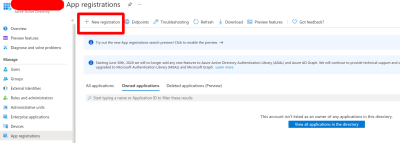
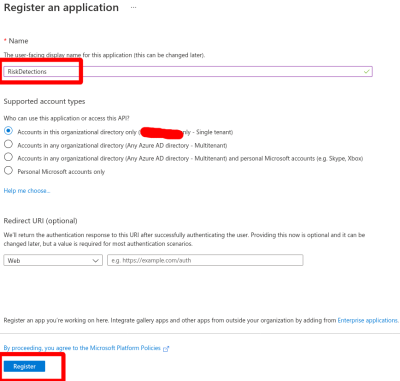
Permissions ermitteln die gebraucht werden und der App hinzufügen / siehe Microsoft Dokumentation zur jeweiligen
API
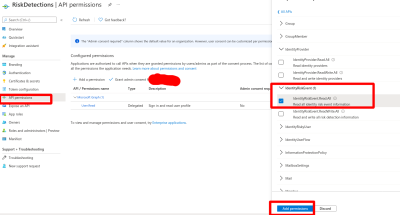
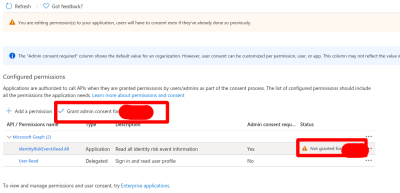
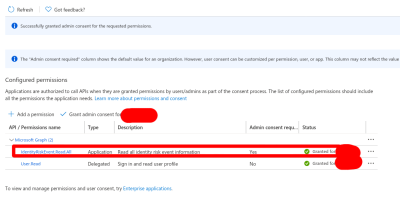
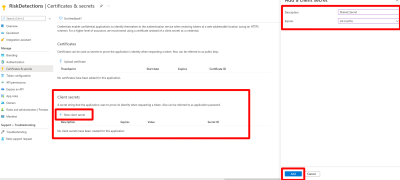
Powershell Skripte
check_last_updates.ps1
Kerberos Authentifizierung analog zu unterem Beispiel
Wann wurde zuletzt erfolgreich nach Updates gesucht oder erfolgreich Updates installiert - ist der Threshold größer als 35 Tage d.h. ist es länger als 35 Tage her möchte ich eine Notifikation erhalten
#Thanks: https://github.com/Futur-Tech/futur-tech-zabbix-windows-update
$threshold=35
try
{
$lastSuccessSearch= ((New-Object -com "Microsoft.Update.AutoUpdate").Results.LastSearchSuccessDate)
$lastSuccessInstallation =((New-Object -com "Microsoft.Update.AutoUpdate").Results.LastInstallationSuccessDate)
$today =Date
$daysPassedSearch=($today - $lastSuccessSearch ).Days
$daysPassedInstallation= ($today - $lastSuccessInstallation).Days
if( ($daysPassedSearch -gt $threshold) -or ($daysPassedInstallation -gt $threshold) )
{
$message= "ATTENTION: Last successfull search was $daysPassedSearch ($lastSuccessSearch) days ago , Last successfull installation of updates: $daysPassedInstallation ($lastSuccessInstallation) days"
write-host $message
#don't hammer the web support service with too much concurrent requests
Start-Sleep -seconds (Get-Random -Minimum 1 -Maximum 5 )
$postParams = @{room=$env:computername;submit='1';description=$message;action='3'}
Invoke-WebRequest -Uri https://support.schule.intern/support.php -Method POST -Body $postParams -UseDefaultCredentials
}
}
catch
{
write-host "ERROR - cannot get values related to last updates "
}
check_Updates_Notification_GPO_Startup.ps1
# Thank you: https://gist.github.com/Grimthorr/44727ea8cf5d3df11cf7
try
{
$UpdateSession = New-Object -ComObject Microsoft.Update.Session
$UpdateSearcher = $UpdateSession.CreateupdateSearcher()
$Updates = @($UpdateSearcher.Search("IsHidden=0 and IsInstalled=0").Updates)
$Updates= $Updates | Where-Object Type -eq 1
#2024-01-22 cc: Exclude Microcode Update Intel (KB4589208) and Defender Signature Updates
$Updates= $Updates | Where-Object Title -NotLike "*Microsoft Defender Antivirus*"
$Updates= $Updates | Where-object Title -NotLike "*(KB4589208)"
$message = $Updates | Select Title | Out-String -Width 250
if ($message.Length )
{
write-host "Updates available !"
#don't hammer the web support service with too much concurrent requests
Start-Sleep -seconds (Get-Random -Minimum 1 -Maximum 5 )
$postParams = @{room=$env:computername;submit='1';description=$message;action='3'}
Invoke-WebRequest -Uri https://support.schule.intern/support.php -Method POST -Body $postParams -UseDefaultCredentials
}
}
catch
{
write-host "An Error occured"
}
checkAPC-UPS.ps1
#Achtung - Force TLS1.2 [Net.ServicePointManager]::SecurityProtocol = [Net.SecurityProtocolType]::Tls12 / Install-Module SNMP
# Konfiguration der APC Management-Karte
$apcIPAddress = "IP" # Die IP-Adresse der APC Management-Karte
$snmpCommunity = "Community" # Die SNMP-Community der APC Management-Karte
$snmpVersion = 1 # SNMP-Version (1 oder 2)
# Schwellenwerte für die USV
$batteryThreshold = 25
$remainingTimeThreshold = 5
$timeout= 10
# E-Mail-Konfiguration
$mailServerIP = "IP_Mailserver" # Die IP-Adresse des E-Mail-Servers (ohne Authentifizierung)
$mailFrom = "server@mail." # Die Absender-E-Mail-Adresse
$mailTo = "monitoring@mail" # Die Empfänger-E-Mail-Adresse
$mailSubject = "USV-Warnung: Herunterfahren von maschine xy" # Der Betreff der E-Mail
# USV-Status, verbleibende Leistung und verbleibende Zeit abrufen / On Battery seems to be 3
$statusOID = "1.3.6.1.4.1.318.1.1.1.4.1.1.0" # OID für den USV-Status
#2023-12-13 cc: Thanks https://www.opsview.com/resources/monitoring/blog/apc-ups-monitoring-useful-oids / runtime remaining divisor 6000 for minutes
$batteryCapacityOID = "1.3.6.1.4.1.318.1.1.1.2.2.1.0" # OID für die verbleibende Batterieleistung
$remainingTimeOID = "1.3.6.1.4.1.318.1.1.1.2.2.3.0" # OID für die verbleibende Zeit
try
{
#2023-12-13 cc: Important !!! Convert to INT
[int]$status = (Get-SnmpData -IP $apcIPAddress -OID $statusOID -Community $snmpCommunity -Version $snmpVersion -TimeOut $timeout).Data
[float]$batteryCapacity = (Get-SnmpData -IP $apcIPAddress -OID $batteryCapacityOID -Community $snmpCommunity -Version $snmpVersion -TimeOut $timeout).Data
$remainingTime = (Get-SnmpData -IP $apcIPAddress -OID $remainingTimeOID -Community $snmpCommunity -Version $snmpVersion -TimeOut $timeout).Data
[float]$remainingTime = $remainingTime.Substring(0,$remainingTime.IndexOf(" ")) / 6000 # parse the strange format e.g. 36000 (06:00) -> 6 minutes
Write-host "Remaining time: $remainingTime"
Write-host "Battery: $batteryCapacity"
Write-host "Status: $status"
if ( $status -eq 3 -and $batteryCapacity -lt $batteryThreshold -and $remainingTime -lt $remainingTimeThreshold )
{
$message = "Die USV läuft auf Batterie, die verbleibende Leistung ist unter $batteryThreshold%, und es verbleiben weniger als $remainingTimeThreshold Minuten. Der Computer wird heruntergefahren."
# E-Mail senden
Send-MailMessage -From $mailFrom -To $mailTo -Subject $mailSubject -Body $message -SmtpServer $mailServerIP
Write-Host "E-Mail wurde gesendet: $message"
# Herunterfahren des Computers
Write-Host "Der Computer wird heruntergefahren."
Stop-Computer -Force
} else {
Write-Host "Die USV befindet sich nicht auf Batterie, die verbleibende Leistung oder Zeit ist ausreichend. Keine Aktion erforderlich."
}
exit 0
}
catch
{
Write-Host "Probleme beim Ermitteln der Daten"
exit 1
}
Get-licenseKey.ps1
$CHECK_PATH="C:\Windows_Product_Key.txt"
if( -not (Test-Path($CHECK_PATH)))
{
$productKey=(Get-WmiObject -query 'select * from SoftwareLicensingService').OA3xOriginalProductKey
if( -not ($productKey -le 0) )
{
echo "Windows Product Key: $productKey" > $CHECK_PATH
# Define the new access rule for the Administrators group and SYSTEM user
$adminRule = New-Object System.Security.AccessControl.FileSystemAccessRule("Administratoren", "FullControl", "Allow")
$systemRule = New-Object System.Security.AccessControl.FileSystemAccessRule("SYSTEM", "FullControl", "Allow")
$aclProtected= Get-Acl -Path $CHECK_PATH
$aclProtected.SetAccessRule($adminRule)
$aclProtected.SetAccessRule($systemRule);
$aclProtected.setAccessRuleProtection($true,$false)
Set-Acl -Path $CHECK_PATH -AclObject $aclProtected
echo "Successfully saved Windows Key to : $CHECK_PATH"
}
else
{
echo "Key could not be retrieved"
exit 2
}
}
else
{
echo "Key has already been written to: $CHECK_PATH"
}
exit 0
Get-BitlockerRecoveryKeys.ps1
# Thanks: https://helpdesk.eoas.ubc.ca/kb/articles/use-powershell-to-get-the-bitlocker-recovery-key
$CHECK_PATH="C:\Bitlocker_Recovery_Keys.txt"
if ( -not (Test-Path $CHECK_PATH))
{
$BitlockerVolumers = Get-BitLockerVolume
# For each volume, get the RecoveryPassowrd and display it.
$BitlockerVolumers |
ForEach-Object {
$MountPoint = $_.MountPoint
$RecoveryKey = [string]($_.KeyProtector).RecoveryPassword
if ($RecoveryKey.Length -gt 5) {
echo "Laufwerk: $MountPoint " >> $CHECK_PATH
echo "Recovery Key: $RecoveryKey " >> $CHECK_PATH
echo "-------" >> $CHECK_PATH
}
}
if(Test-Path $CHECK_PATH)
{
# Define the new access rule for the Administrators group and SYSTEM user
$adminRule = New-Object System.Security.AccessControl.FileSystemAccessRule("Administratoren", "FullControl", "Allow")
$systemRule = New-Object System.Security.AccessControl.FileSystemAccessRule("SYSTEM", "FullControl", "Allow")
$aclProtected= Get-Acl -Path $CHECK_PATH
$aclProtected.SetAccessRule($adminRule)
$aclProtected.SetAccessRule($systemRule);
$aclProtected.setAccessRuleProtection($true,$false)
Set-Acl -Path $CHECK_PATH -AclObject $aclProtected
echo "Successfully saved bitlocker recovery keys to : $CHECK_PATH"
}
}
else
{
echo "Nothing to do: $CHECK_PATH already present"
}
exit 0
addLocalAdminAccount.ps1
Folgender Fall:
Das betroffene Gerät wurde von einem User über BYOD mit dem Cloud Account zum MDM Intune hinzugefügt zB: christian.czeczil@schule.at / Wenn der User die Schule oder Firma verlässt existiert sein Account nicht mehr und er wird sich mit dem Account nicht mehr einloggen können / Um diesem Fall entgegen zu wirken soll ein lokaler administrativer User Account: .\christian.czeczil mit zufälligem Passwort angelegt werden und dessen Zugangsdaten auf dem betroffenen Gerät abgelegt werden / Wenn der User sich das erste Mal mit den Zugangsdaten die nur für administrative Benutzer zugänglich sind (zB: Wordpad als Administrator zum Öffnen einloggt muss das Passwort geändert werden
Achtung Wenn über intune ausgerollt muss bei den Optionen noch Skript in 64-Bit-PowerShell-Host ausführen ausführen , da es Get-LocalUser nur auf 64Bit Systemen gibt und die intune Logik offenbar sonst im 32 Bit Kontext ausgeführt wird
$PROTOCOL_PATH="C:\PATH_TO_USER_INFO.txt"
$TENANT_FAILSAFE_CHECK="TENANT_ID_LONG_ID"
$TENANT_DOMAIN_CHECK="TENANT_DOMAIN_SUFFIX"
if ( -not (Test-Path $PROTOCOL_PATH))
{
#Thanks: https://www.powershellgallery.com/packages/ModernWorkplaceClientCenter/0.1.3/Content/Functions%5CGet-DsRegStatus.ps1
#2022-04-19 cc: Not working in context of intune execution "Command not found" - is working when being executed as local administrator account
#function Get-DsRegStatus {
<#
.Synopsis
Returns the output of dsregcmd /status as a PSObject.
.Description
Returns the output of dsregcmd /status as a PSObject. All returned values are accessible by their property name.
.Example
# Displays a full output of dsregcmd / status.
Get-DsRegStatus
#>
# $dsregcmd = dsregcmd /status
# $o = New-Object -TypeName PSObject
# $dsregcmd | Select-String -Pattern " *[A-z]+ : [A-z]+ *" | ForEach-Object {
# Add-Member -InputObject $o -MemberType NoteProperty -Name (([String]$_).Trim() -split " : ")[0] -Value (([String]$_).Trim() -split " : ")[1]
# }
# return $o
#}
function getRandomPassword {
Add-Type -AssemblyName 'System.Web'
$minLength = 16
$maxLength = 20
$length = Get-Random -Minimum $minLength -Maximum $maxLength
$nonAlphaChars = Get-Random -Minimum 1 -Maximum 3
$password = [System.Web.Security.Membership]::GeneratePassword($length,$nonAlphaChars)
return $password
}
#Computer\HKEY_LOCAL_MACHINE\SYSTEM\CurrentControlSet\Control\CloudDomainJoin\JoinInfo\
#Thanks : https://nerdymishka.com/articles/azure-ad-domain-join-registry-keys/
$subKey = Get-Item "HKLM:/SYSTEM/CurrentControlSet/Control/CloudDomainJoin/JoinInfo"
$guids = $subKey.GetSubKeyNames()
foreach($guid in $guids) {
$guidSubKey = $subKey.OpenSubKey($guid)
$userTenant = $guidSubKey.getValue("TenantId")
$userEmail = $guidSubKey.GetValue("UserEmail")
}
if($userTenant -eq $TENANT_FAILSAFE_CHECK )
{
$plainPass=getRandomPassword
$randomSecurePassword=ConvertTo-SecureString -String $plainPass -AsPlainText -Force
$azureUserName=$userEmail
#Inconsistent results with $azureRegistrationStatus get-DsRegStatus -> User Identity not available anymore :(
$localInfos=$azureUserName -split "@",2
$localUser=$localInfos[0]
$mailDomain=$localInfos[1]
if($mailDomain -eq $TENANT_DOMAIN_CHECK -and -not (Get-LocalUser -Name $localUser -ErrorAction SilentlyContinue))
{
$newUserObject=New-LocalUser -AccountNeverExpires -Password $randomSecurePassword -Name $localUser
if($?)
{
#2023-04-18 cc: Does not force the user to change the password FAIL
#Set-LocalUser -InputObject $newuserObject -PasswordNeverExpires $false
#Thanks: https://stackoverflow.com/questions/65295175/changepasswordatlogon-for-localuser
$user = [ADSI]"WinNT://$env:ComputerName/$localUser,user"
$user.PasswordExpired = 1
$user.SetInfo()
Add-LocalGroupMember -Group "Administratoren" -Member $newUserObject
if($?)
{
echo "Lokaler Benutzer Details: " > $PROTOCOL_PATH
# Define the new access rule for the Administrators group and SYSTEM user
$adminRule = New-Object System.Security.AccessControl.FileSystemAccessRule("Administratoren", "FullControl", "Allow")
$systemRule = New-Object System.Security.AccessControl.FileSystemAccessRule("SYSTEM", "FullControl", "Allow")
$aclProtected= Get-Acl -Path $PROTOCOL_PATH
$aclProtected.SetAccessRule($adminRule)
$aclProtected.SetAccessRule($systemRule);
$aclProtected.setAccessRuleProtection($true,$false)
Set-Acl -Path $PROTOCOL_PATH -AclObject $aclProtected
echo "User: .\$localUser" >> $PROTOCOL_PATH
echo "Password: $plainPass" >> $PROTOCOL_PATH
echo "Successfully created: .\$localUser - look at $PROTOCOL_PATH for details"
}
else
{
echo "Could not add user to the right group"
}
}
else
{
echo "Could not add local User"
}
}
else
{
echo "User already available on current system or preflight Domain check not ok"
}
}
else
{
echo "This machine doesn't seem to be azure AD joined using the right Tenant"
}
}
else
{
echo "It seems a local user has already been created"
}
exit 0
checkHarddisks.ps1
Überprüfe ob es defekte Festplatten gibt
Wenn ja sende ein Mail an eine bestimmte E-Mail Adresse über SMTP Relay ohne Authentifizierung (Ip des Servers wird für Mailversand erlaubt) oder Krypto
As simple as possible um Notifikation durchzuführen
Auf dem betroffenen System läuft eine SSD als Systemplatte und 4 Legacy Platten im Storage Pool (Mirror) d.h. Windows sollte alle Festplatten (AHCI/SATA) nativ sehen - kein Hardwareraid
Kann als „Aufgabe“ hinzugefügt werden um die Überprüfung täglich zu starten (Programm: powershell.exe Paramter: -ExecutionPolicy bypass C:\PFAD_ZUM_SKRIPT.ps1 )
$PSEmailServer= "IP_MAILSERVER_RELAY"
$mailto= "DESTINATION_MAIL"
$mailfrom= "SENDER_MAIL"
#2022-03-10 cc: Thanks: http://woshub.com/check-hard-drive-health-smart-windows/
$diskFailureInfo=Get-PhysicalDisk | Where-Object {$_.HealthStatus -ne 'Healthy'} | Out-String
$diskFailPredict=Get-WmiObject -namespace root\wmi -class MSStorageDriver_FailurePredictStatus | Where-Object {$_.PredictFailure -eq $true } | Out-String
if( ($diskFailureInfo.Length -gt 0 ) -or ($diskFailPredict.Length -gt 0))
{
$info=$diskFailureInfo+$diskFailPredict
Send-MailMessage -to $mailto -Subject "$(hostname) Plattenprobleme - ueberpruefen ! " -Body $info -from $mailfrom -port 25 -SmtpServer $PSEmailServer
write-host "Alert $info"
exit 2
}
exit 0
checkLicense.ps1
$foo=Get-CimInstance SoftwareLicensingProduct -Filter "Name like 'Windows%'" |
where { $_.PartialProductKey } | select -expand LicenseStatus
if ( -not ( $foo -eq "1" ))
{
$productKey=(Get-WmiObject -query 'select * from SoftwareLicensingService').OA3xOriginalProductKey
if( -not ($productKey -le 0) )
{
slmgr /ipk $productKey
slmgr /ato
}
else
{
write-host "Cannot find productKey"
}
}
else
{
write-host "Already activated"
}
lastPasswordChange.ps1
$countAll=0
$daysLastPasswordChange=365
$timeThreshold=(Get-Date).Adddays(-($daysLastPasswordChange))
$userObjects = Get-ADUser -Filter {Enabled -eq $True -and pwdLastSet -lt $timeThreshold} -SearchBase 'LDAP_BASE_USERS' -Properties UserPrincipalName,LastLogonTimeStamp,whenChanged,whenCreated,lastLogon,objectGUID,pwdLastSet,mail
Start-Transcript -path lastPasswordChangeUserTrack.txt
Foreach ($user in $userObjects)
{
$lastLogon=[datetime]::FromFileTime($user.lastLogon)
$lastPasswordUpdate=[datetime]::FromFileTime($user.pwdLastSet)
write-host "$($user.UserPrincipalName) - lastPasswordUpdate: $lastPasswordUpdate last Logon: $lastLogon WhenChanged: $($user.whenChanged) WhenCreated: $($user.whenCreated) "
$countAll+=1
}
write-host "All Elements counted: $countAll"
write-host "Days Last Password Update Threshold: $daysLastLogon Days"
Stop-Transcript
lastPasswordChangeUserNotification.ps1
# Mail related
$smtp_server="smtp.office365.com"
$subject = "Passwort zu alt !"
$mail_username="USERNAME_AUTH"
$mail_password="PASSWORD_AUTH"
$securePass = ConvertTo-SecureString $mail_password -AsPlainText -Force
$mailAuth = New-Object System.Management.Automation.PSCredential ($mail_username, $securePass)
# End mail related
# AD Password Threshold related
$countAll=0
$daysLastPasswordChange=365
$timeThreshold=(Get-Date).Adddays(-($daysLastPasswordChange))
# End mail Threshold related
$userObjects = Get-ADUser -Filter { Enabled -eq $True -and pwdLastSet -lt $timeThreshold } -SearchBase 'LDAP_BASE_AD' -Properties UserPrincipalName,LastLogonTimeStamp,whenChanged,whenCreated,lastLogon,objectGUID,pwdLastSet,mail
Start-Transcript -path lastPasswordChangeUserTrack.txt
#Force TLS1.2
[Net.ServicePointManager]::SecurityProtocol = [Net.SecurityProtocolType]::Tls12
Foreach ($user in $userObjects)
{
$lastLogon=[datetime]::FromFileTime($user.lastLogon)
$lastPasswordUpdate=[datetime]::FromFileTime($user.pwdLastSet)
write-host "$($user.UserPrincipalName) - lastPasswordUpdate: $lastPasswordUpdate last Logon: $lastLogon WhenChanged: $($user.whenChanged) WhenCreated: $($user.whenCreated) "
if($user.mail)
{
$destination= $user.mail
$mail_content="Bitte aendere deine Zugangsdaten im Schulnetzwerk sobald wie moeglich, deine letzte Passwortaenderung ist zu lange her: $lastPasswordUpdate"
Send-MailMessage -smtpserver $smtp_server -Subject $subject -From $mail_username -Body $mail_content -Credential $mailAuth -to $destination -UseSsl
if($?)
{
#No hammering the smtp server ! / We have no idea what microsofts skynet thinks about sending bulk mail
Start-Sleep -seconds (Get-Random -Minimum 2 -Maximum 10 )
write-host "SUCCESSFULLLY notified $($user.userPrincipalName) using $($user.mail) "
}
else
{
write-host "ERROR could not notify $($user.userPrincipalName) using $($user.mail) "
}
}
else
{
write-host "ERROR could not notify $($user.userPrincipalName) NO mail address listed"
}
$countAll+=1
}
write-host "All Elements counted: $countAll"
write-host "Days Last Password Update Threshold: $daysLastPasswordChange Days"
Stop-Transcript
showWindowsKey.ps1
Add-Type -AssemblyName System.Windows.Forms
#wmic path softwarelicensingservice get OA3xOriginalProductKey
$productKey=(Get-WmiObject -query 'select * from SoftwareLicensingService').OA3xOriginalProductKey
if ( $productKey -le 0 )
{
[System.Windows.Forms.MessageBox]::Show("Fehler: Konnte Key nicht auslesen","Windows 10 Produktschluessel",0 ,[System.Windows.Forms.MessageBoxIcon]::Error )
}
else
{
[System.Windows.Forms.MessageBox]::Show("ProductKey: $productKey","Windows 10 Produktschluessel",0,[System.Windows.Forms.MessageBoxIcon]::Information)
}
Write-Host "ProductKey: $productKey"
pause
checkIntuneDevices.ps1 powershell
Connect-MSGraph -AdminConsent
Connect-MsolService
$allDevices=0
$deletedDevices=0
$errorDeletedDevices=0
foreach ($currentDevice in Get-IntuneManagedDevice )
{
$magicCount=(Get-MsolUser -All -searchString $($currentDevice.emailAddress) | Measure-Object).Count
if($magicCount -eq 0)
{
write-host "Current Device Name: $($currentDevice.deviceName)"
write-host "Current Device Enrollment: $($currentDevice.enrolledDateTime)"
write-host "Current Device LastSync Time: $($currentDevice.lastSyncDateTime)"
write-host "Current Device Enrolled by: $($currentDevice.emailAddress) cannot be found"
Remove-IntuneManagedDevice -managedDeviceId $($currentDevice.id)
if($?)
{
write-host "SUCCESS: $($currentDevice.deviceName) has been deleted"
$deletedDevices++
}
else
{
write-host "FAIL: $($currentDevice.deviceName) couldn't be deleted"
$errorDeletedDevices++
}
write-host "-----------------------------------------"
}
$allDevices++
}
write-host "---------------------"
write-host "Number of devices checked: $allDevices"
write-host "Number of devices successfully deleted from Intune: $deletedDevices"
write-host "Number of devices unsuccessfully deleted from Intune: $errorDeletedDevices"
write-host "---------------------"
AnalyzeHomeDirectories.ps1 powershell

Beschreibung
$rootDirectories=@("\\FILESERVER_DOMAINS\USER_SHARES_ROOT\*\*","\\FILESERVER_DOMAINS\USER_SHARES_ROOT\_Ausgeschieden\*")
$upnSuffix="@DOMÄNE.INTERN"
$dn="DN_LDAP"
$adServer="AD_SERVER"
Start-Transcript -path "AnalyzeHomeDirectories.txt" -append
ForEach ($rootDirectory in $rootDirectories)
{
$directories=Get-ChildItem -Directory $rootDirectory
ForEach ($directory in $directories)
{
#write-host "Directory: $directory"
#$directory | Get-Member
$upnDirectory=$directory.Name+$upnSuffix
$adUser=Get-ADUser -server $adServer -searchbase $dn -Properties * -Filter "userPrincipalName -eq '$upnDirectory' -and department -eq 'EIGENSCHAFT' "
if($adUser)
{
#$adUser | Get-Member
#write-host "Ad User found"
$adUserFound=1
if($adUser.homeDirectory -eq $directory.FullName)
{
$homeDirectoriesMatch=1
}
else
{
$homeDirectoriesMatch=0
}
}
else
{
$adUserFound=0
}
if($adUserFound -eq 1)
{
if($homeDirectoriesMatch -eq 1)
{
#write-host "OK - USER SEEMS FINE;Just Name: $($directory.Name);Constructed UPN Name: $upnDirectory;Physical Full Name: $($directory.FullName);AD HomeDirectory: $($adUser.homeDirectory)"
}
else
{
$directoryCount = Get-ChildItem $($directory.FullName) -Recurse -Depth 5 -file | Measure-Object
if ( -not ($directoryCount.count -eq 0 ))
{
if( Test-Path $($adUser.homeDirectory) )
{
$adDirectoryCount = Get-ChildItem $($adUser.homeDirectory) -Recurse -Depth 5 -file | Measure-Object
}
write-host "ERROR - USER NOT FINE;Just Name: $($directory.Name);Constructed UPN Name: $upnDirectory;Physical Full Name: $($directory.FullName);AD HomeDirectory: $($adUser.homeDirectory)"
#if ( ( -not ( Test-Path $($adUser.homeDirectory) ) ) -or ($adDirectoryCount.count -eq 0) )
robocopy $($directory.FullName) $($adUser.homeDirectory) /S /E /DCOPY:DA /COPY:DATS /SECFIX /R:2 /W:2 /XO /NP /LOG:C:\Scripts\CopyLog\$($directory.Name).log
if ($? -eq 0)
{
#Remove-Item $($directory.FullName)
}
}
}
}
else
{
#write-host "FAIL - NO AD USER; Just Name: $($directory.Name);Constructed UPN Name: $upnDirectory;Physical Full Name: $($directory.FullName);"
}
}
}
#write-host "Constructed UPN name: $upnDirectory"
#write-host "Full Name: $($directory.FullName)"
Stop-Transcript
repairHomeDirectories.ps1 powershell
#####################################################################
# AUTHOR : Victor Ashiedu
# DATE : 01-10-2014
# WEB : iTechguides.com
# BLOG : iTechguides.com/blog
# COMMENT : This PowerShell script creates a home folder for all users in Active Directory
# (Accessed only by the user) If this script was helpful to you,
# please take time to rate it at: http://gallery.technet.microsoft.com/PowerShell-script-to-832e08ed
#####################################################################
############################VERY IMPORTANT:##########################
#before you run this script enure that you read the ReadMe text file
######################################################################
#This script has the following functionalities:#######################
#1 Creates a persoanl (home folder) for all AD users
#2 Provides option to create users folders as DisplayName or sAMAccountname (Log on name)
#3 Grants each users "Full Control" to his or her folder
#4 Maps the users folder as drive 'H' (Configured via AD Users property,
#5 Ensures that users canot access another user's folder
#######################################################################
#######################################################################
#BEGIN SCRIPT
#Define variable for a server to use with query.
#This might be necessary if you operate in a Windows Server 2003 Domain
# and have AD web services installed in a particular DC
$ADServer = 'SERVER_AD'
#Get Admin accountb credential
#$GetAdminact = Get-Credential
Import-Module ActiveDirectory
#define search base - the OU where you want to
# search for users to modify. you can define the
#domain as your searchbase
#add OU in the format OU=OU 1,Users OU,DC=domain,DC=com
$searchbase = "SEARCHBASE_DN"
#Search for AD users to modify
#-Credential $GetAdminact
#$ADUsers = Get-ADUser -server $ADServer -Filter * -searchbase $searchbase -Properties *
$ADUsers = Get-ADUser -server $ADServer -searchbase $searchbase -Properties * -Filter *
ForEach ($ADUser in $ADUsers)
{
#Happy Debugging
#$ADUser -properties SamAccountName | Format-List
#$ADUser | Select-Object -Property SamAccountName,homedirectory | Format-List
[string]$pathHomeDirectory = $( $ADUser.homedirectory )
[string]$userPrincipalName= $($ADUser.userPrincipalName )
if ( -not ( Test-Path $pathHomeDirectory ) )
{
write-host("--------");
write-host("Home Directory not found: "+$path);
write-host("AccountName: "+$ADUser.samAccountName);
#Create Missing directory
$homeShare = New-Item -path $pathHomeDirectory -ItemType Directory -force -ea Stop
Write-Host ("HomeDirectory created at {0}" -f $homeShare)
}
else
{
$homeShare=$pathHomeDirectory
write-host ("Username: {0}" -f $userPrincipalName)
}
$acl = Get-Acl $homeShare
$FileSystemRights = [System.Security.AccessControl.FileSystemRights]“Modify“
$AccessControlType = [System.Security.AccessControl.AccessControlType]::Allow
$InheritanceFlags = [System.Security.AccessControl.InheritanceFlags]“ContainerInherit, ObjectInherit“
$PropagationFlags = [System.Security.AccessControl.PropagationFlags]“None“
$AccessRule = New-Object System.Security.AccessControl.FileSystemAccessRule ($ADUser.SID, $FileSystemRights, $InheritanceFlags, $PropagationFlags , $AccessControlType)
$acl.AddAccessRule($AccessRule)
Set-Acl -Path $homeShare -AclObject $acl -ea Stop
write-host ("ACL's have been modified {0}" -f $homeShare)
}
#END SCRIPT
SimpleAssignLicenses.ps1 powershell
Domäne zB: schule.at
Kompatibel mit Virtualschool Style des AD's / Auf Grundlagen des Lizenzzuweisungsskripts von Virtualschool nur trivialer
Sollte es noch genug A3 Lehrer Lizenzen geben und es sich um einen Lehrer handeln weise A3 Lehrer Lizenz zu
Sollte es nicht mehr genug A3 Lehrer Lizenzen geben und es sich um einen Lehrer handeln weise A3 Schüler Lizenz zu
Sollte es sich um keinen Lehrer handeln und noch genug A3 Schüler Lizenzen vorhanden sein weise A3 Schüler Lizenz zu
Connect-MsolService
Start-Transcript -path SimpleAssignLicenes.log
$countEntries=0
$StudentA3License=(Get-MsolAccountSku | where {$_.AccountSkuId -like "*M365EDU_A3_STUUSEBNFT"}).AccountSkuId
$TeacherA3License=(Get-MsolAccountSku | where {$_.AccountSkuId -like "*M365EDU_A3_FACULTY"}).AccountSkuId
write-host "Student: $StudentA3License"
write-host "Teacher: $TeacherA3License"
if ( !$StudentA3License -Or ! $TeacherA3License )
{
write-host "License Problems detected cannot assign the Right ones "
exit
}
$TeacherLicenseCount=(Get-MsolAccountSku | Where-Object {$_.AccountSkuId -eq $TeacherA3License}).ActiveUnits - (Get-MsolAccountSku | Where-Object {$_.AccountSkuId -eq $TeacherA3License}).ConsumedUnits
$StudentLicenseCount=(Get-MsolAccountSku | Where-Object {$_.AccountSkuId -eq $StudentA3License}).ActiveUnits - (Get-MsolAccountSku | Where-Object {$_.AccountSkuId -eq $StudentA3License}).ConsumedUnits
write-host "Available Teacher Licenses: $TeacherLicenseCount"
write-host "Available Student Licenses: $StudentLicenseCount"
#debug licenses available
#Get-MsolAccountSku
if(!$TeacherLicenseCount -And !$StudentLicenseCount)
{
write-host "No Licenses Left !"
exit
}
#-All
foreach ( $currentExternalUser in ( Get-MsolUser -All -Synchronized | Where-Object { $_.UserPrincipalName -NotLike "*#EXT#@*" -and $_.UserPrincipalName -Like "*@schule.at" } ))
{
#debugging is phun
#$currentExternalUser | Get-Member
#$currentExternalUser
#$currentExternalUser.licenses | Get-Member
#write-host "Foo: $foo"
#exit
if ( $($currentExternalUser.Department) -eq "Lehrer" -and -not ( $($currentExternalUser.Licenses.AccountSkuID) -like '*M365EDU_A3*' ) -and $TeacherLicenseCount -gt 0 )
{
if(!$currentExternalUser.isLicensed)
{
Set-MsolUser -UserPrincipalName $currentExternalUser.UserPrincipalName -UsageLocation "AT"
Set-MsolUserLicense -UserPrincipalName $currentExternalUser.UserPrincipalName -AddLicenses $TeacherA3License
}
else
{
Set-MsolUserLicense -UserPrincipalName $currentExternalUser.UserPrincipalName -AddLicenses $TeacherA3License -RemoveLicenses $($currentExternalUser.Licenses.AccountSkuId)
}
if( $? )
{
write-host "SUCCESSFULLY replaced TEACHER License on $($currentExternalUser.UserPrincipalName)"
}
else
{
write-host "ERROR could not replace TEACHER License on $($currentExternalUser.UserPrincipalName)"
}
$TeacherLicenseCount=(Get-MsolAccountSku | Where-Object {$_.AccountSkuId -eq $TeacherA3License}).ActiveUnits - (Get-MsolAccountSku | Where-Object {$_.AccountSkuId -eq $TeacherA3License}).ConsumedUnits
}
else
{
if( -not ( $($currentExternalUser.Licenses.AccountSkuId) -like '*M365EDU_A3_*') -and $StudentLicenseCount -gt 0)
{
if(!$currentExternalUser.isLicensed)
{
Set-MsolUser -UserPrincipalName $currentExternalUser.UserPrincipalName -UsageLocation "AT"
Set-MsolUserLicense -UserPrincipalName $currentExternalUser.UserPrincipalName -AddLicenses $StudentA3License
}
else
{
Set-MsolUserLicense -UserPrincipalName $currentExternalUser.UserPrincipalName -AddLicenses $StudentA3License -RemoveLicenses $($currentExternalUser.Licenses.AccountSkuId)
}
if( $? )
{
write-host "SUCCESSFULLY replaced PUPILS License on $($currentExternalUser.UserPrincipalName)"
}
else
{
write-host "ERROR could not replace PUPILS License on $($currentExternalUser.UserPrincipalName)"
}
$StudentLicenseCount=(Get-MsolAccountSku | Where-Object {$_.AccountSkuId -eq $StudentA3License}).ActiveUnits - (Get-MsolAccountSku | Where-Object {$_.AccountSkuId -eq $StudentA3License}).ConsumedUnits
}
else
{
write-host "NOT replacing License on $($currentExternalUser.UserPrincipalName)"
}
}
$countEntries++;
}
write-host "Entries: $countEntries"
write-host "Available Teacher Licenses: $TeacherLicenseCount"
write-host "Available Student Licenses: $StudentLicenseCount"
Stop-Transcript
repair_ext_outlook.ps1 powershell
$365Logon = Get-Credential
$Session = New-PSSession -ConfigurationName Microsoft.Exchange -ConnectionUri https://outlook.office365.com/powershell-liveid/ -Credential $365Logon -Authentication Basic -AllowRedirection
Connect-MsolService
Import-PSSession $Session -AllowClobber
Start-Transcript -path repair-ext-outlook-logging.txt -NoClobber
$countEntries=0
foreach ( $currentExternalUser in ( Get-MailUser -ResultSize unlimited | Where-Object { $_.UserPrincipalName -like "*#EXT#@*" -and $_.RecipientTypeDetails -eq "GuestMailUser"} ))
{
$currentExternalUserLicense=Get-MsolUser -UserPrincipalName $currentExternalUser.UserPrincipalName
if ( $currentExternalUser.UserPrincipalName )
{
if( $currentExternalUserLicense.isLicensed )
{
Set-MsolUserLicense -UserPrincipalName $currentExternalUser.UserPrincipalName -RemoveLicenses "SCHULE:STANDARDWOFFPACK_IW_STUDENT"
if( $? )
{
write-host "Successfully removed License on $($currentExternalUser.UserPrincipalName)"
}
else
{
write-host "ERROR could not remove License on $($currentExternalUser.UserPrincipalName)"
}
}
Set-Mailuser -Identity $currentExternalUser.UserPrincipalName -EmailAddresses $currentExternalUser.ExternalEmailAddress
if( $? )
{
write-host "Successfully set Email: $($currentExternalUser.ExternalEmailAddress) on $($currentExternalUser.UserPrincipalName)"
}
else
{
write-host "ERROR could not set Email Address on: $($currentExternalUser.UserPrincipalName)"
}
$countEntries++;
}
}
write-host "Entries: $countEntries"
Stop-Transcript
Remove-PSSession $Session
fix-wds-workstations.ps1 powershell
param( [Parameter(Mandatory=$true)]
[string]$searchCriteria
)
$domainSuffix=".local-domain.local"
foreach ($macAddress in Get-DhcpServerv4Scope | Get-DhcpServerv4Lease -AllLeases | Where-Object {$_.hostname -like $searchCriteria } )
{
if ( $macAddress.hostname -like "*$domainSuffix" )
{
$hostname=$macAddress.hostname.split(".")[0]
echo "Setting WDS parameter : $($macAddress.clientid);$hostname"
Set-WdsClient -DeviceName $hostname -DeviceId $macAddress.clientid
}
else
{
echo "Not a domain joined computer: $($macAddress.clientId);$($macAddress.hostname))"
}
}
cleanGroupsOffice365.ps1 powershell
Getestet auf Windows 10 LTSC 2019

Achtung zum löschen aller Gruppen die nicht durch AD Gruppenzugehörigkeit erstellt wurden (bei einer Virtualschool Installation
Mit dem letzten auskommentierten Eintrag ist es auch möglich alle Objekte aus dem Papierkorb zu löschen
$adminUPN="admin@domain"
Connect-MsolService
Connect-AzureAD
$countGroups=0
echo "OwnerName;;OwnerDepartment;;DisplayName;;CommonName;;E-Mail Address;;Description" > "Delete-Groups.csv"
foreach ( $currentGroup in ( Get-MsolGroup -All | Where-Object { -not $_.GroupType -eq 'MailEnabledSecurity' } ))
{
$objectId=$currentGroup.objectId
$objectOwner=Get-AzureADGroupOwner -ObjectId $objectId
write-host "Remove: OwnerName: $($objectOwner.UserPrincipalName) ,OwnerDepartment: $($objectOwner.Department), DisplayName: $($currentGroup.DisplayName) , CommonName: $($currentGroup.CommonName) , E-Mail Address: $($currentGroup.EmailAddress) , Description: $($currentGroup.Description)"
echo "$($objectOwner.UserPrincipalName);;$($objectOwner.Department);;$($currentGroup.DisplayName);;$($currentGroup.CommonName);;$($currentGroup.EmailAddress);;$($currentGroup.Description)" >> "Delete-Groups.csv"
Remove-MsolGroup -ObjectId $currentGroup.objectId -Force
$countGroups++;
}
write-host "Count all matching Groups: $countGroups"
#Get-AzureADMSDeletedGroup | Remove-AzureADMSDeletedDirectoryObject
removeRemoved-office365.ps1 powershell
Gelöschte Cloud Benutzer endgültig löschen (vor Ablauf der 30 Tages Frist)
Achtung Getestet mit Windows 10 LTSC 2019
Windows 2012r2 erkennt den -RemoveFromRecycleBin - nach mehreren Stunden des erfolglosen Versuchs das Modul zu aktualisieren wurde es auf Windows 10 durchgeführt
$adminUPN="admin@DOMAIN"
$userCredential = Get-Credential -UserName $adminUPN -Message "Type the password"
Connect-MsolService -Credential $userCredential
Start-Transcript -path connect-office365-logging.txt -NoClobber
foreach ( $currentUser in Get-MsolUser -ReturnDeletedUsers -All )
{
$currentPrincipal = $currentUser.UserPrincipalName
write-host "Soll User mit der UPN: $currentPrincipal gelöscht werden?"
Remove-MsolUser -UserPrincipalName $currentUser.UserPrincipalName -RemoveFromRecycleBin
}
Stop-Transcript
manCreatePupils.ps1 powershell
max.mustermann@domain;PASSWORD_ACCOUNT
$delim=";"
$lines=Get-Content -Path PATH_FILE
$ouPath="TARGET_OU_DISTINGUISHED_PATH"
Foreach ($singleMail in $lines)
{
$userPassword=$singleMail.split($delim)[1]
$singleMail=$singleMail.split($delim)[0]
if([string]::IsNullOrEmpty($UserPassword))
{
$userPassword="4598j56778"
}
$securePass = ConvertTo-SecureString $userPassword -AsPlainText -Force
$fullName=$singleMail.split("@")[0]
$forename=$fullName.split(".")[0]
$lastname=$fullName.split(".")[1]
write-host "Bearbeite: $singleMail , Forename: $forename , Lastname: $lastname , Password: $userPassword"
if ( "$forename.$lastname".length -lt 20 )
{
New-ADUser -Name "$forename.$lastname" -SamAccountName "$forename.$lastname" -UserPrincipalName $singleMail -Path $ouPath -Enabled $true -AccountPassword $securePass -OtherAttributes @{'proxyAddresses'="SMTP:$singleMail"} -EmailAddress $singleMail
}
else
{
New-ADUser -Name "$forename.$lastname" -SamAccountName ("$forename.$lastname").substring(0,20) -UserPrincipalName $singleMail -Path $ouPath -Enabled $true -AccountPassword $securePass -OtherAttributes @{'proxyAddresses'="SMTP:$singleMail"} -EmailAddress $singleMail
}
if( -not ( $? ) )
{
echo "FEHLER - E-mail: $singleMail Vorname: $forename Nachname: $lastname Password: $userPassword" | Out-File -FilePath PATH_DEBUG_FILE -Append
echo "FEHLER - E-mail: $singleMail Vorname: $forename Nachname: $lastname Password: $userPassword"
}
else
{
echo "OK - E-mail: $singleMail Vorname: $forename Nachname: $lastname Password: $userPassword" | Out-File -FilePath PATH_DEBUG_FILE -Append
echo "OK - E-mail: $singleMail Vorname: $forename Nachname: $lastname Password: $userPassword"
}
}
countUnusedUsers powershell
$countAll=0
$daysLastLogon=180
$timeThreshold=(Get-Date).Adddays(-($daysLastLogon))
$userObjects = Get-ADUser -Filter {LastLogonTimeStamp -lt $timeThreshold} -SearchBase 'LDAP_BASE' -Properties UserPrincipalName,LastLogonTimeStamp,whenChanged,whenCreated,lastLogon,objectGUID
Start-Transcript -path unusedUserTrack.txt
Foreach ($user in $userObjects)
{
$lastLogon=[datetime]::FromFileTime($user.lastLogon)
write-host "$($user.UserPrincipalName) - last Logon: $lastLogon WhenChanged: $($user.whenChanged) WhenCreated: $($user.whenCreated) "
#Disable-ADAccount -Identity $($user.objectGUID)
if($? )
{
write-host "SUCCESSFULLLY disabled $($user.userPrincipalName) "
}
else
{
write-host "ERROR could not disable $($user.userPrincipalName) "
}
$countAll+=1
}
write-host "All Elements counted: $countAll"
write-host "Days Logon Threshold: $daysLastLogon Days"
Stop-Transcript
countAndCleanUnusedComputers powershell
$countAll=0
$daysLastLogon=180
$timeThreshold=(Get-Date).Adddays(-($daysLastLogon))
$ComputerObjects = Get-ADComputer -Filter {LastLogonTimeStamp -lt $timeThreshold} -SearchBase 'LDAP_BASE' -Properties Name,LastLogonTimeStamp,whenChanged,whenCreated,lastLogon
Start-Transcript -path unusedComputerTrack.txt -NoClobber
Foreach ($computer in $ComputerObjects)
{
$lastLogon=[datetime]::FromFileTime($computer.lastLogon)
write-host "$($computer.Name) - last Logon: $lastLogon WhenChanged: $($computer.whenChanged) WhenCreated: $($computer.whenCreated) "
Remove-ADObject -Identity $computer -Confirm -Recursive
$countAll+=1
}
write-host "All Elements counted: $countAll"
write-host "Days Logon Threshold: $daysLastLogon Days"
Stop-Transcript
countComputers powershell
$OUs = (Get-ADOrganizationalUnit -Filter * -SearchBase 'LDAP_BASE' -SearchScope Subtree)
$countAll=0
$daysLastLogon=180
$timeThreshold=(Get-Date).Adddays(-($daysLastLogon))
Foreach ($item in $OUs){
$ComputerObjects = Get-ADComputer -Filter {LastLogonTimeStamp -gt $timeThreshold} -SearchBase $item.DistinguishedName -SearchScope OneLevel
If($ComputerObjects){
$magicCount=($ComputerObjects | Measure-Object).Count
write-host "$($item.Name) - $magicCount"
$countAll+=$magicCount
}
}
write-host "All Elements counted: $countAll"
write-host "Days Logon Threshold: $daysLastLogon Days"
cloudUserDetails powershell
param(
[string]$searchUser="mustermann"
)
$adminUPN="admin@DOMAIN"
$userCredential = Get-Credential -UserName $adminUPN -Message "Type the password"
Connect-MsolService -Credential $userCredential
$incorrectID=0
$correctID=0
$incorrectAD=0
foreach ( $currentUser in Get-MsolUser -All -Search $searchUser)
{
$principalNameCloud=$currentUser.UserPrincipalName
$immutableIdCloud=$currentUser.ImmutableId
$guidCloud=[GUID][system.convert]::FromBase64String($immutableIdCloud)
$username=$principalNameCloud
$currentADUser=Get-ADUser -Filter "(UserPrincipalName -eq '$username')" -SearchBase "LDAP_SEARCH_BASE"
$currentADUserCount=(Get-ADUser -Filter "(UserPrincipalName -eq '$username')" -SearchBase "LDAP_SEARCH_BASE").count
write-host "---------------------------------------------------------"
write-host "Current Cloud User: $principalNameCloud"
write-host "Current Cloud GUID: $guidCloud"
if(-not ($currentADUserCount -gt 1) -and -not ($currentADUserCount -eq 0) )
{
$immutableIdAdUser= [system.convert]::ToBase64String(([GUID]$currentADUser.objectGUID).ToByteArray())
if($immutableIdAdUser -eq $immutableIdCloud)
{
write-host "UPN: $principalNameCloud has correct ImmutableID"
$correctID++;
}
else
{
write-host "UPN: $principalNameCloud has incorrect ImmutableID"
$incorrectID++;
}
}
else
{
$guidUser=Get-ADUser -Filter "(objectGuid -eq '$guidCloud')" -SearchBase "LDAP_SEARCH_BASE"
write-host "UPN: $principalNameCloud has not been found in AD!!"
write-host "BUT Matching Guid: $guidUser"
$incorrectAD++;
}
write-host "------------------------------------------------"
}
clean-groups powershell
param(
[string]$searchFilter="*"
)
$ldapBase="DISTINGUISHED_NAME_LDAP_BASE_OU"
foreach ($adGroup in Get-ADGroup -SearchBase $ldapBase -Filter $searchFilter)
{
$groupCount= (Get-AdgroupMember -Identity $adGroup -recursive).count
if( $groupCount -eq 0 )
{
remove-adgroup -Confirm $adGroup
}
}
restart-workstations powershell
param(
[string]$searchCriteria="*"
)
$ldapBase="OU=Workstations,OU=Ressourcen,DC=schule,DC=intern"
$i=0
foreach ($domainComputer in Get-ADComputer -LDAPFilter "(name=$searchCriteria)" -SearchBase $ldapBase )
{
echo "Restarting Computer: $($domainComputer.dnsHostname)"
Restart-Computer -Force -ComputerName $($domainComputer.dnsHostname) 2> $null
$i++
}
echo "Computer Count: $i"
shutdown-workstations powershell
param(
[string]$searchCriteria="*"
)
$ldapBase="OU=Workstations,OU=Ressourcen,DC=schule,DC=intern"
$i=0
foreach ($domainComputer in Get-ADComputer -LDAPFilter "(name=$searchCriteria)" -SearchBase $ldapBase )
{
echo "Stopping Computer: $($domainComputer.dnsHostname)"
Stop-Computer -Force -ComputerName $($domainComputer.dnsHostname) 2> $null
$i++
}
echo "Computer Count: $i"
wake-on-lan dhcp leases powershell
param(
[string]$searchCriteria="*"
)
#wake on lan https://gallery.technet.microsoft.com/scriptcenter/Send-WOL-packet-using-0638be7b
#Begin wake on lan code
function Send-WOL
{
<#
.SYNOPSIS
Send a WOL packet to a broadcast address
.PARAMETER mac
The MAC address of the device that need to wake up
.PARAMETER ip
The IP address where the WOL packet will be sent to
.EXAMPLE
Send-WOL -mac 00:11:32:21:2D:11 -ip 192.168.8.255
#>
[CmdletBinding()]
param(
[Parameter(Mandatory=$True,Position=1)]
[string]$mac,
[string]$ip="255.255.255.255",
[int]$port=9
)
$broadcast = [Net.IPAddress]::Parse($ip)
$mac=(($mac.replace(":","")).replace("-","")).replace(".","")
$target=0,2,4,6,8,10 | % {[convert]::ToByte($mac.substring($_,2),16)}
$packet = (,[byte]255 * 6) + ($target * 16)
$UDPclient = new-Object System.Net.Sockets.UdpClient
$UDPclient.Connect($broadcast,$port)
[void]$UDPclient.Send($packet, 102)
}
# End wake on lan Code
foreach ($macAddress in Get-DhcpServerv4Scope | Get-DhcpServerv4Lease | Where-Object {$_.hostname -like $searchCriteria } )
{
echo "Sending wol to : $($macAddress.clientid);$($macAddress.hostname)"
Send-WOL -mac $($macAddress.clientId)
}
rdp server zertifikat austauschen
Für die Domäne , in diesem Beispiel schule.intern wird ein Wildcard Zertifikat von einer für das System gültigen CA ausgestellt die auf allen Servern ausgerollt wurde, auf die per RDP zugegriffen wird *.schule.intern
Im Linux wird das CA Zertifikat zum System hinzugefügt (dpkg-reconfigure ca-certificates - siehe Linux)
rdesktop (1.9.0) und xfreerdp (2.0.0-dev5 (2693389a+debian)) überprüfen nun das SSL Zertifikat und melden KEINE Fehlermeldung wenn das Zertifikat korrekt unterschrieben wurde und der Hostname als FQDN für den Zugriff richtig gesetzt

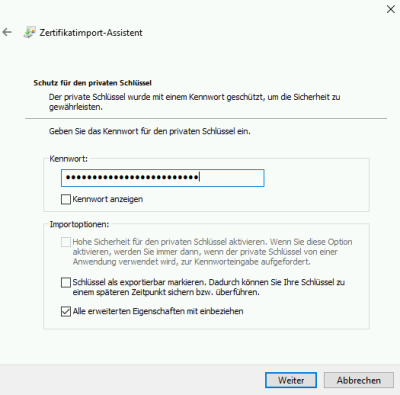


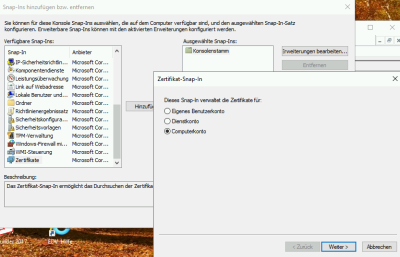
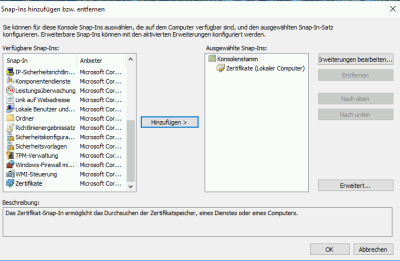
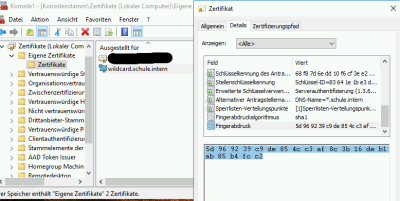

Zuweisen des Zertifikats zum RDP Dienst über Fingerprint - ohne Spaces und
ACHTUNG ohne non printable Charakters wenn Copy&Paste über
GUI passiert
-
wmic /namespace:\\root\cimv2\TerminalServices PATH Win32_TSGeneralSetting Set SSLCertificateSHA1Hash="5d969239c9de854cc3af8c3b16deb1ab85b4fcc2"
adconnect
adconnect - Seamless SSO aktivieren
#2022-09-06 cc: SSO activate / adconnect
\.registration.msappproxy.net
\.msappproxy.net
adconnect - troubleshoot Password Hash Synchronization
PS C:\WINDOWS\system32> Invoke-ADSyncDiagnostics -PasswordSync
========================================================================
= =
= Password Hash Synchronization General Diagnostics =
= =
========================================================================
AAD Tenant - GymnasiumNeusiedl.onmicrosoft.com
Password Hash Synchronization cloud configuration is enabled
False
AD Connector - foo.intern
Password Hash Synchronization is enabled
False
Password Hash Synchronization is NOT running for AD Connector: foo.intern
Would you like to RESTART password hash synchronization for AD Connector: foo.intern? [y/n]: y
Restarting...
Password Hash Sync Configuration for source "foo.intern" updated.
Password Hash Sync Configuration for source "foo.intern" updated.
Password Hash Synchronization is successfully restarted for AD Connector: foo.intern
Directory Partitions:
=====================
Directory Partition - foo.intern
False
False
False
Last successful attempt to synchronize passwords from this directory partition started at: 11/21/2022 10:36:00 AM UTC and ended at: 11/21/2022 10:36:05 AM UTC
Only Use Preferred Domain Controllers: False
Checking connectivity to the domain...
Domain "foo.intern" is reachable
Did you find Password Hash Sync General Diagnostics helpful? [y/n]:
adconnect - Synchronization Errors - DeletingCloudOnlyObjectNotAllowed
Benutzer die vom lokalen AD synchronisiert wurden , wurden gelöscht und wieder hergestellt um sie als „CloudOnly“ Benutzer zu administrieren / Er versucht weiterhin den User zu löschen stellt jedoch fest, dass es sich nun ob ein CloudOnly Objekt handelt - und löscht es daher nicht
Objekte die ausschließlich in der Cloud erstellt wurden besitzen keine „ImmutableId“ / daher auf $null setzen und die Synchronization Error verschwinden
-
Install-Module -Name MSOnline
Connect-MsolService
Set-MsolUser -UserPrincipalName UPN_USER -ImmutableId "$null"
echo $?
true
office 365 powershell
$minLength = 5 ## characters
$maxLength = 10 ## characters
$length = Get-Random -Minimum $minLength -Maximum $maxLength
$nonAlphaChars = 5
$password = [System.Web.Security.Membership]::GeneratePassword($length, $nonAlphaChars)
Set-MsolUserPassword -UserPrincipalName "davidchew@consoso.com" -NewPassword "pa$$word"
$adminUPN="admin@domain"
$userCredential = Get-Credential -UserName $adminUPN -Message "Type the password"
Connect-MsolService -Credential $userCredential
foreach ( $currentUser in Get-MsolUser -ReturnDeletedUsers -All )
{
$principalNameOld=$currentUser.UserPrincipalName
$principalNameNew=$principalNameOld.split("@")[0]+"-restore@domain"
write-Host "Original Name: $principalNameOld , New Name: $principalNameNew"
Restore-MSolUser -UserPrincipalName $principalNameOld -NewUserPrincipalName $principcalNameNew -AutoReconcileProxyConflicts
}
Import-Module -Name Microsoft.Online.SharePoint.PowerShell
$adminUPN="admin@domain"
$userCredential = Get-Credential -UserName $adminUPN -Message "Type the password."
Connect-SPOService -Url https://ORGANISATION-admin.sharepoint.com -Credential $userCredential
Get-SPODeletedSite -IncludePersonalSite
#office 365 administration specific
$adminUPN="admin@pdomain"
$userCredential = Get-Credential -UserName $adminUPN -Message "Type the password"
Connect-MsolService -Credential $userCredential
if(!$?)
{
write-Host "Could not Connect to Office 365 Service"
exit 2
}
#Mailserver and useraccount that will be abused for notification of the users e.g. Microsoft smtp
$smtpServer="smtp.office365.com"
$mailUsername="E-MAIL-ADDRESS"
$mailPassword="E-MAIL-PASSWORD"
$securePass = ConvertTo-SecureString $mailPassword -AsPlainText -Force
$mailAuth = New-Object System.Management.Automation.PSCredential ($mailUsername, $securePass)
$successRestore="false"
$successPassword="false"
$successMail="false"
$simplePassword="false"
foreach ( $currentUser in Get-MsolUser -ReturnDeletedUsers -All -Search "SEARCH_PATTERN_NAME_TESTING" )
{
#Get the old UserPrincipal Name that conains an e-mail
$principalNameOld=$currentUser.UserPrincipalName
#Construct the new UserPrincipal Name
$principalNameNew=$principalNameOld.split("@")[0]+"-restore@domain"
$mailSubject="Alter Account: "+$principalNameNew
Restore-MSolUser -UserPrincipalName $principalNameOld -NewUserPrincipalName $principalNameNew -AutoReconcileProxyConflicts
if($?)
{
$successRestore="true"
#OK User could be restore with new Principal Name - Let's create a SIMPLE password for him
$simplePassword = "AcD!"+(Get-Random -Minimum 1000000 -Maximum 9999999)
Set-MsolUserPassword -UserPrincipalName $principalNameNew -NewPassword $simplePassword
if($?)
{
$successPassword="true"
$mailBody="Hallo, `r`n deine alten Daten wie Mail/OneDrive erreichst du folgendermaßen:`r`n Login https://login.microsoftonline.com `r`n Benutzername: "+$principalNameNew+"`r`n Passwort: "+$simplePassword+"`r`n LG Das IT Team"
Send-MailMessage -smtpserver $smtpServer -Subject $mailSubject -From $mailUsername -Body $mailBody -Credential $mailAuth -to $principalNameOld -UseSsl
if($?)
{
$successMail="true"
}
else
{
$successMail="false"
}
}
else
{
$successPassword="false"
}
#Lets pause the process we don't know if we can send that many mails without being marked as Spam or something else
Start-Sleep -seconds (Get-Random -Minimum 2 -Maximum 10 )
}
else
{
$successRestore="false"
}
write-Output "$principalNameOld;$principalNameNew;$simplePassword;$successRestore;$successPassword;$successMail" | Tee-Object -Append -FilePath "C:\Scripts\restore.txt"
}
Install-Module MSOnline
$adminUPN="adminUPNt"
$userCredential = Get-Credential -UserName $adminUPN -Message "Type the password"
Connect-MsolService -Credential $userCredential
foreach ( $currentUser in Get-MsolUser -ReturnDeletedUsers -All )
{
$currentPrincipal = $currentUser.UserPrincipalName
write-host "Remove Principal: $currentPrincipal"
Remove-MsolUser -UserPrincipalName $currentUser.UserPrincipalName -RemoveFromRecycleBin -Force
if ($?)
{
write-host "Successfully removed $currentPrincipal "
}
else
{
write-host "ERROR removing $currentPrincipal "
}
}
poor mans windows advanced threat protection - intune
Getestet mit Windows 10 Pro (1909) / Windows 10 LTSC 2019
Intune vollverwaltet und teilverwaltete Geräte
Über Intune wird über die „Skripts“ Funktionalität ein Mechanismus deployed der analog zur Variante mit E-Mail / Kerberos Notifikationen eine Notifikation über einen Web Endpunkt triggered sobald ein Virus durch den Windows Defender gefunden wird
Server - Intune
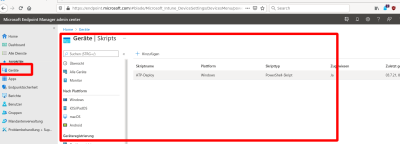
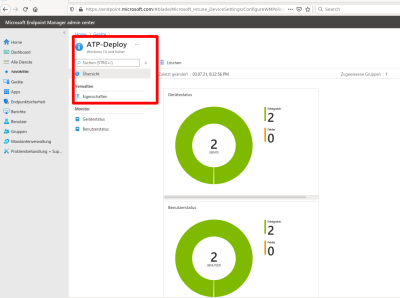
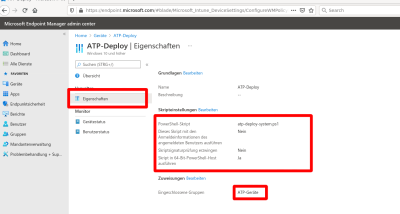
In diesem Punkt könnte es nochmals hochgeladen oder geändert werden /
Achtung nach dem Upload ist es nicht mehr möglich (ich habs noch nicht debugged) herauszufinden was eigentlich ausgeführt wird :) / Beim Hinzufügen handelt es sich um das gleiche User Interface / In meinem Fall möchte ich das Skript als
SYSTEM ausführen auf
64 Bit Maschinen / Bei Überprüfen lässt sich noch die Gruppe angeben für die das Skript Gültigkeit hat -
ATP-Geräte / Bei erneutem Hochladen eines geändert Skripts wird das Powershell Skript nochmals ausgeführt / Sonst wird es laut MS Doku nur
einmal ausgeführt / Skriptbeispiel:
atp-deploy-system.ps1.zip
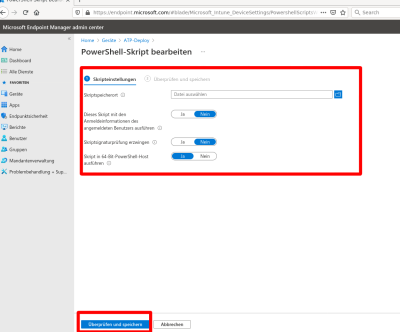

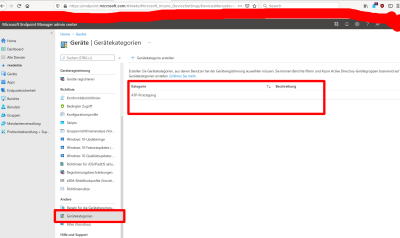
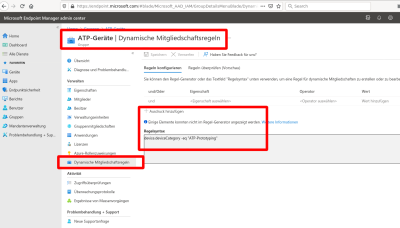
Endgerät - Workstations
Microsoft 365 Defender - ATP
Offenbar bekommen Bundesschulen aktuell der Anzahl der Lehrer A3 Lizenzen entsprechend für die ATP/MS 365 Defender Lizenzen
Geräte muss „geboarded“ werden d.h. Logik muss auf dem jeweiligen Client installiert werden
Keine MSI Datei sondern good old fashioned magic *.cmd / Batch File für Deployment von Microsoft
Anforderungen: Ich möchte ein Notification Mail bekommen wenn zB: Viren gefunden werden mit Gerätename und Virenfund/Malware Fund Info
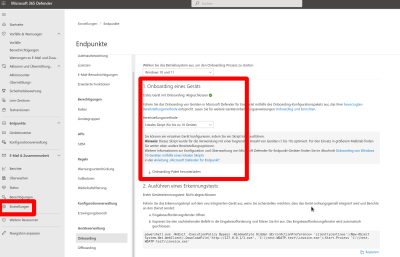

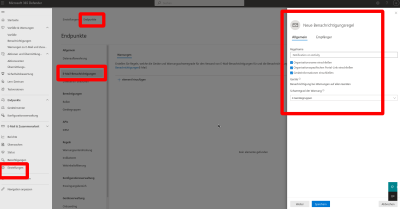
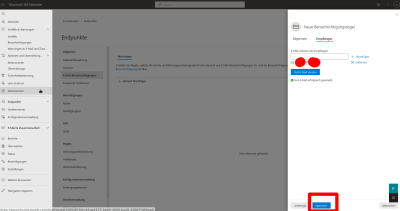

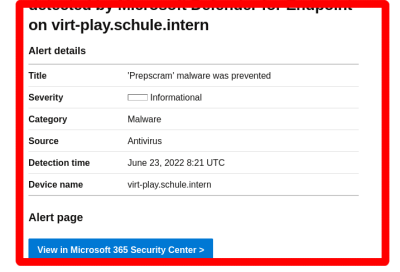
poor mans windows advanced threat protection - lokal
-
Task Definition und Scripts für
C:\Scripts\ ,
Achtung Berechtigungen bei E-Mail Versand für Standard- User entfernen
poor-mans-windows-atp.zip
Update-MpSignature
Start-MpScan -ScanType CustomScan -ScanPath G:\
poor mans harddisk notification check - lokal
-
Aus aktuellem Anlass - da 200GB SSD Platten / NVMEs im Schulbereich zu klein sind / Wenn lokale Profile verwendet werden und zahlreiche User sich auf dem Gerät einloggen
Enthält ein Powershell Skript (C:\Scripts\*.ps1) , das beim Start (Aufgabe *.xml) ausgeführt wird / Durch das Batch file (*.bat) kann es als Computerrichtlinie deployed werden
Wenn die Geräte unter 16GB frei haben oder ein Festplattenproblem / Dateisystem Problem festgestellt wird , wird ein POST Request an das Support System getriggered, das eine Mail an den zuständigen Betreuer versendet
-
Beispiel Mail:
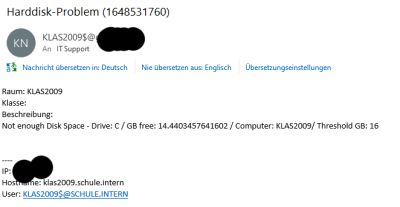
poor mans updates available check - lokal
APC-USB-USV remote server shutdown
Gesetzt folgendem Fall - eine APC USV hängt per USB an einem Server und es wird ein Zweiter hinzugefügt und an der USV angehängt / Für diese USV Reihe existiert jedoch keine Management Interface Karte , daher weiß der „remote“ Server nicht wann die USV aktiv wird bei Stromausfall
Auf dem „Host“ Server der per USB mit der USV verbunden ist werden in der Aufgabenplanung Tasks (batch Files) gestartet um den zweiten Server bei Bedarf herunterzufahren
Konfiguration „Host“ Server der mit USV verbunden ist
Achtung USV wird als „Akku“ angezeigt - das Skript liest die aktuelle Akku Ladung raus, fällt das Ladeniveau unter einen bestimmten threshold zB: 30% wird ein event getriggered , das beim zweiten Job dazu führt dass das Shutdown Skript ausgeführt wird
-
-
In
scripts.zip befindet sich auch eine
powershell Variante zum Herunterfahren - hier müsste bei der zu startenden Applikation
powershell.exe gewählt werden + Parametern könnte Ausführung zB: folgendermaßen sein
powershell.exe -ExecutionPolicy Bypass c:\scripts_shutdown\shutdown-server.ps1
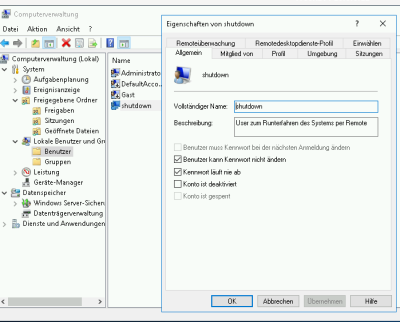
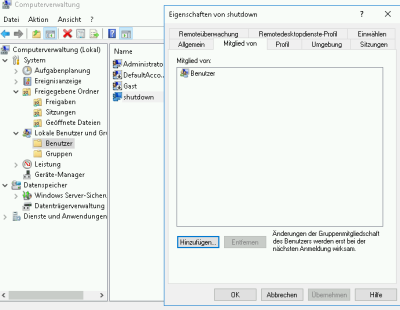


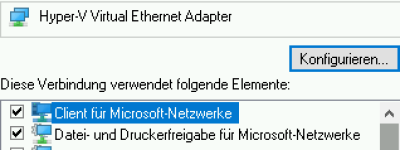
Software RAID1 mit Windows Boardmitteln
Boot Treiber auf AHCI stellen
Getestet auf Windows 2012r2 / HP Microserver gen 8 B120I Software RAID
Umstellung von B120I RAID auf AHCI Modus
Nach der Umstellung im abgesichterten Modus starten & aus dem abgesicherten Modus neu booten und funktioniert :)
-
Run Registry Editor.
To do it, press Win + R and type in the command regedit.
Go to the section HKEY_LOCAL_MACHINE\ SYSTEM\ CurrentControlSet\ Services\ iaStorV
Regedit. Go to the section HKEY_LOCAL_MACHINE\ SYSTEM\ CurrentControlSet\ Services\ iaStorV
Double-click on Start element and set its value to 0 (zero).
Regedit. Double-click on Start element and set its value to 0 (zero).
In the next section, HKEY_LOCAL_MACHINE\ SYSTEM\ CurrentControlSet\ Services\ iaStorAV\ StartOverride set the zero value for the element 0.
Regedit. HKEY_LOCAL_MACHINE\ SYSTEM\ CurrentControlSet\ Services\ iaStorAV\ StartOverride set the zero value for the element 0
In the section HKEY_LOCAL_MACHINE\ SYSTEM\ CurrentControlSet\ Services\ storahci set the value to 0 (zero) for Start element.
Regedit. HKEY_LOCAL_MACHINE\ SYSTEM\ CurrentControlSet\ Services\ storahci set the value to 0 (zero) for Start element.
In the subsection, HKEY_LOCAL_MACHINE\ SYSTEM\ CurrentControlSet\ Services\ storahci\ StartOverride set the zero value for the element 0.
In our case, there is nothing to see, but you will see it, if AHCI has not been enabled yet.
Close Registry Editor.
Fileserver Deduplizierung
Wenn ausreichend I/O und CPU Power vorhanden kann die Deduplizierung genutzt werden um Speicher zu gewinnen / Achtung Wenn das Dateisystem fehlerhaft wird oder einzelne Dateien beschädigt werden in Folge alle betroffenen beschädigt da die Deduplizierung die redundanten Daten nur einmal speichert - daher auch der Speichergewinn - you have been warned :)
In der Praxis konnte ich auf einem Fileserver mit >1.5 Mio Dateien von 800GB auf 2TB (!) Speicher gewinnen
Getestet auf einem Windows 2016 (hyper V Hostsystem mit 2CPUs u. RAID10 4TB SSDs / hyper v Gast / Generation 2 / 2 CPUs / dynamischen RAM bis zu 8GB)
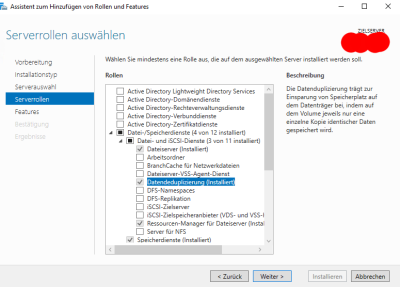
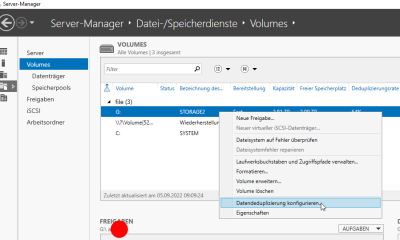


Fileserver Migration von Shares
Backup and Restore of Share Permissions
To backup share permissions, export the Shares registry key.
Open Regedit to the following location:
HKLMSYSTEMCurrentControlSetServicesLanmanServerShares
Right-click the Shares registry key and select Export. Give it a file name such as shareperms.reg.
When you want to restore the permissions, double-click shareperms.reg to import it back into the registry.
Use the Reg tool to backup the registry key from the command line:
reg export HKLMSYSTEMCurrentControlSetServicesLanmanServerShares shareperms.reg
If you need to restore it at some point, just run:
reg import shareperms.reg
Backup and Restore of NTFS Permissions
Use this command to backup NTFS permissions:
icacls d:data /save ntfsperms.txt /t /c
The /T switch allows it to get subfolder permissions too. The /C switch allows it to continue even if errors are encountered (although errors will still be displayed).
Use this command to restore them:
icacls d: /restore ntfsperms.txt
Note that in the command to save the permissions, I specified the target folder D:Data, but when I restored them, I specified just D: as the target. Icacls is a little funky like that, and here’s why.
If you open the text file with the exported permissions (ntfsperms.txt in the above example), you’ll see that Icacls uses relative paths (in bold below). Underneath the relative paths are the permissions for the folders in Security Descriptor Definition Language (SDDL) format.
data
D:AI(A;ID;FA;;;BA)(A;OICIIOID;GA;;;BA)(A;ID;FA;;;SY)(A;OICIIOID;GA;;;SY)(A;OICIID;0x1200a9;;;BU)(A;ID;0x1301bf;;;AU)(A;OICIIOID;SDGXGWGR;;;AU)
datafolder1
D:AI(A;ID;FA;;;BA)(A;OICIIOID;GA;;;BA)(A;ID;FA;;;SY)(A;OICIIOID;GA;;;SY)(A;OICIID;0x1200a9;;;BU)(A;ID;0x1301bf;;;AU)(A;OICIIOID;SDGXGWGR;;;AU)
datafolder2
D:AI(A;ID;FA;;;BA)(A;OICIIOID;GA;;;BA)(A;ID;FA;;;SY)(A;OICIIOID;GA;;;SY)(A;OICIID;0x1200a9;;;BU)(A;ID;0x1301bf;;;AU)(A;OICIIOID;SDGXGWGR;;;AU)
Had I specified D:Data in the command to restore the permissions, it would have failed looking for a D:DataData folder:
D:>icacls d:data /restore perms.txt
d:datadata: The system cannot find the file specified.
Successfully processed 0 files; Failed processing 1 files
You might think specifying D: as the target in the restore command may somehow mess up the permissions on other folders at that level, but as you can see from the ntfsperms.txt output file, it only has information about the Data folder and subfolders, so that is all it will change.
– Craig Landis
Gestartet: Donnerstag, 17. Mai 2018 11:54:04
Quelle : \\QUELLE\Share
Ziel : ZIELLAUFWERK:\Share
Dateien : *.*
Optionen: *.* /TEE /S /E /DCOPY:DA /COPY:DATS /SECFIX /PURGE /MIR /R:5 /W:30
AD Datenbank Repair - Versuche
Microsoft :
https://support.microsoft.com/de-at/help/258062.
Datenbank ad repair
https://www.tecchannel.de/a/active-directory-datenbank-pflegen-und-reparieren,435528,5
---
Datenbank repair
https://www.tecchannel.de/a/active-directory-sichern-wiederherstellen-und-warten,2040204,6
Praxis für Windows Server 2012 und 2012 R2
Active Directory - sichern, wiederherstellen und warten
Artikel empfehlen:
Kommentare & Drucken:
Autor:
08.04.2014Von Thomas Joos (Autor)
Active-Directory-Datenbank reparieren
Zuweilen kann es vorkommen, dass die Active-Directory-Datenbank nicht mehr funktioniert. Gehen Sie bei einem solchen Problem folgendermaßen vor:
Starten Sie den Server im Verzeichnisdienstwiederherstellung-Modus, oder beenden Sie Active Directory mit net stop ntds.
Öffnen Sie eine Befehlszeile und starten Ntdsutil.exe.
Geben Sie anschließend den Befehl activate instance ntds ein.
Geben Sie files ein, um zu file maintenance zu gelangen.
Geben Sie integrity ein, um einen Integritätstest der Datenbank durchzuführen. Wenn dieser Test eine Fehlermeldung anzeigt, können Sie versuchen, die Datenbank in Ntdsutil.exe zu retten.
Verlassen Sie mit quit die file maintenance, aber bleiben Sie in der Oberfläche von Ntdsutil.exe.
Geben Sie den Befehl semantic database analysis ein.
Geben Sie zunächst den Befehl verbose on ein, damit Sie detaillierte Informationen erhalten.
Geben Sie als Nächstes den Befehl go fixup ein.
CSV - Bulk User Batch Import mit Passwort definiert für alle (create_user.bat)
@echo off
set pass=PASSWORD_ALLE_USER
set scriptpath=SCRIPT.BAT
set list_users=liste.txt
set error_list=user-error.csv
set success_list=user-success.csv
echo accountUsername;gruppe;beschreibung> %error_list%
echo accountUsername;gruppe;beschreibung> %success_list%
for /f "tokens=1,2 delims=;" %%f in (%list_users%) DO (
net user %%f 1> nul 2>&1
if %ERRORLEVEL% EQU 2 (
net user %%f %pass% /add /active:yes /passwordchg:yes /scriptpath:%scriptpath% /Y /DOMAIN 1> nul 2>&1
if %ERRORLEVEL% EQU 2 (
echo Successfully created: %%f
net group %%g 1> nul 2>&1
if %ERRORLEVEL% EQU 2 ( net group %%g /add /DOMAIN 1> nul 2>&1 )
net group %%g %%f /ADD /DOMAIN 1> nul 2>&1
if %ERRORLEVEL% EQU 2 ( echo Successfully added: %%f to group: %%g
echo %%f;%%g;Complete Success >> %success_list% ) else ( echo FAIL: Couldn't add %%f to group %%g
echo %%f;%%g;User created couldn't be added to group >> %error_list%)
) else ( echo FAIL: Couldn't add user %%f
echo "%%f;%%g;User couldn't be added" >> %error_list% )
) else ( echo FAIL: User: %%f already available manual intervention needed
echo %%f;%%g;User already available >> %error_list% )
)
pause
CSV - Bulk Prüfungs User Batch import (create_user_test_csv.bat)
Es existiert eine GPO die für User mit der Mitgliedschaft zu zB: pruefung aktiv wird
Achtung 2xMal ausführen - Vielleicht Environment beim 1. Mail Ausführung nicht korrekt / ERRORLEVEL ?
CSV Datei im gleichen verzeichnis - user-liste-test.txt mit Liste der zu erstellenden Benutzernamen und der Gruppenzugehörigkeit
user01;pruefung
user02;pruefung
user03;pruefung
@echo off
set list_users=user-liste-test.txt
set error_list=user-error.csv
set success_list=user-success.csv
echo accountUsername;gruppe;beschreibung > %error_list%
echo accountUsername;gruppe;passwort;beschreibung > %success_list%
for /f "tokens=1,2 delims=;" %%f in (%list_users%) DO (
net user %%f 1> nul 2>&1
if %ERRORLEVEL% EQU 2 (
setlocal EnableDelayedExpansion
set /a pass="!RANDOM!+10000000+!RANDOM!*1000"
net user %%f !pass! /add /active:yes /passwordchg:no /Y /DOMAIN 1> nul 2>&1
if %ERRORLEVEL% EQU 2 (
echo Successfully created: %%f
net group %%g 1> nul 2>&1
if %ERRORLEVEL% EQU 2 ( net group %%g /add /DOMAIN 1> nul 2>&1 )
net group %%g %%f /ADD /DOMAIN 1> nul 2>&1
if %ERRORLEVEL% EQU 2 ( echo Successfully added: %%f to group: %%g
echo %%f;%%g;!pass!;Complete Success >> %success_list% ) else ( echo FAIL: Couldn't add %%f to group %%g
echo %%f;%%g;!pass!;User created couldn't be added to group >> %error_list%)
) else ( echo FAIL: Couldn't add user %%f
echo "%%f;%%g;User couldn't be added" >> %error_list% )
) else ( echo FAIL: User: %%f already available manual intervention needed
echo %%f;%%g;User already available >> %error_list% )
)
pause
user-error.csv user-success.csv werden erstellt im gleichen Verzeichnis - in der success Datei befindet sich auch das „generierte“ Passwort für die Prüfungsbenutzer
Die User selbst werden bei einem AD Server in der OU „USERS“ abgelegt
Ordner kopieren (per GPO oder psexec)
-
Kann auch als GPO (Computer Startup) genutzt werden / Parameter über Reiter „Parameter“ hinzufügen
Achtung /mir spiegel alles vom Ursprung , die Parameter immer überprüfen!!
echo off
set fromLocation=%1
set toLocation=%2
set toLogfile=%3
IF %1.==. GOTO Usage
IF %2.==. GOTO Usage
IF %3.==. GOTO Usage
if exist "%toLogFile%" goto Ende
if not exist "%toLocation%" mkdir %toLocation%
robocopy /MIR /R:2 /W:2 %fromLocation% %toLocation%
if %ERRORLEVEL% EQU 0 echo "finished_successfully" > %toLogfile%
exit 0
:Usage
echo "%0 fromLocation toLocation logFile
echo ---------------------------
echo Beispielaufruf: %0 \\file\Software\ C:\Software\ C:\copy_software.txt
exit 2
:Ende
exit 0
NTFS Ownership ändern
https://stackoverflow.com/questions/20673599/change-owner-and-permissions-on-folder#20676221
To make an addition to permissions and:
icacls.exe d:\test /setowner domain\username
To set ownership. Other options of interest from icacls /?:
/T indicates that this operation is performed on all matching
files/directories below the directories specified in the name.
/C indicates that this operation will continue on all file errors.
Error messages will still be displayed.
NTFS Volume verkleinern
To shrink a basic volume using a command line
Open a command prompt and type diskpart.
At the DISKPART prompt, type list volume. Note the number of the simple volume you want to shrink.
At the DISKPART prompt, type select volume <volumenumber>. Selects the simple volume volumenumber you want to shrink.
At the DISKPART prompt, type shrink [desired=<desiredsize>] [minimum=<minimumsize>]. Shrinks the selected volume to desiredsize in megabytes (MB) if possible, or to minimumsize if desiredsize is too large.
DHCP Server auslesen ohne powershell
Once i had the file in csv, i simply imported it into an excel sheet using spaces as the delimiter and hey presto a lovely little reservation report:
Same rules as always, dont run it from a UNC path, copy it local to the DHCP server and run it there.
netsh dhcp server dump >> reservationdump.txt
find “Add reservedip” reservationdump.txt >> reservations.csv
You can download the script as is here:
This script almost works as well. It currently lists extra clients. Some regex magic with the find command parameters could fix this. Save to to a .cmd file and specify your dhcppserver and a valid scope.
for /f "skip=4 delims=: tokens=2" %%a in ('nslookup %1') do set IP=%%a
netsh dhcp server \\ourdhcpsvr scope 192.168.1.0 show clients|findstr "%IP%"
Output should look like this
172.16.19.78 - 255.255.248.0 - c6-33-5f-cb-a7-a5 -4/25/2017 8:26:07 AM -D
Computer Liste auslesen aus AD dsquery
Say you want to find out which computers will be affected if you link a GPO to a certain OU. You could run the following dsquery command:
dsquery computer "OU=IT,DC=contoso,DC=com" -o rdn
1
dsquery computer "OU=IT,DC=contoso,DC=com" -o rdn
The result would be a list of computer names. If you omit the -o switch with the rdn value, you receive a list of Distinguished Names.
Windows generell Dateien löschen
The best I've found is a two line batch file with a first pass to delete files and outputs to nul to avoid the overhead of writing to screen for every singe file. A second pass then cleans up the remaining directory structure:
del /f/s/q foldername > nul
rmdir /s/q foldername
Windows home-verzeichnisse erstellen
#####################################################################
# AUTHOR : Victor Ashiedu
# DATE : 01-10-2014
# WEB : iTechguides.com
# BLOG : iTechguides.com/blog
# COMMENT : This PowerShell script creates a home folder for all users in Active Directory
# (Accessed only by the user) If this script was helpful to you,
# please take time to rate it at: http://gallery.technet.microsoft.com/PowerShell-script-to-832e08ed
#####################################################################
############################VERY IMPORTANT:##########################
#before you run this script enure that you read the ReadMe text file
######################################################################
#This script has the following functionalities:#######################
#1 Creates a persoanl (home folder) for all AD users
#2 Provides option to create users folders as DisplayName or sAMAccountname (Log on name)
#3 Grants each users "Full Control" to his or her folder
#4 Maps the users folder as drive 'H' (Configured via AD Users property,
#5 Ensures that users canot access another user's folder
#######################################################################
#######################################################################
#BEGIN SCRIPT
#Define variable for a server to use with query.
#This might be necessary if you operate in a Windows Server 2003 Domain
# and have AD web services installed in a particular DC
$ADServer = ad.schule.intern'
#Get Admin accountb credential
$GetAdminact = Get-Credential
#Import Active Directory Module
Import-Module ActiveDirectory
#define search base - the OU where you want to
# search for users to modify. you can define the
#domain as your searchbase
#add OU in the format OU=OU 1,Users OU,DC=domain,DC=com
$searchbase = "OU=Benutzer,DC=DOMAIN,DC=COM"
#Search for AD users to modify
$ADUsers = Get-ADUser -server $ADServer -Filter * -Credential $GetAdminact -searchbase $searchbase -Properties *
ForEach ($ADUser in $ADUsers)
{
#$ADUser -properties SamAccountName | Format-List
#$ADUser | Select-Object -Property SamAccountName,homedirectory | Format-List
[string]$pathHomeDirectory = $( $ADUser.homedirectory )
if ( -not ( Test-Path $pathHomeDirectory ) )
{
write-host("--------");
write-host("Home Directory not found: "+$path);
write-host("AccountName: "+$ADUser.samAccountName);
#Create Missing directory
$homeShare = New-Item -path $pathHomeDirectory -ItemType Directory -force -ea Stop
$acl = Get-Acl $homeShare
$FileSystemRights = [System.Security.AccessControl.FileSystemRights]“Modify“
$AccessControlType = [System.Security.AccessControl.AccessControlType]::Allow
$InheritanceFlags = [System.Security.AccessControl.InheritanceFlags]“ContainerInherit, ObjectInherit“
$PropagationFlags = [System.Security.AccessControl.PropagationFlags]“InheritOnly“
$AccessRule = New-Object System.Security.AccessControl.FileSystemAccessRule ($ADUser.SID, $FileSystemRights, $InheritanceFlags, $PropagationFlags, $AccessControlType)
$acl.AddAccessRule($AccessRule)
Set-Acl -Path $homeShare -AclObject $acl -ea Stop
Write-Host („HomeDirectory created at {0}“ -f $homeShare)
write-host("--------");
}
}
#END SCRIPT
Windows 2016 Ressourcen Manager f. Quotas
Windows 2012r2 to Windows 2016 Upgrade
Hardware: HP ML350 Gen9
Specials: Hyper-V Server - Rolle
Alle Hyper-V Gastsysteme herunter fahren / Nach Reboot manuell einzeln Hochfahren / Netzwerkkonfiguration sichern zum Vergleichen ala. ipconfig /all > C:\network_config.txt / Konfiguration der Hyper-V Switches sichern zum Vergleichen nach dem Upgrade
Vor dem Upgrade aktuellen Smart Array P440ar Treiber installieren - nochmals in Windows 2012r2 reinbooten
Windows 2016 Server ISO entpacken & setup.exe ausführen / Microsoft Recommendations zur Kenntnis nehmen mit Hinweisen für komplette Neuinstallation
Upgrades für 2016 erst nach der Installation durchführen
Hyper-V Gastsysteme herunter fahren & Konfigurations - Versionen upgraden
Windows 2012r2 to Windows 2019 Upgrade
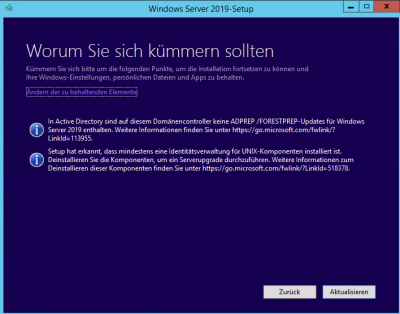
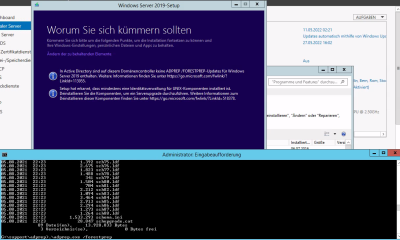

Achtung Adconnect V1.x läuft nicht mehr auf 2019 / WDS startet nicht mehr - Verzeichnisse für ARM anlegen dann funktionierts
Achtung Update hängt bei 91% bei minimaler IO Tätigkeit und minimaler CPU Auslastung / nach >1 Stunde wurde das Upgrade trotzdem fertig gestellt
Achtung nach Bereinigung dieser Issues kommt noch eine Überprüfung der vorhandenen Programme auf Kompatiblität - sollten hier Programme auftauchen die
nicht kompatibel sind
müssen die Programme entfernt bzw. bereinigt werden sonst ist das Setup stuck / Mit
https://docs.microsoft.com/en-us/sysinternals/downloads/procmon lässt sich überprüfen welche Checks durchgeführt werden - Microsoft ruttelt hier alle Laufwerke durch und sucht nach „hardcoded“ Verzeichnisnamen zB: „Update Services“
Windows 2012r2 Powershell TLS troubles
Install-PackageProvider -Name NuGet -MinimumVersion 2.8.5.201 -Force
WARNUNG: MSG:UnableToDownload
«https://go.microsoft.com/fwlink/?LinkID=627338&clcid=0x409» «»
WARNUNG: Die Liste der verfügbaren Anbieter kann nicht heruntergeladen werden.
Überprüfen Sie Ihre Internetverbindung.
WARNUNG: Es kann kein Download von URI
"https://go.microsoft.com/fwlink/?LinkID=627338&clcid=0x409" nach ""
durchgeführt werden.
Install-PackageProvider : Für die angegebenen Suchkriterien für Anbieter
"NuGet" wurde keine Übereinstimmung gefunden. Der Paketanbieter erfordert das
TLS V1 Alert Errors - Wireshark
PS C:\Users\administrator.SCHULE.000> [System.Net.ServicePointManager]::Security
Protocol = [System.Net.SecurityProtocolType]::Tls12
PS C:\Users\administrator.SCHULE.000> Install-PackageProvider -Name NuGet -Minim
umVersion 2.8.5.201 -Force
Name Version Source Summary
---- ------- ------ -------
nuget 2.8.5.208 https://onege... NuGet provi...
Forefront 2010
www.jodrik.nl/uninstalling-forefront-2010-from-server-2012-after-server-upgrade/
-> Forefront 2010 deinstallieren - Kompatiblität für Windows 7 bei setup.exe aktivieren in den Attributen
-> C:\Program Files\Microsoft Security Client>setup.exe /x
Windows 2012r2 Azure AD High Load
Stop the Azure AD Connect Health Sync Monitor Service
The first option is to stop the Azure AD Connect Health Sync Monitor service and set it to manual until the updated utility is released.
Click on Start and search for Services
Find the Azure AD Connect Health Sync Monitor service
Right click on it and click Stop
Right click on the same service and go to Properties
Change the Startup Type to Manual
GPO 1607 - Templates Problem
https://support.microsoft.com/de-at/help/3077013/microsoft-policies-sensors-windowslocationprovider-is-already-defined
Methode 2
Löschen Sie die Dateien „LocationProviderADM.admx“ und „LocationProviderADM.adml“, und ändern Sie „Microsoft-Windows-Geolocation-WLPAdm.admx“ und „Microsoft-Windows-Geolocation-WLPAdm.adml“ in die richtigen Namen.
Szenario 1
Löschen Sie die Dateien „LocationProviderADM.admx“und „LocationProviderADM.adml“ aus dem zentralen Speicher.
Benennen Sie „Microsoft-Windows-Geolocation-WLPAdm.admx“ um in „LocationProviderADM.admx“.
Benennen Sie „Microsoft-Windows-Geolocation-WLPAdm.adml“um in „LocationProviderADM.adml“.
Szenario 2
Löschen Sie die Datei „Microsoft-Windows-Geolocation-WLPAdm.admx“ aus dem lokalen Speicher. Der Pfad zum lokalen Richtlinienspeicher lautet „C:\Windows\PolicyDefinitions“.
Windows Update Cli
wuauclt /DetectNow
Jetzt nach Updates suchen.
wuauclt /ReportNow
Nicht berichtete Probleme an Microsoft melden.
wuauclt /ShowSettingsDialog
Windows-Update-Einstellungen anzeigen.
wuauclt /ResetAuthorization
Update-Komponenten zurücksetzen.
wuauclt /ResetEulas
Bestätigung der Lizenzverträge erneut einholen.
wuauclt /ShowWU
Windows-Update anzeigen.
wuauclt /ShowWindowsUpdate
Windows-Update anzeigen.
wuauclt /SelfUpdateManaged
wuauclt /SelfUpdateUnmanaged
wuauclt /UpdateNow
Verfügbare Updates installieren.
wuauclt /ShowWUAutoScan
wuauclt /ShowFeaturedUpdates
wuauclt /ShowOptions
wuauclt /ShowFeaturedOptInDialog
wuauclt /DemoUI
C:\Users\christian.czeczil>powershell
Windows PowerShell
Copyright (C) 2016 Microsoft Corporation. Alle Rechte vorbehalten.
PS C:\Users\christian.czeczil> Get-WindowsUpdateLog
Converting C:\Windows\logs\WindowsUpdate into C:\Users\christian.czeczil\Desktop\WindowsUpdate.log ...
Verzeichnis: C:\Users\CHRIST~1.CZE\AppData\Local\Temp\WindowsUpdateLog
Mode LastWriteTime Length Name
---- ------------- ------ ----
d----- 04.07.2018 11:31 SymCache
Eingabe
----------------
Datei(en):
C:\Windows\logs\WindowsUpdate\WindowsUpdate.20180626.173314.738.1.etl
C:\Windows\logs\WindowsUpdate\WindowsUpdate.20180626.190715.973.1.etl
C:\Windows\logs\WindowsUpdate\WindowsUpdate.20180626.204114.477.1.etl
C:\Windows\logs\WindowsUpdate\WindowsUpdate.20180626.221514.107.1.etl
Standardmäßig verzeichnet der Windows Update-Client sämtliche Transaktionsinformationen in folgender Protokolldatei:
%windir%\Windowsupdate.log
Wenn auf der Microsoft Windows Update-Website oder vom Dienst für automatische Updates eine Fehlermeldung ausgegeben wird, können Sie das Problem mithilfe der in der Protokolldatei "Windowsupdate.log" enthaltenen Informationen beheben.
CMD (als Admin)
net stop wuauserv
net stop bits
rd /s /q %windir%\SoftwareDistribution
del %windir%\WindowsUpdate.log
net start wuauserv
net start bits
wuauclt /resetauthorization /detectnow
wuauclt /reportnow
UsoClient.exe
StartScan
StartDownload
StartInstall
RestartDevice
GPO - interaktives Batch Skript
Sollten die User bei einem User Skript befragt werden müssen d.h. interaktiv
In diesem Zweig befinden sich die entsprechenden GPO Einstellungen um batch Skript sichtbar zu machen Anweisungen in Anmeldeskripts während der Ausführung anzeigen
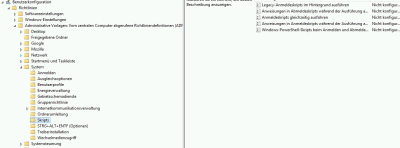
echo Hast du die Lizenz eingegeben und sie wurde akzeptiert ? ( j/n )
:Frage
SET /p wahl=
if /i not '%wahl%' == 'n' (if /i '%wahl%' == 'j' (goto Ja ) ) else goto Nein
if defined wahl ECHO Bitte mit j fuer Ja oder n fuer Nein. antworten. Vielen Dank & goto Frage
:Nein
goto Ende
:Ja
echo success > C:\license.log
:Ende
GPO für bestimmte Windows Versionen (WMI)
To create a WMI filter that queries for a specified version of Windows
Open the Group Policy Management console.
In the navigation pane, expand Forest: YourForestName, expand Domains, expand YourDomainName, and then click WMI Filters.
Click Action, and then click New.
In the Name text box, type the name of the WMI filter.
Note: Be sure to use a name that clearly indicates the purpose of the filter. Check to see if your organization has a naming convention.
In the Description text box, type a description for the WMI filter. For example, if the filter excludes domain controllers, you might consider stating that in the description.
Click Add.
Leave the Namespace value set to root\CIMv2.
In the Query text box, type:
syntax
select * from Win32_OperatingSystem where Version like "6.%"
This query will return true for devices running at least Windows Vista and Windows Server 2008. To set a filter for just Windows 8 and Windows Server 2012, use "6.2%". For Windows 10 and Windows Server 2016, use "10.%". To specify multiple versions, combine them with or, as shown in the following:
syntax
... where Version like "6.1%" or Version like "6.2%"
To restrict the query to only clients or only servers, add a clause that includes the ProductType parameter. To filter for client operating systems only, such as Windows 8 or Windows 7, use only ProductType="1". For server operating systems that are not domain controllers, use ProductType="3". For domain controllers only, use ProductType="2". This is a useful distinction, because you often want to prevent your GPOs from being applied to the domain controllers on your network.
The following clause returns true for all devices that are not domain controllers:
syntax
... where ProductType="1" or ProductType="3"
The following complete query returns true for all devices running Windows 10, and returns false for any server operating system or any other client operating system.
syntax
select * from Win32_OperatingSystem where Version like "10.%" and ProductType="1"
The following query returns true for any device running Windows Server 2016, except domain controllers:
syntax
select * from Win32_OperatingSystem where Version like "10.%" and ProductType="3"
Click OK to save the query to the filter.
Click Save to save your completed filter.
Hyper-V Storage Offline
Besonders erfreulich wenn der Server (2012r2) neu bootet und das Storage Volume nicht online nimmt obwohl es ein lokales RAID Controller Volume ist / auf dem alle virtuellen Maschinen liegen
SAN Policy wurde auf „OnlineAll“ geändert
https://support.purestorage.com/Solutions/Microsoft_Platform_Guide/aaa_Quick_Setup_Steps/Step_04
Microsoft DiskPart-Version 6.3.9600
Copyright (C) 1999-2013 Microsoft Corporation.
Auf Computer: FOO
DISKPART> san
SAN-Richtlinie : Offline - Freigegeben
DISKPART> SAN Policy=OnlineAll
Die SAN-Richtlinie für das aktuelle Betriebssystem wurde erfolgreich geändert.
DISKPART>
Hyper-V Storage Migration
Hyper-V Replikation
https://www.andysblog.de/windows-hyper-v-replikat-uebersicht-anleitung-fuer-den-arbeitsgruppenbetrieb
Achtung CRL Check deaktivieren !!!
Achtung kann auch sein KEIN FQDN Name sondern nur über hostname replizieren !!!
Aktivieren der Replikation über Powershell cli:
Enable-VMReplication -VmName VM_NAME -ReplicaServerName FOFOFOFO -ReplicaServerPort fofofo -AuthenticationType Certificate -CertificateFingerprint FINGERPRINT
Anleitung zu Hyper-V-Replikat in Arbeitsgruppen oder bei stand-alone Servern
Diese Anleitung bezieht sich auf zwei stand-alone Hyper-V Server 2012. Jeder Host ist in einer anderen Arbeitsgruppe. Für die Replikation kommt in dieser Konstellation nur die Authentifizierung mit Zertifikaten in Frage. Der Einfachheit halber werden selbstsignierte Zertifikate verwendet. Neben den zwei Hyper-V Servern wird eine Windows 8 Arbeitsstation für die Einrichtung und Verwaltung benötigt.
Windows 8
Windows Software Development Kit (SDK) for Windows 8 herunterladen und installieren. Aus dem SDK wird das Tool „makecert.exe“ benötigt um die Zertifikate für die Hyper-V Hosts erstellen zu können. Dieses Tool auf die Hyper-V Hosts kopieren.
Unter „Systemsteuerung – Programme und Funktionen – Windows-Funktionen aktivieren und deaktivieren – Hyper-V“ die „Hyper-V-Verwaltungstools“ aktivieren.
HVRemote herunterladen.
In einer Eingabeaufforderung mit erhöhten Rechten folgende Befehle ausführen:
cscript hvremote.wsf /anondcom:grant
cmdkey /add:HYPER-V-COMPUTERNAME /user:HYPER-V-COMPUTERNAME\Administrator /pass
Der cmdkey-Befehl muss für jeden Hyper-V angepasst und ausgeführt werden.
Hyper-V Server 2012
Auf allen Hyper-V Hosts muss die Remoteverwaltung aktiviert sein. Ferner sollten statische IP-Adressen konfiguriert werden. Damit die Firewall den Replikationsverkehr durchlässt muss folgender Befehl pro Host ausgeführt werden:
netsh advfirewall firewall set rule group="Hyper-V-Replikat - HTTPS" new enable=yes
Nachfolgend wird von einem primären und einem recovery Host ausgegangen. Bei den Befehlen muss „<FQDN>“ pro Host angepasst werden, z.B. „host1.test.local“.
Auf dem primären Host folgende Befehle ausführen:
makecert -pe -n "CN=PrimaryTestRootCA" -ss root -sr LocalMachine -sky signature -r "PrimaryTestRootCA.cer"
makecert -pe -n "CN=<FQDN>" -ss my -sr LocalMachine -sky exchange -eku 1.3.6.1.5.5.7.3.1,1.3.6.1.5.5.7.3.2 -in "PrimaryTestRootCA" -is root -ir LocalMachine -sp "Microsoft RSA SChannel Cryptographic Provider" -sy 12 PrimaryTestCert.cer
Auf dem recovery Host folgende Befehle ausführen:
makecert -pe -n "CN=RecoveryTestRootCA" -ss root -sr LocalMachine -sky signature -r "RecoveryTestRootCA.cer"
makecert -pe -n "CN=<FQDN>" -ss my -sr LocalMachine -sky exchange -eku 1.3.6.1.5.5.7.3.1,1.3.6.1.5.5.7.3.2 -in "RecoveryTestRootCA" -is root -ir LocalMachine -sp "Microsoft RSA SChannel Cryptographic Provider" -sy 12 RecoveryTestCert.cer
Nun muss die „*.CA.cer“-Datei auf den jeweils anderen Host kopiert werden. Auf dem primären Host wird das Zertifikat mit dem Befehl
certutil -addstore -f Root "RecoveryTestRootCA.cer"
importiert. Auf dem recovery Host wird das Zertifikat mit dem Befehl
certutil -addstore -f Root "PrimaryTestRootCA.cer"
importiert. Abschließend muss auf beiden Hosts der Befehl
reg add "HKLM\SOFTWARE\Microsoft\Windows NT\CurrentVersion\Virtualization\Replication" /v DisableCertRevocationCheck /d 1 /t REG_DWORD /f
ausgeführt werden.
Damit sind die Voraussetzungen für Hyper-V-Replikat erfüllt. Nun kann für alle gewünschten virtuellen Maschinen die Replikation konfiguriert werden. Dazu den Hyper-V-Manager auf der Windows 8 Arbeitsstation starten, beide Hyper-V Hosts hinzufügen und die jeweilige virtuelle Maschine mit der rechten Maustaste anklicken. Anschließend „Replikation aktivieren…“ auswählen und dem Assistenten folgen.
Wichtig dabei ist, das bei der Angabe des Replikatserver der FQDN verwendet wird, der NetBIOS-Name reicht nicht aus und führt zu einer Fehlermeldung!
Hyper-V Nested Virtualization
Set-VMProcessor -VMName <VMName> -ExposeVirtualizationExtensions $true
Hyper-V Server 2019
Nach Replikation von 2012r2 auf 2019 Server
Achtung zur Migration von Hyper V Hosts die NICHT in einer Domäne sind - Replikation mit Zertifikaten nutzen
Generation 2 Maschinen können nicht mehr starten
Fehlermeldung:
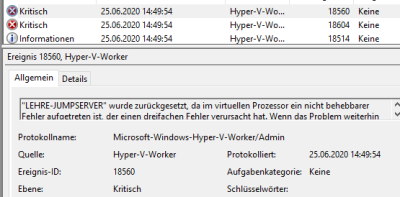
Hyper-V VLAN
Getestet auf Ubuntu 18.04 und Windows 2019 Host
Wollte VLANs direkt nativ im Linux konfigurieren / Es ist leider nur möglich entweder tagged (trunk) Pakete oder untagged (access) Pakete über den Host auf den Switch zu bringen
NativeVlanId bedeutet Pakete die von der linux Maschine untagged sind werden durch den Host mit der VLAN Id getagged d.h. am Switch nur tagged Pakete / Untagged ist die Default Konfiguration
PS C:\Users\Administrator> Set-VMNetworkAdapterVLAN -VMName PLAY -Trunk -AllowedVlanIDList 1-500 -NativeVlanId 1
PS C:\Users\Administrator> Set-VMNetworkAdapterVLAN -VMName PLAY -Untagged
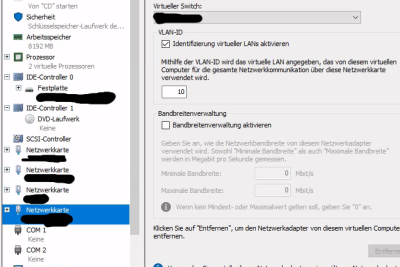
Hyper-V Powershell
PS > Get-VMCheckpoint -VMName Fileserver
VMName Name SnapshotType CreationTime ParentSnapshot
Name
------ ---- ------------ ------------ --------------
Fileserver Altaro Temp Checkpoint:-Fileserver - (24.10.2023 - 20:00:17) Recovery 24.10.2023 20:00:18
PS > Remove-VMCheckpoint -VMName Fileserver
KMS Server
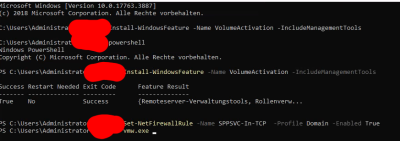
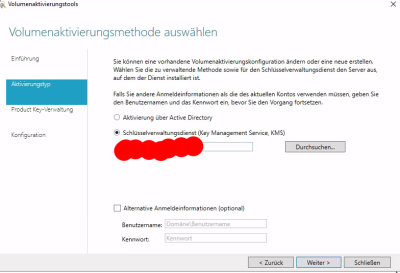
Wenn der Eintrag nicht im
DNS veröffentlicht werden soll (fürs auto lookup der Clients/Server) muss dies manuell erfolgen - es handelt sich hier um einen
SRV Eintrag zB:


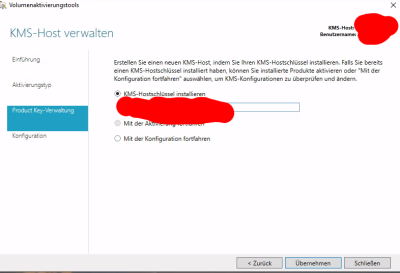
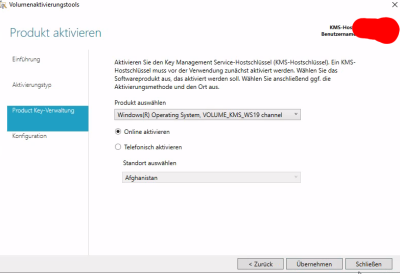
Firewalling:
x.x.x.x - - [18/Jan/2023:11:51:07 +0100] "CONNECT sls.update.microsoft.com:443 HTTP/1.1" 200 4405 "-" "-" TCP_TUNNEL:HIER_DIRECT 52.152.110.14 - -
x.x.x.x - - [18/Jan/2023:11:51:08 +0100] "GET http://ocsp.digicert.com/MFEwTzBNMEswSTAJBgUrDgMCGgUABBSAUQYBMq2awn1Rh6Doh%2FsBYgFV7gQUA95QNVbRTLtm8KPiGxvDl7I90VUCEAJ0LqoXyo4hxxe7H%2Fz9DKA%3D HTTP/1.1" 200 892 "-" "Microsoft-CryptoAPI/10.0" TCP_MISS:HIER_DIRECT 93.184.220.29 application/ocsp-response -
x.x.x.x - - [18/Jan/2023:11:51:08 +0100] "CONNECT login.live.com:443 HTTP/1.1" 200 16349 "-" "-" TCP_TUNNEL:HIER_DIRECT 40.126.32.67 - -
x.x.x.x - - [18/Jan/2023:11:51:09 +0100] "CONNECT licensing.mp.microsoft.com:443 HTTP/1.1" 200 5297 "-" "-" TCP_TUNNEL:HIER_DIRECT 20.123.104.105 - -
x.x.x.x - - [18/Jan/2023:11:51:10 +0100] "CONNECT activation-v2.sls.microsoft.com:443 HTTP/1.1" 200 21030 "-" "-" TCP_TUNNEL:HIER_DIRECT 40.91.76.224 - -
x.x.x.x - - [18/Jan/2023:11:51:12 +0100] "CONNECT validation-v2.sls.microsoft.com:443 HTTP/1.1" 200 58569 "-" "-" TCP_TUNNEL:HIER_DIRECT 20.83.72.98 - -
x.x.x.x - - [18/Jan/2023:11:51:19 +0100] "CONNECT validation-v2.sls.microsoft.com:443 HTTP/1.1" 200 15113 "-" "-" TCP_TUNNEL:HIER_DIRECT 20.83.72.98 - -
x.x.x.x - - [18/Jan/2023:11:51:21 +0100] "CONNECT login.live.com:443 HTTP/1.1" 200 22253 "-" "-" TCP_TUNNEL:HIER_DIRECT 40.126.32.67 - -
x.x.x.x - - [18/Jan/2023:11:51:21 +0100] "CONNECT licensing.mp.microsoft.com:443 HTTP/1.1" 200 5297 "-" "-" TCP_TUNNEL:HIER_DIRECT 20.123.104.105 - -
x.x.x.x - - [18/Jan/2023:11:51:39 +0100] "CONNECT licensing.mp.microsoft.com:443 HTTP/1.1" 200 5297 "-" "-" TCP_TUNNEL:HIER_DIRECT 20.123.104.105 - -
x.x.x.x - - [18/Jan/2023:11:51:40 +0100] "CONNECT activation-v2.sls.microsoft.com:443 HTTP/1.1" 200 21030 "-" "-" TCP_TUNNEL:HIER_DIRECT 40.91.76.224 - -
x.x.x.x - - [18/Jan/2023:11:51:42 +0100] "CONNECT validation-v2.sls.microsoft.com:443 HTTP/1.1" 200 58569 "-" "-" TCP_TUNNEL:HIER_DIRECT 20.83.72.98 - -
x.x.x.x - - [18/Jan/2023:11:51:47 +0100] "CONNECT validation-v2.sls.microsoft.com:443 HTTP/1.1" 200 15113 "-" "-" TCP_TUNNEL:HIER_DIRECT 20.83.72.98 - -
x.x.x.x - - [18/Jan/2023:11:51:50 +0100] "CONNECT login.live.com:443 HTTP/1.1" 200 22253 "-" "-" TCP_TUNNEL:HIER_DIRECT 40.126.32.67 - -
x.x.x.x - - [18/Jan/2023:11:51:50 +0100] "CONNECT licensing.mp.microsoft.com:443 HTTP/1.1" 200 5297 "-" "-" TCP_TUNNEL:HIER_DIRECT 20.123.104.105 - -
---
Keys anzeigen cmd:
List KMS Keys in use by host-server itself
cscript c:\windows\system32\slmgr.vbs /dlv
List all installed KMS Keys:
cscript C:\Windows\System32\slmgr.vbs /dli all
Offizielles:
https://learn.microsoft.com/de-de/windows-server/get-started/kms-create-host
https://learn.microsoft.com/en-us/previous-versions/windows/it-pro/windows-server-2012-R2-and-2012/dn502531(v=ws.11)
Storage Pools / Storage Spaces
Windows Proxy einstellungen
You can do it with this:
To Enable 'Automatically Detect Settings'
REG ADD "HKCU\Software\Microsoft\Windows\CurrentVersion\Internet Settings" /v AutoDetect /t REG_DWORD /d 1 /f
To Disable 'Automatically Detect Settings'
REG ADD "HKCU\Software\Microsoft\Windows\CurrentVersion\Internet Settings" /v AutoDetect /t REG_DWORD /d 0 /f
The proxy settings for WinHTTP are not the proxy settings for Microsoft Internet Explorer.
You cannot configure the proxy settings for WinHTTP in the Microsoft Windows Control Panel.
Using the WinHTTP proxy configuration utility does not alter the settings you use for Internet Explorer.
To configure a system wide proxy do
netsh winhttp set proxy myproxy
source: http://technet.microsoft.com/pt-br/library/cc731131(v=ws.10).aspx#BKMK_5
if you want to use IE proxy settings for all programs, try
netsh winhttp import proxy source =ie
source: http://technet.microsoft.com/pt-br/library/cc731131(v=ws.10).aspx#BKMK_2
more information here:
http://msdn.microsoft.com/en-us/library/windows/desktop/aa384069(v=vs.85).aspx
Windows 2012r2 Update Fehler
Am 06.08.2015 schrieb Woly:
ein frisch installierter Server 2012 R2 Essentials meldet bei der Suche nach Updates den Fehler 80244019. Dieser Fehlercode scheint häufiger in Verbindung mit WSUS aufzutreten, aber weder führt dieser Server einen WSUS aus, noch hängt er an einem WSUS. Die Verbindung "nach draußen" wird durch einen handelsüblichen DSL-Router gewährleistet und auch nicht eingeschränkt.
In einer administrativen Commandline diese Befehle ausführen und anschließend den Server komplett neu starten.
net stop wuauserv
rd /s /q %windir%\SoftwareDistribution
del %windir%\WindowsUpdate.log
net start wuauserv
Nach dem Neustart auf Windows Update manuell nach Updates suchen
lassen. Das kann beim ersten Mal auch etwas länger dauern.
https://kevinlocke.name/bits/2017/01/20/formerr-from-microsoft-dns-server-for-dig/
DIG requested kevinlocke.name and received FORMERR. After some trial and error, I determined that the issue results from DIG 9.11 sending the DNS COOKIE option. This option was enabled by default in BIND 9.11. Unfortunately, adding this option causes DNS Server to treat the request as malformed. This behavior appears to violate “Any OPTION-CODE values not understood by a responder or requestor MUST be ignored.” from Section 6.1.2 of RFC 6891, but that is of small consolation for a non-working system.
-> As a workaround, pass the +nocookie option (or +noedns to disable all EDNS options) as in
Windows DNS Server Blacklist
Removing WPAD from DNS block list
The DNS Server role in Windows Server 2008 introduces a global query block list to reduce vulnerability associated with dynamic DNS updates. For more information, see About implementing WPAD.
If you want to use WPAD with DNS, note the following:
If WPAD entries are configured in DNS before the DNS server is upgraded in Windows Server 2008, no action is required.
If you configure or remove WPAD after you deploy the DNS server role on a server running Windows Server 2008, you must update the block list on all DNS servers that host the zones affected by the change. The affected zones are those where you registered the WPAD servers.
Updating the block list
Use the dnscmd command-line tool to manage the global query block list. Open a command line prompt, and then do the following:
To check whether the global query block is enabled, type the following:
dnscmd /info /enableglobalqueryblocklist
To display the host names in the current block list, type the following:
dnscmd /info /globalqueryblocklist
To disable the block list and ensure that the DNS Server service does not ignore queries for names in the block list, type the following:
dnscmd /config /enableglobalqueryblocklist 0
To enable the block list and ensure that the DNS Server service ignores queries for names in the block list, type the following:
dnscmd /config /enableglobalqueryblocklist 0
To remove all names from the block list, type the following:
dnscmd /config /globalqueryblocklist
To replace the current block list with a list of the names that you specify, type the following:
dnscmd /config /globalqueryblocklist name [name]…
For more information and instructions, see the document "DNS Server Global Query Block List", available for download from Domain Name System at Microsoft TechNet.
VHD into WIM konvertieren
19
down vote
accepted
Absolutely, let's post a prim and proper answer for Google. This is a simple 2 command Powershell execution, using the dism module. The dism can be copied to earlier versions of Windows, provided you have the appropriate version of the windows management framework.
First, mount the vhd using
Mount-WindowsImage -ImagePath C:\VHDs\BigHomies.vhdx -Path C:\VHDMount -Index 1
Then, capture it into a wim with
New-WindowsImage -CapturePath C:\VHDMount -Name Win7Image -ImagePath C:\CapturedWIMs\Win7.wim -Description "Yet another Windows 7 Image" -Verify
And let it do it's thing. When you are done you can unmount the vhd and discard any changes using:
Dismount-WindowsImage -Path C:\VHDMount -Discard
VHD dynamic in fixed konvertieren
https://hyper-v-backup.backupchain.com/how-to-convert-from-dynamic-vhdvhdx-disk-format-to-from-fixed-in-hyper-v/
Convert-VHD –Path c:\VM\my-vhdx.vhdx –DestinationPath c:\New-VM\new-vhdx.vhdx –VHDType Dynamic
Windows Dienste f. User
C:\Program Files (x86)\Windows Resource Kits\Tools>subinacl /SERVICE \\PLAY-PC-2
\joomlaApache /GRANT=schule.intern\Lehrer=F
subinacl /SERVICE \\PLAY-PC-2\joomlaApache /GRANT=schule.intern\Schueler=F
C:\Users\Administrator>subinacl /service joomlaApache /grant="schule.intern\Dom�nen-Benutzer=F"
C:\Program Files (x86)\Windows Resource Kits\Tools
DHCP Server
UEFI/LEGACY PXE BOOT WDS Options
Getestet auf Windows 2022
-
Sollten sich DHCP und WDS Server auf der gleichen Maschine befinden setzt der WDS Dienst unter dem Häckchen DHCP-Optionen konfigurieren alle notwendigen Optionen (DHCP Option 60) für den DHCP Server die für PXE Booten sowohl Legacy als auch UEFI notwendig sind
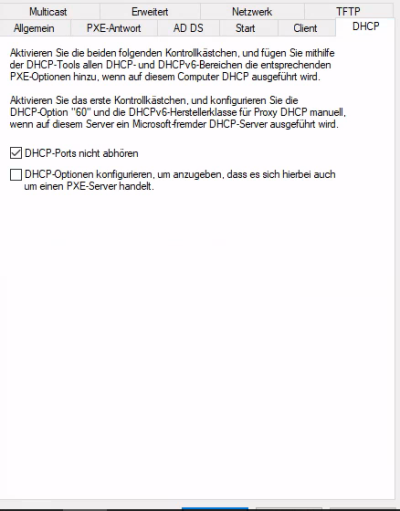


Für den Verweis über UEFI PXE Boot ist der Aufwand schon größer - es muss eine eigene Herstellerklasse definiert werden und bei einem Match werden die Optionen 66 und 67 mit geändertem Inhalt an den Client verschickt:
bei den DHCP Einstellungen unter IPV4 Herstellerklassen - Hinzufügen:

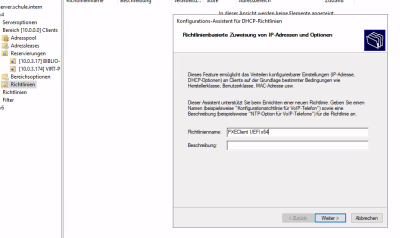


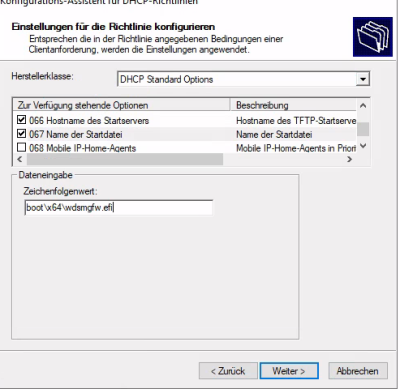


WDS/Windows/WSUS Server
https://social.technet.microsoft.com/Forums/windows/en-US/c469805c-98af-4bb2-9655-c86c294470a9/sysprep-failure-occurred-while-executing-drmv2cltdll-fix?forum=w7itproinstall:
Click Start > Run, type Services.msc to open the Services applet.
Scroll down to Windows Media Player Network Sharing Service, double click it, change the Startup type to Disabled. Click OK.
Reboot the PC
Bei Fehler 30 nvidia treiber: expand *.* .\test\ -> dann kommt wurde vergrößert xy prozent und dann gehts im test verzeichnis
siehe WDS deadaffebeef magic darunter für treiber hinzufügen
http://deadaffebeef.com/blog/wds-windows-updates-treiber-zu-wim-abbild-hinzufugen/
1) Das Installationsabbild, welchem weitere Pakete hinzugefügt werden sollen, muss zu allererst exportiert werden:
CMD (als Administrator ausführen!): wdsutil -Export-Image -Image:”Win7 x86 ENT” -ImageType:Install -ImageGroup:Win7 -DestinationImage -FilePath:D:\Win7x86ENT.wim -Overwrite:Yes
2) Als nächstes muss die WIM-Datei gemountet werden:
dism -Mount-Wim -WimFile:D:\Win7x86ENT.wim -Index:1 -MountDir:D:\Mount
3) Nun können die Update- (CAB oder MSU) bzw. Treiber-Pakete dem gemounteten Image hinzugefügt werden:
Windows Updates: dism -Image:D:\Mount -Add-Package -PackagePath:<Pfad_und_Dateiname> /Recurse
Treiber: dism -Image:D:\Mount -Add-Driver -Driver:<inf-Pfad_OHNE_Dateiname>
4) Die vorgenommenen Änderungen am Image müssen gespeichert werden:
dism -Commit-Wim -MountDir:D:\Mount
5) Bevor das neue Image im WDS eingebunden werden kann, muss es zunächst unmountet werden:
dism -Unmount-Wim -Commit -MountDir:D:\Mount
6) Jetzt noch das ursprüngliche Installationsabbild durch das angepasste ersetzen und wir sind fertig:
wdsutil -Replace-Image -Image:”Win7 x86 ENT” -ImageType:Install -ImageGroup:Win7 -ReplacementImage -ImageFile:D:\Win7x86ENT.wim
Alternativ kann das geänderte Image als neues Abbild im WDS eingebunden werden:
wdsutil -Add-Image -ImageType:Install -ImageGroup:Win7 -ImageFile:D:\Win7x86ENT.wim -SingleImage:”Win7 x86 Enterprise” -Name:”Win7 x86 ENT” -Description:”Win7 x86 ENT Image – neu”
http://blogs.technet.com/b/nepapfe/archive/2013/03/01/it-s-simple-time-configuration-in-active-directory.aspx
AT Pool:
server 0.at.pool.ntp.org
server 1.at.pool.ntp.org
server 2.at.pool.ntp.org
server 3.at.pool.ntp.org
zB:
llten Sie eine neuere Version von Windows einsetzten, können Sie den NTP-Client nutzen, der in das System integriert ist. Führen Sie dazu folgendes Kommando als Administrator aus:
w32tm /config /syncfromflags:manual /manualpeerlist:"0.pool.ntp.org 1.pool.ntp.org 2.pool.ntp.org 3.pool.ntp.org"
Status:
C:\Users\administrator.SCHULE.000>w32tm /query /status
Sprungindikator: 0(keine Warnung)
Stratum: 2 (Sekundärreferenz - synchr. über (S)NTP)
Präzision: -6 (15.625ms pro Tick)
Stammverzögerung: 0.0000000s
Stammabweichung: 0.0100000s
Referenz-ID: 0x564D5450 (Quell-IP: 86.77.84.80)
Letzte erfolgr. Synchronisierungszeit: 24.06.2015 11:07:00
Quelle: VM IC Time Synchronization Provider
Abrufintervall: 6 (64s)
Befehl:
w32tm /config /syncfromflags:manual /manualpeerlist:"0.at.pool.ntp.org 1.at.pool.ntp.org 2.at.pool.ntp.org "/update /reliable:yes
w32tm /resync
Time gschichtln hyper v:
http://blogs.msdn.com/b/robertvi/archive/2011/05/11/time-synchronization-and-domain-controller-vm-s.aspx
https://support.microsoft.com/en-us/kb/816042
https://technet.microsoft.com/en-us/library/virtual_active_directory_domain_controller_virtualization_hyperv(WS.10).aspx
Time Set Session:
C:\Users\Administrator>w32tm /query /status
Sprungindikator: 0(keine Warnung)
Stratum: 4 (Sekundärreferenz - synchr. über (S)NTP)
Präzision: -23 (119.209ns pro Tick)
Stammverzögerung: 0.0358491s
Stammabweichung: 0.0479295s
Referenz-ID: 0x3369D0AD (Quell-IP: 51.105.208.173)
Letzte erfolgr. Synchronisierungszeit: 14.05.2021 19:05:41
Quelle: time.windows.com,0x8
Abrufintervall: 10 (1024s)
C:\Users\Administrator>w32tm /config /manualpeerlist:"at.pool.ntp.org,0x8" /syncfromflags:manual /reliable:yes /update
Der Befehl wurde erfolgreich ausgeführt.
C:\Users\Administrator>net stop w32time && net start w32time
Windows-Zeitgeber wird beendet.
Windows-Zeitgeber wurde erfolgreich beendet.
Windows-Zeitgeber wird gestartet.
Windows-Zeitgeber wurde erfolgreich gestartet.
C:\Users\Administrator>w32tm /resync
Befehl zum erneuten Synchronisieren wird an den lokalen Computer gesendet.
Der Befehl wurde erfolgreich ausgeführt.
C:\Users\Administrator>w32tm /query /status
Sprungindikator: 0(keine Warnung)
Stratum: 3 (Sekundärreferenz - synchr. über (S)NTP)
Präzision: -23 (119.209ns pro Tick)
Stammverzögerung: 0.0123271s
Stammabweichung: 7.8446831s
Referenz-ID: 0x563B50AA (Quell-IP: 86.59.80.170)
Letzte erfolgr. Synchronisierungszeit: 14.05.2021 19:17:02
Quelle: at.pool.ntp.org
Abrufintervall: 6 (64s)
slmgr.vbs /ckms
slmgr.vbs /skms KMS_SERVER_ADRESSE
slmgr.vbs /ato
It's not about root partition, it's about trailing slash. E:\WSUS\ will give you the same error. E:\WSUS will work.
kein "\" suffix

Druckserver neu starten
@echo off
net stop spooler
del %SystemRoot%\spool\PRINTERS\*.tmp
net start spooler
Drucker per Cli hinzufügen
Examples:
Examples
To add a new remote printer, printer1, for a computer, Client1, which is visible for the user account where this command is run, type:
rundll32 printui.dll PrintUIEntry /in /n\\client1\printer1
To add a printer using the add printer wizard and using an .inf file, InfFile.inf, located on drive c: at Infpath, type:
rundll32 printui.dll PrintUIEntry /ii /f c:\Infpath\InfFile.inf
To delete an existing printer, printer1, on a computer, Client1, type:
rundll32 printui.dll PrintUIEntry /dn /n\\client1\printer1
To add a per computer printer connection, printer2, for all users of a computer, Client2, type (the connection will be applied when a user logs on):
rundll32 printui.dll PrintUIEntry /ga /n\\client2\printer2
To delete a per computer printer connection, printer2, for all users of a computer, Client2, type (the connection will be deleted when a user logs on):
rundll32 printui.dll PrintUIEntry /gd /n\\client2\printer2
To view the properties of the print server, printServer1, type:
rundll32 printui.dll PrintUIEntry /s /t1 /c\\printserver1
To view the properties of a printer, printer3, type:
rundll32 printui.dll PrintUIEntry /p /n\\printer3
Druckerinstallation per Kommandozeile. Das Einrichten eines Netzwerkdrucker per CMD mit folgendem Befehl:
rundll32.exe printui.dll,PrintUIEntry /in /n “\\printsvr\KonicaMinolta 240f”
Der Parameter /in bedeutet > install network printer
Der Parameter /n gibt den Freigabenamen des Druckers an. In diesem Beispiel mit Pfadnamen zum Printserver.
Office 2013/Office 365
To delete an Office profile that may still be cached
From Registry Editor, browse to:
HKEY_CURRENT_USER\Software\Microsoft\Office\15.0\Common\Identity\Identities
Choose the Office profile that you want to delete, and then choose Delete.
From the Identity hive, navigate to the Profiles node, choose that same identity, open the shortcut menu (right-click), and then choose Delete.
@echo off
if not EXIST "C:\Program Files (x86)\Microsoft Office\Office15\" GOTO End
if EXIST "C:\activated.txt" GOTO End
cd "C:\Program Files (x86)\Microsoft Office\Office15\"
cscript ospp.vbs /act > C:\activated.txt
:End
1. Powershell administrative Berechtingungen
2. Set-ExecutionPolicy Unrestricted –force
3. $UserCredential = Get-Credential
4. $Session = New-PSSession -ConfigurationName Microsoft.Exchange -ConnectionUri https://outlook.office365.com/powershell-liveid/ -Credential $UserCredential -Authentication Basic –AllowRedirection
5. Import-PSSession $Session
6. Get-Mailbox -ResultSize Unlimited | Set-Clutter -Enable $False
Windows Aktivierungsstatus
So überprüfst Du, ob der KMS Server aktiviert
Slmgr.vbs /ckms
Slmgr.vbs /skms KMS_SERVER
Du kannst mit dem folgenden Befehl im Commandprompt überprüfen, ob die Aktivierung erfolgreich durchgeführt wird:
slmgr.vbs –ato
Using DNS Manager, in the appropriate forwarding lookup zone, create a new SRV RR using the appropriate information for the location. By default, KMS listens on TCP port 1688, and the service is _VLMCS. Table 2 contains example settings for a SRV RR.
Table 2 SRV Resource Record
Name
Setting
Service
_VLMCS
Protocol
_TCP
Port number
1688
Host offering the service
FQDN of KMS Host
Windows PE Boot Environment
ipconfig /all -> ip check
drvload Pfad/*.inf -> Treiber laden
Zugriff auf lokale Gruppenrichtlinien
start - ausführen → mmc.exe → Kontext der lokalen Gruppenrichtlinien des Computers importieren
Ohne diese Maßnahmen lassen sich die Windows Updates auf einem lokalen Server der nicht Mitglied einer Domäne ist nicht sinnvoll konfigurieren
zB: Updates konfigurieren falls betroffener Server kein Mitglied der Domäne ist / möchte täglich nach Updates suchen / Treiberupdates ausschließen / um 01:00 soll er installieren und auch automatisch neu starten wenn notwendig
Getestet auf Windows 2019 Standard
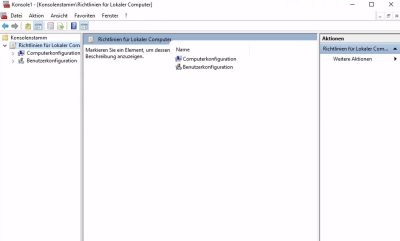


WSUS
# Variablen
$DateFormat = Get-Date -format yyyyMMdd-HH-mm
$Logfile = "D:\Logs\wsus-bereinigung-$DateFormat.log"
# WSUS Bereinigung durchführen
Invoke-WsusServerCleanup -CleanupObsoleteUpdates -CleanupUnneededContentFiles -CompressUpdates -DeclineExpiredUpdates -DeclineSupersededUpdates | Out-File $Logfile
-
zB: Nach F:\WSUS verschieben und Logfile erstellen
C:\Program Files\Update Services\Tools\WsusUtil.exe movecontent F:\WSUS F:\WSUS.log [-skipcontent]
Mit skipcontent ändert er offenbar nur die Config und versucht keinen Kopiervorgang
Achtung er schreibt es passt aber er ändert das VZ nicht !!!
Bei Erfolg und das alte Datenverzeichnis LÖSCHEN sonst ein lock!!
2018-08-27T08:23:57 Successfully stopped WsusService.
2018-08-27T08:23:57 Beginning content file location change to F:\WSUS\
2018-08-27T08:23:57 Did not copy files due to -skipcopy flag.
2018-08-27T08:23:57 Successfully changed WUS configuration.
2018-08-27T08:23:59 Successfully changed IIS virtual directory path.
2018-08-27T08:23:59 Successfully removed existing local content network shares.
2018-08-27T08:23:59 Successfully created local content network shares.
2018-08-27T08:23:59 Successfully changed registry value for content store directory.
2018-08-27T08:23:59 Successfully changed content file location.
2018-08-27T08:24:01 Successfully started WsusService.
2018-08-27T08:24:01 Content integrity check and repair...
2018-08-27T08:24:01 Initiated content integrity check and repair.
Office 365 Online World of Microsoft
Regelwerke für Nachrichten / Message Flows

^[1-9]{1}[a-zA-Z]{1,2}@domain.foo$
'To' header matches the following patterns: '^\d\S@domain.foo$' or '^\d\S\S@domain.foo$'
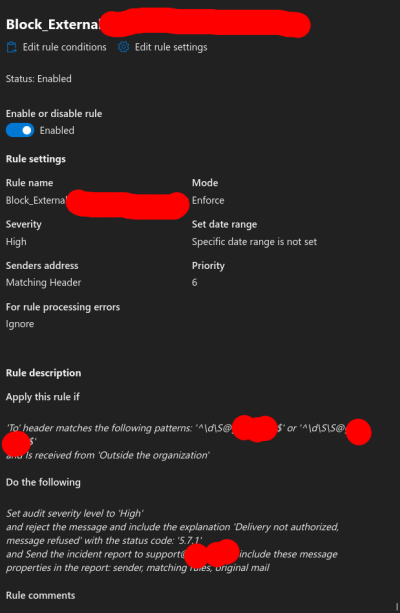
Von deucalion75 bei Reddit
With all of that said, you'll definitely want to download the latest UR of Exchange (2016 typically works best, but any should do) and extract it to your schema master. Then, in an elevated powershell, run the following to expand your attributes:
.\Setup /PrepareSchema /IAcceptExchangeServerLicenseTerms
.\Setup /PrepareAD /OrganizationName:FirstOrganization /IAcceptExchangeServerLicenseTerms
.\Setup /PrepareAllDomains /IAcceptExchangeServerLicenseTerms
User avatar
level 2
justinb19
·
/IAcceptExchangeServerLicenseTerms_DiagnosticDataON
Weiterleitung aktivieren
Falls es erforderlich wird „Weiterleitungen“ zu aktivieren - Achtung Microsoft hat hier gegen Ende November/Dezember 2020 die Policy geändert - dass per default keine Weiterleitungen mehr erlaubt sind
Bei Filterrichtlinie für ausgehendes Spam (immer EIN) - Richtlinie bearbeiten
-

Whitelist Absender
Spam in Junk-Mail
Teilweise werden Mails von MS zum Frühstück verspeist und der Sender weiß nicht , dass die Mail nicht zugestellt wurde , wenn die Option Spam auf „Nachricht löschen“ steht - mit „Nachricht in Junk-E-Mail verschieben“ wird sie zumindest zum Empfänger zugestellt
-

Powershell - nice to know
PS C:\> Start-Transcript -path c:\docs\Text3.txt
.\YOUR-SCRIPT.ps1
PS C:\> Stop-Transcript
Windows Server 2019
Domain Controller hinzufügen
MAK Key Fehler Aktivierung
Windows 10
Unattended XML File erstellen
Ziel war es ein unattended XML File zu erstellen , das die Festplatte partitioniert (UEFI) und eine Workgroup setzt - sonst soll alles Default sein damit der User das Windows 10 Professional Setup klicki feeling bekommt und in Eigenverantwortung die Fragen beantwortet
Es wurde eine Windows 10 Pro/Enterprise ISO genutzt die von den Microsoft VSLC Servern herunter geladen wurde
Das XML File kann sowohl am WDS Server für eine install.wim (zB: aus der ISO extrahiert und dem WDS Server hinzugefügt) als auch für eine USB Stick Installation verwendet werden - oder überhaupt per /unattend:XML_FILE definiert werden :)
<?xml version="1.0" encoding="utf-8"?>
<unattend xmlns="urn:schemas-microsoft-com:unattend">
<settings pass="windowsPE">
<component name="Microsoft-Windows-International-Core-WinPE" processorArchitecture="amd64" publicKeyToken="31bf3856ad364e35" language="neutral" versionScope="nonSxS" xmlns:wcm="http://schemas.microsoft.com/WMIConfig/2002/State" xmlns:xsi="http://www.w3.org/2001/XMLSchema-instance">
<SetupUILanguage>
<UILanguage>de-DE</UILanguage>
</SetupUILanguage>
<UserLocale>de-DE</UserLocale>
<UILanguage>de-DE</UILanguage>
<SystemLocale>de-DE</SystemLocale>
<InputLocale>0407:00000407</InputLocale>
</component>
<component name="Microsoft-Windows-Setup" processorArchitecture="amd64" publicKeyToken="31bf3856ad364e35" language="neutral" versionScope="nonSxS" xmlns:wcm="http://schemas.microsoft.com/WMIConfig/2002/State" xmlns:xsi="http://www.w3.org/2001/XMLSchema-instance">
<DiskConfiguration>
<Disk wcm:action="add">
<CreatePartitions>
<CreatePartition wcm:action="add">
<Order>1</Order>
<Size>300</Size>
<Type>Primary</Type>
</CreatePartition>
<CreatePartition wcm:action="add">
<Order>2</Order>
<Size>100</Size>
<Type>EFI</Type>
</CreatePartition>
<CreatePartition wcm:action="add">
<Order>3</Order>
<Size>128</Size>
<Type>MSR</Type>
</CreatePartition>
<CreatePartition wcm:action="add">
<Order>4</Order>
<Type>Primary</Type>
<Extend>true</Extend>
</CreatePartition>
</CreatePartitions>
<ModifyPartitions>
<ModifyPartition wcm:action="add">
<Format>NTFS</Format>
<Label>WinRE</Label>
<Order>1</Order>
<PartitionID>1</PartitionID>
<TypeID>DE94BBA4-06D1-4D40-A16A-BFD50179D6AC</TypeID>
</ModifyPartition>
<ModifyPartition wcm:action="add">
<Label>Windows</Label>
<Letter>C</Letter>
<Order>4</Order>
<PartitionID>4</PartitionID>
<Format>NTFS</Format>
</ModifyPartition>
<ModifyPartition wcm:action="add">
<Order>3</Order>
<PartitionID>3</PartitionID>
</ModifyPartition>
<ModifyPartition wcm:action="add">
<Order>2</Order>
<PartitionID>2</PartitionID>
<Format>FAT32</Format>
<Label>System</Label>
</ModifyPartition>
</ModifyPartitions>
<DiskID>0</DiskID>
<WillWipeDisk>true</WillWipeDisk>
</Disk>
</DiskConfiguration>
<ImageInstall>
<OSImage>
<InstallTo>
<DiskID>0</DiskID>
<PartitionID>4</PartitionID>
</InstallTo>
<WillShowUI>OnError</WillShowUI>
</OSImage>
</ImageInstall>
<UserData>
<AcceptEula>true</AcceptEula>
</UserData>
</component>
<settings pass="specialize">
<component name="Microsoft-Windows-UnattendedJoin" processorArchitecture="amd64" publicKeyToken="31bf3856ad364e35" language="neutral" versionScope="nonSxS" xmlns:wcm="http://schemas.microsoft.com/WMIConfig/2002/State" xmlns:xsi="http://www.w3.org/2001/XMLSchema-instance">
<Identification>
<JoinWorkgroup>Private</JoinWorkgroup>
</Identification>
</component>
</settings>
</settings>
<cpi:offlineImage cpi:source="wim:c:/tmp/install_1909.wim#Windows 10 Pro" xmlns:cpi="urn:schemas-microsoft-com:cpi" />
</unattend>
<?xml version="1.0" encoding="utf-8"?>
<unattend xmlns="urn:schemas-microsoft-com:unattend">
<settings pass="windowsPE">
<component name="Microsoft-Windows-International-Core-WinPE" processorArchitecture="amd64" publicKeyToken="31bf3856ad364e35" language="neutral" versionScope="nonSxS" xmlns:wcm="http://schemas.microsoft.com/WMIConfig/2002/State" xmlns:xsi="http://www.w3.org/2001/XMLSchema-instance">
<SetupUILanguage>
<UILanguage>de-DE</UILanguage>
</SetupUILanguage>
<UserLocale>de-DE</UserLocale>
<UILanguage>de-DE</UILanguage>
<SystemLocale>de-DE</SystemLocale>
<InputLocale>0407:00000407</InputLocale>
</component>
<component name="Microsoft-Windows-Setup" processorArchitecture="amd64" publicKeyToken="31bf3856ad364e35" language="neutral" versionScope="nonSxS" xmlns:wcm="http://schemas.microsoft.com/WMIConfig/2002/State" xmlns:xsi="http://www.w3.org/2001/XMLSchema-instance">
<DiskConfiguration>
<Disk wcm:action="add">
<CreatePartitions>
<CreatePartition wcm:action="add">
<Order>1</Order>
<Size>300</Size>
<Type>Primary</Type>
</CreatePartition>
<CreatePartition wcm:action="add">
<Order>2</Order>
<Size>100</Size>
<Type>EFI</Type>
</CreatePartition>
<CreatePartition wcm:action="add">
<Order>3</Order>
<Size>128</Size>
<Type>MSR</Type>
</CreatePartition>
<CreatePartition wcm:action="add">
<Order>4</Order>
<Type>Primary</Type>
<Extend>true</Extend>
</CreatePartition>
</CreatePartitions>
<ModifyPartitions>
<ModifyPartition wcm:action="add">
<Format>NTFS</Format>
<Label>WinRE</Label>
<Order>1</Order>
<PartitionID>1</PartitionID>
<TypeID>DE94BBA4-06D1-4D40-A16A-BFD50179D6AC</TypeID>
</ModifyPartition>
<ModifyPartition wcm:action="add">
<Label>Windows</Label>
<Letter>C</Letter>
<Order>4</Order>
<PartitionID>4</PartitionID>
<Format>NTFS</Format>
</ModifyPartition>
<ModifyPartition wcm:action="add">
<Order>3</Order>
<PartitionID>3</PartitionID>
</ModifyPartition>
<ModifyPartition wcm:action="add">
<Order>2</Order>
<PartitionID>2</PartitionID>
<Format>FAT32</Format>
<Label>System</Label>
</ModifyPartition>
</ModifyPartitions>
<DiskID>0</DiskID>
<WillWipeDisk>true</WillWipeDisk>
</Disk>
</DiskConfiguration>
<ImageInstall>
<OSImage>
<InstallTo>
<DiskID>0</DiskID>
<PartitionID>4</PartitionID>
</InstallTo>
<WillShowUI>OnError</WillShowUI>
<InstallFrom>
<MetaData wcm:action="add">
<Key>/IMAGE/NAME</Key>
<Value>Windows 10 Pro</Value>
</MetaData>
</InstallFrom>
</OSImage>
</ImageInstall>
<UserData>
<AcceptEula>true</AcceptEula>
</UserData>
</component>
</settings>
<cpi:offlineImage cpi:source="wim:c:/tmp/install_1909.wim#Windows 10 Pro" xmlns:cpi="urn:schemas-microsoft-com:cpi" />
</unattend>
<?xml version="1.0" encoding="utf-8"?>
<unattend xmlns="urn:schemas-microsoft-com:unattend">
<settings pass="windowsPE">
<component name="Microsoft-Windows-International-Core-WinPE" processorArchitecture="amd64" publicKeyToken="31bf3856ad364e35" language="neutral" versionScope="nonSxS" xmlns:wcm="http://schemas.microsoft.com/WMIConfig/2002/State" xmlns:xsi="http://www.w3.org/2001/XMLSchema-instance">
<SetupUILanguage>
<UILanguage>de-DE</UILanguage>
</SetupUILanguage>
<UserLocale>de-DE</UserLocale>
<UILanguage>de-DE</UILanguage>
<SystemLocale>de-DE</SystemLocale>
<InputLocale>0407:00000407</InputLocale>
</component>
<component name="Microsoft-Windows-PnpCustomizationsWinPE" processorArchitecture="amd64" publicKeyToken="31bf3856ad364e35" language="neutral" versionScope="nonSxS" xmlns:wcm="http://schemas.microsoft.com/WMIConfig/2002/State" xmlns:xsi="http://www.w3.org/2001/XMLSchema-instance">
<DriverPaths>
<PathAndCredentials wcm:action="add" wcm:keyValue="1">
<Path>C:\driver\vmd\</Path>
</PathAndCredentials>
</DriverPaths>
</component>
<component name="Microsoft-Windows-Setup" processorArchitecture="amd64" publicKeyToken="31bf3856ad364e35" language="neutral" versionScope="nonSxS" xmlns:wcm="http://schemas.microsoft.com/WMIConfig/2002/State" xmlns:xsi="http://www.w3.org/2001/XMLSchema-instance">
<DiskConfiguration>
<Disk wcm:action="add">
<CreatePartitions>
<CreatePartition wcm:action="add">
<Order>1</Order>
<Size>300</Size>
<Type>Primary</Type>
</CreatePartition>
<CreatePartition wcm:action="add">
<Order>2</Order>
<Size>100</Size>
<Type>EFI</Type>
</CreatePartition>
<CreatePartition wcm:action="add">
<Order>3</Order>
<Size>128</Size>
<Type>MSR</Type>
</CreatePartition>
<CreatePartition wcm:action="add">
<Order>4</Order>
<Type>Primary</Type>
<Extend>true</Extend>
</CreatePartition>
</CreatePartitions>
<ModifyPartitions>
<ModifyPartition wcm:action="add">
<Format>NTFS</Format>
<Label>WinRE</Label>
<Order>1</Order>
<PartitionID>1</PartitionID>
<TypeID>DE94BBA4-06D1-4D40-A16A-BFD50179D6AC</TypeID>
</ModifyPartition>
<ModifyPartition wcm:action="add">
<Label>Windows</Label>
<Letter>C</Letter>
<Order>4</Order>
<PartitionID>4</PartitionID>
<Format>NTFS</Format>
</ModifyPartition>
<ModifyPartition wcm:action="add">
<Order>3</Order>
<PartitionID>3</PartitionID>
</ModifyPartition>
<ModifyPartition wcm:action="add">
<Order>2</Order>
<PartitionID>2</PartitionID>
<Format>FAT32</Format>
<Label>System</Label>
</ModifyPartition>
</ModifyPartitions>
<DiskID>1</DiskID>
<WillWipeDisk>true</WillWipeDisk>
</Disk>
</DiskConfiguration>
<ImageInstall>
<OSImage>
<InstallTo>
<DiskID>1</DiskID>
<PartitionID>4</PartitionID>
</InstallTo>
<WillShowUI>OnError</WillShowUI>
<InstallFrom>
<MetaData wcm:action="add">
<Key>/IMAGE/NAME</Key>
<Value>Windows 10 Pro</Value>
</MetaData>
</InstallFrom>
</OSImage>
</ImageInstall>
<UserData>
<AcceptEula>true</AcceptEula>
</UserData>
</component>
</settings>
<cpi:offlineImage cpi:source="wim:c:/tmp/install_1909.wim#Windows 10 Pro" xmlns:cpi="urn:schemas-microsoft-com:cpi" />
</unattend>

Aktivieren d. Keys aus BIOS
MBR to UEFI
Konvertieren bestehender MBR basierender Systeme auf UEFI
Getestet mit Windows 10 LTSC 2019 (1809) - bestehendes System von MBR auf UEFI migrieren (Hyper-V Generation 1 → Generation 2 Maschine) / Gebootet wurde von LTSC 2021 Windows 10 ISO
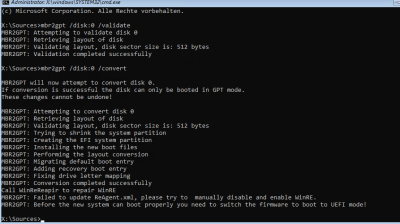

Microsoft Store auf LTSC 2019
-
Offiziell nicht supported - aber wo ein Wille ist findet sich ein Weg

Update: Die Pakete gibts doch offiziell zB: „Windows 10 Enterprise LTSC 2019 Inbox Apps“ - wer zB: Zugriff auf das VLSC Center von Microsoft hat / Achtung SHA1 Summen der Originaldateien von Microsoft unterscheiden sich zum Teil von LTSC-Add-MicrosoftStore - es können natürlich unterschiedliche Versionen sein
Update 2: Es reicht Add-AppxPackage 'PFAD\*.msix' aktueller User - Pfad zur msix Datei für die Installation von zB: Bitmedia msix File - und das Querladen muss aktiviert sein per GPO - es muss kein Store zwingend installiert sein ! - danke an Christoph Adl für den Tipp
-
Zuerst wird der Microsoft Store auf den Geräten installiert / Nach erfolgter Installation wird für den jeweilige Benutzer, der sich einloggt der App-Installer installiert / MSIX Dateien können nun geöffnet und gestartet werden (entsprechene GPO für das Querladen von Apps muss aktiviert werden - sonst können nur Apps direkt aus dem Store installiet und gestartet werden
robocopy /E /R:2 \\server\freigabe\LTSCStore\ C:\TMP\
if %ERRORLEVEL% EQU 16 goto end
if %ERRORLEVEL% EQU 15 goto end
if %ERRORLEVEL% EQU 14 goto end
if %ERRORLEVEL% EQU 13 goto end
if %ERRORLEVEL% EQU 12 goto end
if %ERRORLEVEL% EQU 11 goto end
if %ERRORLEVEL% EQU 10 goto end
if %ERRORLEVEL% EQU 9 goto end
if %ERRORLEVEL% EQU 8 goto end
if %ERRORLEVEL% EQU 7 goto install
if %ERRORLEVEL% EQU 6 goto install
if %ERRORLEVEL% EQU 5 goto install
if %ERRORLEVEL% EQU 4 goto install
if %ERRORLEVEL% EQU 3 goto install
if %ERRORLEVEL% EQU 2 goto install
if %ERRORLEVEL% EQU 1 goto install
if %ERRORLEVEL% EQU 0 goto install
:install
if exist "C:\store_installed.txt" goto end
cd C:\TMP\LTSC-Add-MicrosoftStore-2019
start /wait .\Add-Store.cmd
if %ERRORLEVEL% EQU 0 echo success > C:\store_installed.txt
:end
if ( -not ( Test-Path $env:userprofile\AppData\Local\itsr3_0_2_installed.txt ))
{
if (Test-Path "C:\store_installed.txt")
{
if ( -not ( Test-Path $env:userprofile\AppData\Local\app_installer_installed.txt ) )
{
Add-AppxPackage "C:\tmp\LTSC-Add-MicrosoftStore-2019\App-installer\Microsoft.UI.Xaml.2.7_7.2208.15002.0_x64__8wekyb3d8bbwe.Appx"
Add-AppxPackage "C:\tmp\LTSC-Add-MicrosoftStore-2019\App-installer\Microsoft.VCLibs.140.00.UWPDesktop_14.0.30704.0_x64__8wekyb3d8bbwe.Appx"
Add-AppxPackage "C:\tmp\LTSC-Add-MicrosoftStore-2019\App-installer\Microsoft.DesktopAppInstaller_2023.118.406.0_neutral_~_8wekyb3d8bbwe.Msixbundle"
if($?)
{
echo "installed" > $env:userprofile\AppData\Local\app_installer_installed.txt
}
}
}
Add-AppxPackage "\\server\freigabe\ITS-Organizer\itsr3-3.0.2.msix"
if($?)
{
echo "installed" > $env:userprofile\AppData\Local\itsr3_0_2_installed.txt
}
}
MS-Intune Nice-to-Know Bug Features / powershell
PS C:\Windows\system32> Install-Module -Name Microsoft.Graph.Intune
Der NuGet-Anbieter ist erforderlich, um den Vorgang fortzusetzen.
PowerShellGet erfordert die NuGet-Anbieterversion 2.8.5.201 oder höher für die Interaktion mit NuGet-basierten
Repositorys. Der NuGet-Anbieter muss in "C:\Program Files\PackageManagement\ProviderAssemblies" oder
"C:\Users\christian.CZECZIL\AppData\Local\PackageManagement\ProviderAssemblies" verfügbar sein. Sie können den
NuGet-Anbieter auch durch Ausführen von 'Install-PackageProvider -Name NuGet -MinimumVersion 2.8.5.201 -Force'
installieren. Möchten Sie den NuGet-Anbieter jetzt durch PowerShellGet installieren und importieren lassen?
[J] Ja [N] Nein [H] Anhalten [?] Hilfe (Standard ist "J"): j
Nicht vertrauenswürdiges Repository
Sie installieren die Module aus einem nicht vertrauenswürdigen Repository. Wenn Sie diesem Repository vertrauen, ändern
Sie dessen InstallationPolicy-Wert, indem Sie das Set-PSRepository-Cmdlet ausführen. Möchten Sie die Module von
'PSGallery' wirklich installieren?
[J] Ja [A] Ja, alle [N] Nein [K] Nein, keine [H] Anhalten [?] Hilfe (Standard ist "N"): j
PS C:\Windows\system32> Get-Command -Module Microsoft.Graph.Intune
PS C:\Windows\system32> Install-Module -Name Microsoft.Graph.Intune
PS C:\Windows\system32> echo $?
-----
PS C:\Windows\system32> Set-ExecutionPolicy Bypass
PS C:\Windows\system32> Connect-MSGraph -AdminConsent
Get-IntuneManagedDevice
PS C:\Windows\system32> Get-Command -Module Microsoft.Graph.Intune
CommandType Name Version Source
----------- ---- ------- ------
Alias Get-AADGroup 6.1907.1.0 Microsoft.Graph.Intune
Alias Get-AADGroupCreatedOnBehalfOf 6.1907.1.0 Microsoft.Graph.Intune
Alias Get-AADGroupCreatedOnBehalfOfReference 6.1907.1.0 Microsoft.Graph.Intune
Alias Get-AADGroupGroupLifecyclePolicy 6.1907.1.0 Microsoft.Graph.Intune
Alias Get-AADGroupMember 6.1907.1.0 Microsoft.Graph.Intune
Alias Get-AADGroupMemberOf 6.1907.1.0 Microsoft.Graph.Intune
Alias Get-AADGroupMemberOfReferenceSet 6.1907.1.0 Microsoft.Graph.Intune
Alias Get-AADGroupMemberReferenceSet 6.1907.1.0 Microsoft.Graph.Intune
Alias Get-AADGroupOwner 6.1907.1.0 Microsoft.Graph.Intune
Alias Get-AADGroupOwnerReferenceSet 6.1907.1.0 Microsoft.Graph.Intune
Alias Get-AADGroupPhoto 6.1907.1.0 Microsoft.Graph.Intune
Alias Get-AADGroupPhotoDataData 6.1907.1.0 Microsoft.Graph.Intune
Alias Get-AADGroupPhotoSet 6.1907.1.0 Microsoft.Graph.Intune
Alias Get-AADGroupPhotoSetDataData 6.1907.1.0 Microsoft.Graph.Intune
Alias Get-AADGroupSetting 6.1907.1.0 Microsoft.Graph.Intune
Alias Get-IntuneAppConfigurationPolicyTargeted 6.1907.1.0 Microsoft.Graph.Intune
Alias Get-IntuneAppConfigurationPolicyTargetedApp 6.1907.1.0 Microsoft.Graph.Intune
Alias Get-IntuneAppConfigurationPolicyTargetedAssignment 6.1907.1.0 Microsoft.Graph.Intune
Alias Get-IntuneAppConfigurationPolicyTargetedDeploym... 6.1907.1.0 Microsoft.Graph.Intune
Alias Get-IntuneApplePushNotificationCertificate 6.1907.1.0 Microsoft.Graph.Intune
Alias Get-IntuneAppProtectionPolicy 6.1907.1.0 Microsoft.Graph.Intune
Alias Get-IntuneAppProtectionPolicyAndroid 6.1907.1.0 Microsoft.Graph.Intune
Alias Get-IntuneAppProtectionPolicyAndroidApp 6.1907.1.0 Microsoft.Graph.Intune
Alias Get-IntuneAppProtectionPolicyAndroidAssignment 6.1907.1.0 Microsoft.Graph.Intune
Alias Get-IntuneAppProtectionPolicyAndroidDeploymentS... 6.1907.1.0 Microsoft.Graph.Intune
-----
Discovering available commands
Get the full list of available cmdlets:
Get-Command -Module Microsoft.Graph.Intune
Get documentation on a particular cmdlet:
Get-Help <cmdlet name>
Use a UI to see the parameter sets more easily:
Show-Command <cmdlet name>
....
MS-Intune BYOD
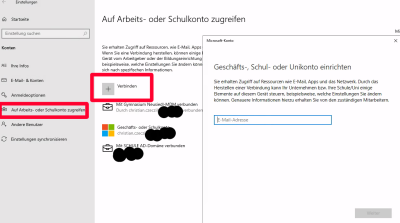
MDM Enrollment
URL wenns in der Microsoft Cloud liegt:
Type Host name Points to TTL
CNAME EnterpriseEnrollment. company_domain.com EnterpriseEnrollment-s.manage.microsoft.com 1 hour
The company_domain in the FQDN should be the registered domain name(s) you are using for single sign on with the UPN. For example if users at Contoso use name@contoso.com as their email/UPN, the Contoso DNS admin would need to create the following CNAMEs.
Type Host name Points to TTL
CNAME EnterpriseEnrollment. contoso.com EnterpriseEnrollment-s.manage.microsoft.com 1 hour
If you have more than one UPN suffix, you need to create one CNAME for each domain name and point each one to EnterpriseEnrollment-s.manage.microsoft.com. For example if users at Contoso use name@contoso.com, but also use name@us.contoso.com, and name@eu.constoso.com as their email/UPN, the Contoso DNS admin would need to create the following CNAMEs.
Type Host name Points to TTL
CNAME EnterpriseEnrollment. contoso.com EnterpriseEnrollment-s.manage.microsoft.com 1 hour
CNAME EnterpriseEnrollment. us.contoso.com EnterpriseEnrollment-s.manage.microsoft.com 1 hour
CNAME EnterpriseEnrollment. eu.contoso.com EnterpriseEnrollment-s.manage.microsoft.com 1 hour
Registration vs Enrollment CNAMEs
Azure Active Directory has a different CNAME that it uses for device registration for iOS, Android, and Windows devices. Intune conditional access requires devices to be registered, also called “workplace joined”. If you plan to use conditional access, you should also configure the EnterpriseRegistration CNAME for each company name you have.
Type Host name Points to TTL
CNAME EnterpriseRegistration. company_domain.com EnterpriseRegistration.windows.net 1 hour
Remotehilfe
Pfad:
%SystemRoot%\system32\quickassist.exe
Installation Powershell zB: auf LTSC 2019
Add-WindowsCapability -Online -Name "App.Support.QuickAssist~~~~0.0.1.0"
Traffic Firewall:
-funktioniert mit Proxy Server (getestet mit Ubuntu 18.04 / Squid)
-Einer der Einstiegspunkte zB: zum Blockieren -
remoteassistance.support.services.microsoft.com Port 443
Kommunikation läuft grundsätzlich über TLS 1.2 siehe hiefür https://docs.microsoft.com/en-us/windows/client-management/quick-assist
-Laufende Kommunikation:
x.x.x.x - - [06/Apr/2021:14:06:54 +0200] "CONNECT webpooldm20r04.infra.lync.com:443 HTTP/1.0" 200 7690 "-" "Mozilla/4.0 (compatible; MSIE 7.0; Windows NT 10.0; Win64; x64; Trident/7.0; .NET4.0C; .NET4.0E; .NET CLR 2.0.50727; .NET CLR 3.0.30729; .NET CLR 3.5.30729)" TCP_TUNNEL:HIER_DIRECT 52.112.81.29 - - x.x.x.x
x.x.x.x - - [06/Apr/2021:14:06:54 +0200] "CONNECT browser.pipe.aria.microsoft.com:443 HTTP/1.0" 200 6824 "-" "Mozilla/4.0 (compatible; MSIE 7.0; Windows NT 10.0; Win64; x64; Trident/7.0; .NET4.0C; .NET4.0E; .NET CLR 2.0.50727; .NET CLR 3.0.30729; .NET CLR 3.5.30729)" TCP_TUNNEL:HIER_DIRECT 40.78.128.150 - - x.x.x.x
x.x.x.x - - [06/Apr/2021:14:06:54 +0200] "CONNECT web.vortex.data.microsoft.com:443 HTTP/1.0" 200 6873 "-" "Mozilla/4.0 (compatible; MSIE 7.0; Windows NT 10.0; Win64; x64; Trident/7.0; .NET4.0C; .NET4.0E; .NET CLR 2.0.50727; .NET CLR 3.0.30729; .NET CLR 3.5.30729)" TCP_TUNNEL:HIER_DIRECT 40.77.226.250 - - x.x.x.x
x.x.x.x - - [06/Apr/2021:14:06:54 +0200] "CONNECT web.vortex.data.microsoft.com:443 HTTP/1.0" 200 6452 "-" "Mozilla/4.0 (compatible; MSIE 7.0; Windows NT 10.0; Win64; x64; Trident/7.0; .NET4.0C; .NET4.0E; .NET CLR 2.0.50727; .NET CLR 3.0.30729; .NET CLR 3.5.30729)" TCP_TUNNEL:HIER_DIRECT 40.77.226.250 - - x.x.x.x
x.x.x.x - - [06/Apr/2021:14:06:57 +0200] "CONNECT webpooldm20r04.infra.lync.com:443 HTTP/1.0" 200 7706 "-" "Mozilla/4.0 (compatible; MSIE 7.0; Windows NT 10.0; Win64; x64; Trident/7.0; .NET4.0C; .NET4.0E; .NET CLR 2.0.50727; .NET CLR 3.0.30729; .NET CLR 3.5.30729)" TCP_TUNNEL:HIER_DIRECT 52.112.81.29 - - x.x.x.x
x.x.x.x - - [06/Apr/2021:14:06:57 +0200] "CONNECT browser.pipe.aria.microsoft.com:443 HTTP/1.0" 200 7249 "-" "Mozilla/4.0 (compatible; MSIE 7.0; Windows NT 10.0; Win64; x64; Trident/7.0; .NET4.0C; .NET4.0E; .NET CLR 2.0.50727; .NET CLR 3.0.30729; .NET CLR 3.5.30729)" TCP_TUNNEL:HIER_DIRECT 40.78.128.150 - - x.x.x.x
x.x.x.x - - [06/Apr/2021:14:06:57 +0200] "CONNECT webpooldm20r04.infra.lync.com:443 HTTP/1.0" 200 14541 "-" "Mozilla/4.0 (compatible; MSIE 7.0; Windows NT 10.0; Win64; x64; Trident/7.0; .NET4.0C; .NET4.0E; .NET CLR 2.0.50727; .NET CLR 3.0.30729; .NET CLR 3.5.30729)" TCP_TUNNEL:HIER_DIRECT 52.112.81.29 - - x.x.x.x
x.x.x.x - - [06/Apr/2021:14:06:57 +0200] "CONNECT web.vortex.data.microsoft.com:443 HTTP/1.0" 200 8557 "-" "Mozilla/4.0 (compatible; MSIE 7.0; Windows NT 10.0; Win64; x64; Trident/7.0; .NET4.0C; .NET4.0E; .NET CLR 2.0.50727; .NET CLR 3.0.30729; .NET CLR 3.5.30729)" TCP_TUNNEL:HIER_DIRECT 40.77.226.250 - - x.x.x.x
x.x.x.x - - [06/Apr/2021:14:06:57 +0200] "CONNECT web.vortex.data.microsoft.com:443 HTTP/1.0" 200 6031 "-" "Mozilla/4.0 (compatible; MSIE 7.0; Windows NT 10.0; Win64; x64; Trident/7.0; .NET4.0C; .NET4.0E; .NET CLR 2.0.50727; .NET CLR 3.0.30729; .NET CLR 3.5.30729)" TCP_TUNNEL:HIER_DIRECT 40.77.226.250 - - x.x.x.x

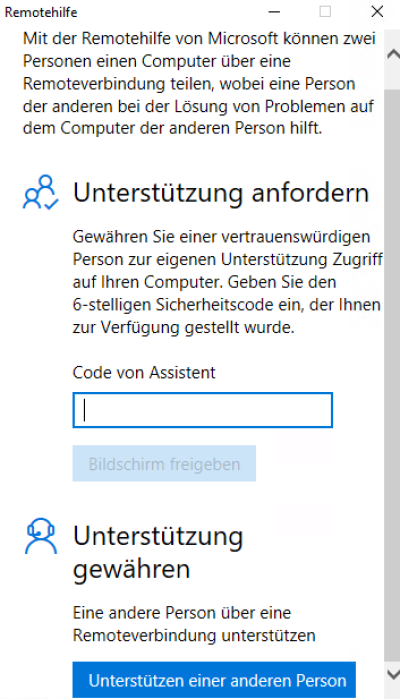

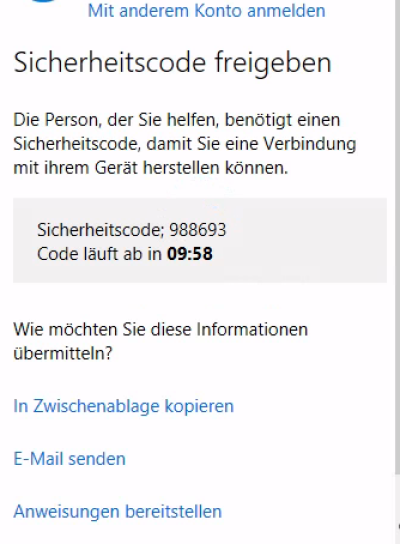
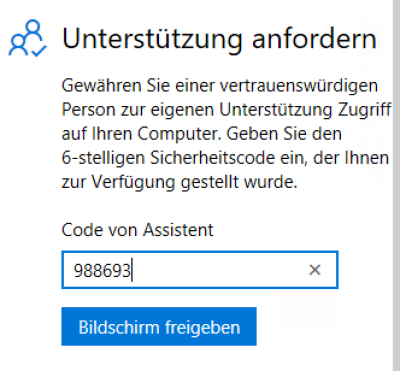
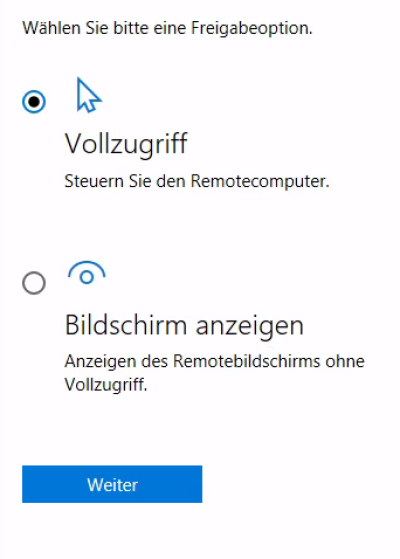
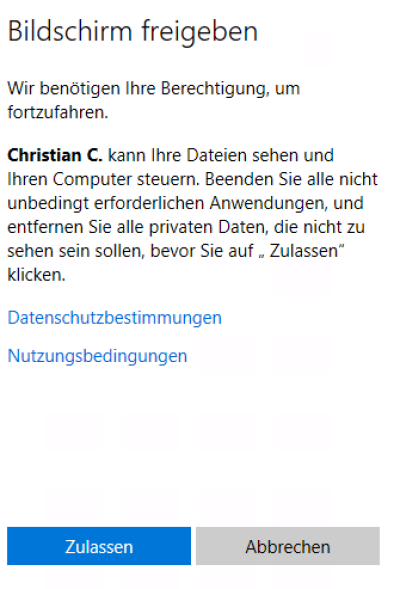
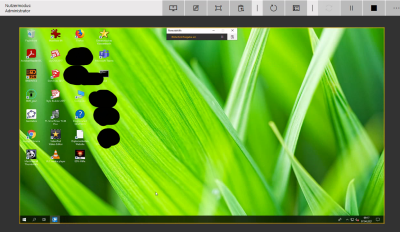
Grundsätzlich können GPO's definiert werden ob auf Maschinen zugegriffen werden darf oder nicht / Funktioniert bei LTSC 2019 offenbar nicht, Einstellung wird vom System ignoriert

Administrator Account Hinzufügen / Resetten / Aktivieren
-
Booten von externem Datenträger zB: Windows live DVD/ USB Stick / shift + F10 für command prompt
utilman.exe durch cmd.exe austauschen im system32 vom Produktiv - System
Wenn das System noch bootet Links neben Power Icon drücken → Command Prompt öffnet sich mit Admin Berechtigungen
Administrator Account aktivieren und Passwort zurück setzen:
net user Administrator Administrator /active:yes /expires:never
Lokale Benutzer Startup
Upgrade LTSB 2016 to LTSC2019
Geht über LTSC2019 ISO obwohl offiziell nicht supported - über reguläres Setup Programm
Nach Upgrade ist sysprep nicht mehr möglich (Microsoft.Windows.SecondaryTileExperience_10.0.0.0_netral_cw5n1h2txyewy) Offenbar verweist das System auf diese App die jedoch bereits gelöscht wurde durch das Upgrade (Errors: 0x3cf2 , 0x80073cf2)
sysprep hat wieder funktioniert nach folgenden Schritten

1. Systemplatte räumen lassen / inklusive Systemdateien
2. Benutzerprofile löschen über Win GUI , die sich löschen lassen /
Erweiterte Einstellungen / Benutzerprofile
3. Installation kb4476976
https://support.microsoft.com/en-us/topic/january-22-2019-kb4476976-os-build-17763-292-21eea485-af3a-2d1e-e3e5-f48ba53def26 (?)
4. Rechner aus dem AD nehmen / wieder Workstation wie bei Erstmaligem sysprep
5. AppXDB Editor für Pakete - https://github.com/SoftSonic83/AppxDBEditor
Microsoft.Windows.SecondaryTileExperience=0
Windows.MiracastView=0
Microsoft.LanguageExperiencePackde-DE=0
6. AppxDBEditor cmd -> so lange bis keine Fehlermeldung kommt / Status ändern auf "löschbar"
7. Admin Powershell
Get-AppxPackage -AllUser -Name Microsoft.Windows.SecondaryTileExperience | Remove-AppxPackage -AllUsers
Get-AppxPackage -AllUser -Name Windows.MiracastView | Remove-AppxPackage -AllUsers
Get-AppxPackage -AllUser -Name Microsoft.LanguageExperiencePackde-DE | Remove-AppxPackage -AllUsers
8. Reboot
9. Sysprep hakerl setzen / oobe Experience / herunterfahren
Upgrade Windows 7 to Windows 10
Administrator CMD.exe ->
net stop wuauserv to stop
Windows - Telemetrie für die Firewall zum blocken
vortex.data.microsoft.com
vortex-win.data.microsoft.com
telecommand.telemetry.microsoft.com
telecommand.telemetry.microsoft.com.nsatc.net
oca.telemetry.microsoft.com
oca.telemetry.microsoft.com.nsatc.net
sqm.telemetry.microsoft.com
sqm.telemetry.microsoft.com.nsatc.net
watson.telemetry.microsoft.com
watson.telemetry.microsoft.com.nsatc.net
redir.metaservices.microsoft.com
choice.microsoft.com
choice.microsoft.com.nsatc.net
df.telemetry.microsoft.com
reports.wes.df.telemetry.microsoft.com
wes.df.telemetry.microsoft.com
services.wes.df.telemetry.microsoft.com
sqm.df.telemetry.microsoft.com
telemetry.microsoft.com
watson.ppe.telemetry.microsoft.com
telemetry.appex.bing.net
telemetry.urs.microsoft.com
telemetry.appex.bing.net
settings-sandbox.data.microsoft.com
vortex-sandbox.data.microsoft.com
survey.watson.microsoft.com
watson.live.com
watson.microsoft.com
statsfe2.ws.microsoft.com
corpext.msitadfs.glbdns2.microsoft.com
compatexchange.cloudapp.net
cs1.wpc.v0cdn.net
a-0001.a-msedge.net
statsfe2.update.microsoft.com.akadns.net
sls.update.microsoft.com.akadns.net
fe2.update.microsoft.com.akadns.net
diagnostics.support.microsoft.com
corp.sts.microsoft.com
statsfe1.ws.microsoft.com
pre.footprintpredict.com
i1.services.social.microsoft.com
i1.services.social.microsoft.com.nsatc.net
feedback.windows.com
feedback.microsoft-hohm.com
feedback.search.microsoft.com
adnexus.net
adnxs.com
az361816.vo.msecnd.net
az512334.vo.msecnd.net
vortex-bn2.metron.live.com.nsatc.net
vortex-cy2.metron.live.com.nsatc.net
dmd.metaservices.microsoft.com
Systemsteuerung direkt ausführen als -> ms-setting
https://www.deskmodder.de/blog/2015/06/03/windows-10-einstellungen-direkt-aufrufen-ausfuehren-dialog/
Einstellungsseite Befehl
Startseite ms-settings:
Energiesparmodus ms-settings:batterysaver
Energiesparmodus (Einstellungen) ms-settings:batterysaver-settings
Akkuverbrauch (Nutzung) ms-settings:batterysaver-usagedetails
Bluetooth-Geräte verwalten ms-settings:bluetooth
Farben ms-settings:colors
Datennutzung ms-settings:datausage
Datum und Zeit ms-settings:dateandtime
Untertitel für Hörgeschädigte ms-settings:easeofaccess-closedcaptioning
Hoher Kontrast ms-settings:easeofaccess-highcontrast
Bildschirmlupe ms-settings:easeofaccess-magnifier
Sprachausgabe ms-settings:easeofaccess-narrator
Tastatur ms-settings:easeofaccess-keyboard
Maus ms-settings:easeofaccess-mouse
Erleichterte Bedienung (Weitere Optionen) ms-settings:easeofaccess-otheroptions
Sperrbildschirm ms-settings:lockscreen
Offline Navigation (Karten) ms-settings:maps
Flugzeugmodus ms-settings:network-airplanemode
Proxy ms-settings:network-proxy
VPN ms-settings:network-vpn
Benachrichtigungen und Aktionen ms-settings:notifications
Konto-Information ms-settings:privacy-accountinfo
Kalender ms-settings:privacy-calendar
Kontakte ms-settings:privacy-contacts
Weitere Geräte ms-settings:privacy-customdevices
Feedback ms-settings:privacy-feedback
Position (Ortung) ms-settings:privacy-location
Nachrichten ms-settings:privacy-messaging
Mikrofon ms-settings:privacy-microphone
Bewegungsdaten ms-settings:privacy-motion
Funkempfang ms-settings:privacy-radios
Spracherkennung, Freihand, Eingabe (Cortana) ms-settings:privacy-speechtyping
Kamera ms-settings:privacy-webcam
Region und Sprache ms-settings:regionlanguage
Sprache (Ein- und Ausgabe) ms-settings:speech
Windows Update ms-settings:windowsupdate
Arbeitsplatzzugriff ms-settings:workplace
Angeschlossene Geräte ms-settings:connecteddevices
Für Entwickler ms-settings:developers
Bildschirm ms-settings:display
Maus und Touchpad ms-settings:mousetouchpad
Mobilfunk ms-settings:network-cellular
Einwahlverbindung (DFÜ) ms-settings:network-dialup
DirectAccess ms-settings:network-directaccess
Ethernet ms-settings:network-ethernet
mobiler Hotspot ms-settings:network-mobilehotspot
Wi-Fi ms-settings:network-wifi
Wi-Fi (Einstellungen) ms-settings:network-wifisettings
Optionale Funktionen ms-settings:optionalfeatures
Familie und weitere Benutzer ms-settings:otherusers
Personalisierung ms-settings:personalization
Hintergrund ms-settings:personalization-background
Farben ms-settings:personalization-colors
Start ms-settings:personalization-start
Netzbetrieb und Energiesparen ms-settings:powersleep
Annäherungssensor ms-settings:proximity
Display-Rotation ms-settings:screenrotation
Anmeldeoptionen ms-settings:signinoptions
Speicher (Verbrauch) ms-settings:storagesense
Themes ms-settings:themes
Eingabe (Rechtschreibung) ms-settings:typing
Tablet-Modus ms-settings:tabletmode
Datenschutzoptionen ms-settings:privacy
Windows RAM Belegung auslesen
f you don't mind using the command line, WMI can do this and is native with Windows XP and newer.
Simply run wmic MEMORYCHIP get BankLabel,DeviceLocator,Capacity,Tag
>wmic MEMORYCHIP get BankLabel,DeviceLocator,Capacity,Tag
BankLabel Capacity DeviceLocator Tag
BANK 0 2147483648 Bottom - Slot 1 (top) Physical Memory 0
BANK 1 4294967296 Bottom - Slot 2 (under) Physical Memory 1
(DeviceLocator will likely give you DIMM numbers on a desktop machine - the top/under slots are because I'm on a laptop. Both BankLabel and DeviceLocator formats may vary by machine.)
Step 1: Design your start menu
Remove / add tiles and apps to and from your start menu ready for the layout to be exported
Step 2: Run Windows PowerShell as administrator
Run the PowerShell as administrator and run the command:
Export-StartLayout –path <path><file name>.xml
Should look like this:
export-startlayout -path C:\startlayout.xml
Step 3: Open Group policy management console (gpmc.msc) and create new GPO
Create a new GPO
Go to User Configuration or Computer Configuration > Policies > Administrative Templates >Start Menu and Taskbar
Right-click Start Layout in the right pane, and click Edit. This opens the Start Layout policy settings
(Please note you will need the Windows 10 GPO add in downloaded to do this, I have a How-to on my page on how to get them, or Windows server 2016.)
Link:
https://community.spiceworks.com/how_to/139795-add-windows-10-group-policy-objects-to-windows-server-2012-r2
Step 4: Configure the GPO
Enter the following settings, and then click OK:
Select Enabled
Under Options, specify the path to the .xml file that contains the Start layout. For example, type C:\Users\Test01\StartScreen.xml or \\ShareName\StartScreen.xml.
Optionally, enter a comment to identify the Start layout.
Step 5: Roll out the GPO
Open CMD on the server and type:
gpupdate /force
And get everyone to restart their work stations
AppAssoc exportieren - Achtung Fehler 0x80004002
Microsoft Windows [Version 10.0.16299.309]
(c) 2017 Microsoft Corporation. Alle Rechte vorbehalten.
C:\Users\Administrator.RESERVE-PC01>cd Desktop
C:\Users\Administrator.RESERVE-PC01\Desktop>dism /online /Export-DefaultAppAssociations:assoc-adobe.xml
Tool zur Imageverwaltung für die Bereitstellung
Version: 10.0.16299.15
Abbildversion: 10.0.16299.309
Fehler: 0x80004002
Die aktuellen Benutzerzuordnungen konnten nicht in die Datei "assoc-adobe.xml" exportiert werden.
Weitere Informationen finden Sie in der Hilfe.
Die DISM-Protokolldatei befindet sich unter "C:\Windows\Logs\DISM\dism.log".
C:\Users\Administrator.RESERVE-PC01\Desktop>
What the fuck :(
https://social.technet.microsoft.com/Forums/en-US/5161bd23-733e-4e2f-a500-d652fc23b81d/the-current-user-associations-could-not-be-exported-to-file-error-0x80004002?forum=win10itprosetup
wusa /uninstall /kb:4088776
what the fuck ² deinstall takes >45 minutes..
----
dism /online /Export-DefaultAppAssociations:assoc-adobe.xml
---
C:\Users\Administrator.RESERVE-PC01\Desktop>cd C:\TMP
C:\TMP>dism /online /Export-DefaultAppAssociations:assoc-adobe.xml
Tool zur Imageverwaltung für die Bereitstellung
Version: 10.0.16299.15
Abbildversion: 10.0.16299.125
Der Vorgang wurde erfolgreich beendet.
batch driver installation
Speaking of newer versions of Windows. In Hyper-V Server 2012 r1 & r2, the command-line is: pnputil <driverinf> – Granger Sep 29 '16 at 3:48
batch subdirectory search and delete
for /d /r "c:\" %%a in (temp\) do if exist "%%a" echo rmdir /s /q "%%a"
For each folder (/d), recursively (/r) under c:\ test for the presence of a temp folder and if it exist, remove it
directory removal command is only echoed to console. If the output is correct, remove the echo command
DISM magic commands
DISM /Online /Cleanup-Image /CheckHealth
Lenovo G2 ITL - Disk nicht gefunden bei WDS - Von VMD auf AHCI umstellen
WDS Fehler - Imagegröße ändert sich nicht in der
GUI - Treiber werden NICHT hinzugefügt obwohl alles OK scheint
Lösung → INDEX:2
Wie finde ich den INDEX → dism /Get-WimInfo /WimFile:File_image.wim
Wie kann ich das gleiche Image wieder mounten nach FAIL → dism /cleanup-wim
E:\TMP\dism-windows-10>.\Dism.exe -Mount-Wim -WimFile:E:\TMP\Windows10_1607_64Bi
t_verteilen.wim -Index:2 -MountDir:E:\TMP-Mount
Deployment Image Servicing and Management tool
Version: 10.0.16299.15
Abbild wird bereitgestellt
[==========================100.0%==========================]
The operation completed successfully.
E:\TMP\dism-windows-10>.\dism -Image:E:\TMP-Mount -Add-Driver -Driver:E:\Treiber
\HP-800-G4-SFF\hp-800-g4-intel-nic-sp98256\src /Recurse
Deployment Image Servicing and Management tool
Version: 10.0.16299.15
Image Version: 10.0.14393.0
Suche nach zu installierenden Treiberpaketen...
Anzahl der zu installierenden Treiberpakete: 2.
1 von 2 - E:\Treiber\HP-800-G4-SFF\hp-800-g4-intel-nic-sp98256\src\E1D\e1d68x64.
inf wird installiert:
INFO: DISM hat die Überprüfung der Treibersignatur übersprungen, weil die Versio
nen des ausgeführten Betriebssystems und des Zielbetriebssystems nicht übereinst
immen.
Das Treiberpaket wurde erfolgreich installiert.
2 von 2 - E:\Treiber\HP-800-G4-SFF\hp-800-g4-intel-nic-sp98256\src\E1R\e1r68x64.
inf wird installiert:
INFO: DISM hat die Überprüfung der Treibersignatur übersprungen, weil die Versio
nen des ausgeführten Betriebssystems und des Zielbetriebssystems nicht übereinst
immen.
Das Treiberpaket wurde erfolgreich installiert.
The operation completed successfully.
E:\TMP\dism-windows-10>.\Dism -Commit-Wim -MountDir:E:\TMP-Mount
Deployment Image Servicing and Management tool
Version: 10.0.16299.15
Abbild wird gespeichert
[==========================100.0%==========================]
The operation completed successfully.
E:\TMP\dism-windows-10>.\Dism -Unmount-Wim -Commit -MOuntDir:E:\TMP-Mount
Deployment Image Servicing and Management tool
Version: 10.0.16299.15
Abbilddatei: E:\TMP\Windows10_1607_64Bit_verteilen.wim
Abbildindex: 2
Abbild wird gespeichert
[==========================100.0%==========================]
Bereitstellung des Abbilds wird aufgehoben
[==========================100.0%==========================]
The operation completed successfully.
wol geht net
wol geht nixda mehr / Gerätemanager wurscht / Hybrid Boot ist deaktiviert! Bios Remote Server HP 800 G1 64Bit Windows 10 16xx
Original Intel 64Bit Windows Treiber von der Intel Seite runterladen!! Da muss ein Bug im Microsoft Treiber sein
Default Programme spezifizieren
Dism /Online /Export-DefaultAppAssociations:\\Server\Share\AppAssoc.xml
Windows 7
psexec Batch command ausführen - netzwerkdrucker löschen
for /F %%f in (DV2.txt.txt) do (
psexec \\%%f -u Administrator -p PASSWORD C:\Windows\System32\cmd.exe /C rundll32 printui.dll,PrintUIEntry /dn /n \\schulserver\EDV2
)
pause
Sprachsteuerung
Du klickst auf Start -> Systemsteuerung -> Center für erleichterte
Bedienung -> Computer ohne einen Bildschirm verwenden.
Dort kannst du die Hakerl rausnehmen wie im Bild angeführt und OK
klicken damit er die Einstellungen übernimmt.
Display klonen über cmd
Displayswitch.exe also has command line parameters that allow you to create a shortcut that will set a specific display mode. /internal /clone /extend /external – JJS Jun 15 '12 at 22:41
Windows Gruppenrichtlinien
Achtung Bei Proxy Einstellungen F5/F6 zum Aktivieren drücken
IE 10 Win2012r2 !!
Drucker
HP2055dn
Wenn er gleich nach dem Starten einen Hex Error anzeigt mit Boot foo → Firmware beschädigt
Drucker via USB an Endgerät ↔ PLC6 Treiber installieren lokal ↔ Tool aus ZIP öffnen HP Firmware rescue
Beim Starten von Drucker abbrechen u. Ok gleichzeitig ←→ bootcode Anzeige auf Display ←→ Tool von HP
-
Windows PXE Server + Linux Bootserver mit NFS
#PXE boots
/srv/grml96 10.0.0.0/8(ro,sync,insecure,no_subtree_check) 192.168.0.0/16(ro,sync,insecure,no_root_squash,no_subtree_check)
/srv/mint18 10.0.0.0/8(ro,sync,insecure,no_root_squash,no_subtree_check) 192.168.0.0/16(ro,sync,insecure,no_root_squash,no_subtree_check)
/srv/avira 10.0.0.0/8(ro,sync,insecure,no_root_squash,no_subtree_check) 192.168.0.0/16(ro,sync,insecure,no_root_squash,no_subtree_check)
/srv/wipe 10.0.0.0/8(ro,sync,insecure,no_root_squash,no_subtree_check) 192.168.0.0/16(ro,sync,insecure,no_root_squash,no_subtree_check)
Keywords: WDS , Deployment, PXE , PXE-Boot, boot, Network Boot, wds , deployment , pxe
dhcp-server pxe bios boot optionen
Getestet auf DHCP Server von Windows 2012r2
Achtung funktioniert nur auf legacy boot systemen die kein UEFI brauchen
Zeichenfolgewert ⇔ IP des TFTP Servers
-
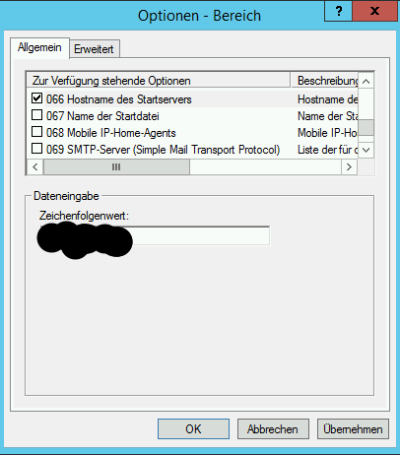

dhcp-boot=pxelinux.0,HOSTNAME_SERVER,IP_SERVER
Applikationen/GPOs
TINspire CX CAS Student
Schullizenz kann jährlich verlängert werden / Gleichzeitige Ausführung von zB: 5 Instanzen
Problem - er kann keine Verbindung mit dem Lizenzserver herstellen
Auf dem Lizenzserver läuft lservnt.exe auf UDP Port 5093
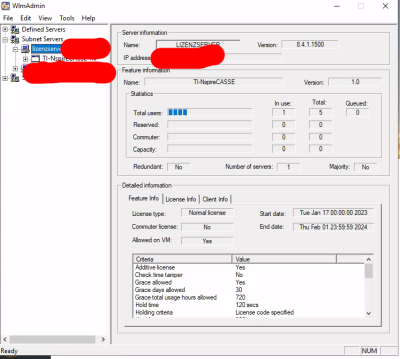
Profile automatisiert löschen bei Speichermangel
Es sollen die Profile auf der lokalen Maschine gelöscht werden wenn der verfügbare Speicher unter ein definierten Threshold fällt zB: 10GB / Als Computer Startup GPO → Powershell Skripte
-
Check_Harddisk_Notification.ps1
$driveCheck="C"
$threshold=10
#2022-03-10 cc: Thanks https://stackoverflow.com/questions/12159341/how-to-get-disk-capacity-and-free-space-of-remote-computer
$foo=Get-PSDrive C
$foo=$($foo.Free)
$message = ""
if( ($foo/ 1GB) -lt $threshold )
{
$message = "Disk Space is NOT good - Drive: "+$driveCheck+" / GB free: "+($foo/1GB)+" / Computer: "+$env:computername+" / Threshold GB: "+$threshold+"`r`n"
$message += . '\\DOMAIN\SysVol\DOMAIN\Policies\POL_ID\Machine\Scripts\Startup\delprof2.exe' /u
}
else
{
$message = "Disk Space is good - Drive: "+$driveCheck+" / GB free: "+($foo/1GB)+" / Computer: "+$env:computername+" / Threshold GB: "+$threshold
}
write-Output ($message) > C:\harddisk_check.txt
Shutdown if 2.5 hours idle
if exist "C:\trigger_shutdownifidle_success.txt" goto ENDE
if exist "C:\Scripts" goto Copy_BAT
mkdir C:\Scripts
icacls C:\Scripts /grant Administratoren:F /grant SYSTEM:F /grant Administrator@schule.intern:F /inheritance:r
:Copy_BAT
icacls C:\Scripts /grant Administratoren:(CI)(OI)(F) /grant SYSTEM:(CI)(OI)(F) /grant Administrator@schule.intern:(CI)(OI)(F) /inheritance:r
copy /Y \\DOMAIN\SysVol\DOMAIN\Policies\PATH_POLICY\Machine\Scripts\Startup\shutdown.bat C:\Scripts\shutdown.bat
schtasks /create /xml "\\DOMAIN\SysVol\DOMAIN\Policies\PATH_POLICY\Machine\Scripts\Startup\\ShutdownIdle.xml" /tn "Trigger_Shutdown_If_Idle"
if %ERRORLEVEL% EQU 0 ( echo "success" > C:\trigger_shutdownifidle_success.txt )
:ENDE
<?xml version="1.0" encoding="UTF-16"?>
<Task version="1.4" xmlns="http://schemas.microsoft.com/windows/2004/02/mit/task">
<RegistrationInfo>
<Date>2020-11-12T10:57:39.9973789</Date>
<Author>SCHULE\christian.czeczil</Author>
<URI>\Trigger_Shutdown_If_Idle</URI>
</RegistrationInfo>
<Triggers>
<IdleTrigger>
<Enabled>true</Enabled>
</IdleTrigger>
</Triggers>
<Principals>
<Principal id="Author">
<UserId>S-1-5-18</UserId>
<RunLevel>HighestAvailable</RunLevel>
</Principal>
</Principals>
<Settings>
<MultipleInstancesPolicy>IgnoreNew</MultipleInstancesPolicy>
<DisallowStartIfOnBatteries>false</DisallowStartIfOnBatteries>
<StopIfGoingOnBatteries>true</StopIfGoingOnBatteries>
<AllowHardTerminate>false</AllowHardTerminate>
<StartWhenAvailable>false</StartWhenAvailable>
<RunOnlyIfNetworkAvailable>false</RunOnlyIfNetworkAvailable>
<IdleSettings>
<Duration>PT10M</Duration>
<WaitTimeout>PT0S</WaitTimeout>
<StopOnIdleEnd>true</StopOnIdleEnd>
<RestartOnIdle>false</RestartOnIdle>
</IdleSettings>
<AllowStartOnDemand>true</AllowStartOnDemand>
<Enabled>true</Enabled>
<Hidden>false</Hidden>
<RunOnlyIfIdle>true</RunOnlyIfIdle>
<DisallowStartOnRemoteAppSession>false</DisallowStartOnRemoteAppSession>
<UseUnifiedSchedulingEngine>true</UseUnifiedSchedulingEngine>
<WakeToRun>false</WakeToRun>
<ExecutionTimeLimit>PT0S</ExecutionTimeLimit>
<Priority>7</Priority>
</Settings>
<Actions Context="Author">
<Exec>
<Command>C:\Scripts\shutdown.bat</Command>
</Exec>
</Actions>
</Task>
timeout 9000 /nobreak
shutdown /a
shutdown /f /s /t 0
if not exist C:\trigger_shutdownifidle_success.txt goto Ende
schtasks /change /ENABLE /tn "Trigger_Shutdown_If_Idle" > C:\trigger_Shutdown_If_Idle_ENABLE.txt 2>&1
:Ende
if not exist C:\trigger_shutdownifidle_success.txt goto Ende
schtasks /change /DISABLE /tn "Trigger_Shutdown_If_Idle" > C:\trigger_Shutdown_If_Idle_DISABLE.txt 2>&1
:Ende
Office 2021 Professinal Plus LTS - MAK/KMS Key Installation
Vorher das Office Deployment Tool runter laden / es geht um die aktuelle setup.exe die auch den Produkt Code kennt / vorher Programminhalt download mit .\setup.exe /download setup.xml
Achtung in dieser Variante zum manuellen installieren rechtsklick → als Administrator ausführen / Zuerst wird Office 2019 deinstalliert und ggf. Office 2016 wenn es per msi installiert wurde
-
if exist C:\office2021ltsc_success.txt goto Ende
\\server\share\Office2021LTSC\setup.exe /configure \\server\share\Office2021LTSC\remove-2019.xml
\\server\share\Office2021LTSC\setup.exe /configure \\server\share\Office2021LTSC\setup.xml
if %ERRORLEVEL% EQU 0 ( echo "success" > C:\office2021ltsc_success.txt )
:Ende
<!-- Office 2019 enterprise client configuration file sample. To be used for Office 2019
enterprise volume licensed products only, including Office 2019 Professional Plus,
Visio 2019, and Project 2019.
Do not use this sample to install Office 365 products.
For detailed information regarding configuration options visit: http://aka.ms/ODT.
To use the configuration file be sure to remove the comments
The following sample allows you to download and install Office 2019 Professional Plus,
Visio 2019 Professional, and Project 2019 Professional directly from the Office CDN.
-->
<Configuration>
<Remove>
<Product ID="ProPlus2019Volume">
<Language ID="de-de" />
</Product>
</Remove>
<Property Name="FORCEAPPSHUTDOWN" Value="FALSE"/>
<Display Level="None" AcceptEULA="TRUE" />
</Configuration>
<!-- Office 2019 enterprise client configuration file sample. To be used for Office 2019
enterprise volume licensed products only, including Office 2019 Professional Plus,
Visio 2019, and Project 2019.
Do not use this sample to install Office 365 products.
For detailed information regarding configuration options visit: http://aka.ms/ODT.
To use the configuration file be sure to remove the comments
The following sample allows you to download and install Office 2019 Professional Plus,
Visio 2019 Professional, and Project 2019 Professional directly from the Office CDN.
-->
<!-- https://learn.microsoft.com/en-us/deployoffice/vlactivation/gvlks#gvlks-for-office-ltsc-2021 KMS Key activation keys!-->
<Configuration>
<Add SourcePath="\\share\Office2021LTSC\" OfficeClientEdition="64" Channel="PerpetualVL2021">
<Product ID="ProPlus2021Volume" PIDKEY="MAK/Generic Volume License KEY">
<Language ID="de-de" />
</Product>
</Add>
<RemoveMSI All="True" />
<Display Level="Full" AcceptEULA="TRUE" />
<Property Name="AUTOACTIVATE" Value="1" />
</Configuration>
Office 2019 Professinal Plus - MAK Key Installation
<!-- Office 2019 enterprise client configuration file sample. To be used for Office 2019
enterprise volume licensed products only, including Office 2019 Professional Plus,
Visio 2019, and Project 2019.
Do not use this sample to install Office 365 products.
For detailed information regarding configuration options visit: http://aka.ms/ODT.
To use the configuration file be sure to remove the comments
The following sample allows you to download and install Office 2019 Professional Plus,
Visio 2019 Professional, and Project 2019 Professional directly from the Office CDN.
-->
<Configuration>
<Add OfficeClientEdition="32" Channel="PerpetualVL2019">
<Product ID="ProPlus2019Volume" PIDKEY="">
<Language ID="de-de" />
</Product>
</Add>
<!-- <RemoveMSI All="True" /> -->
<Display Level="Full" AcceptEULA="TRUE" />
<Property Name="AUTOACTIVATE" Value="1" />
</Configuration>
<Configuration Product="ProPlus">
<Display Level="Full" CompletionNotice="no" SuppressModal="yes" AcceptEula="yes" />
</Configuration>
if exist "C:\Program Files (x86)\Microsoft Office\root\Office16" goto Ende
if exist "C:\Program Files (x86)\Common Files\microsoft shared\OFFICE16\Office Setup Controller\setup.exe" goto Remove
goto Install
:Remove
"C:\Program Files (x86)\Common Files\microsoft shared\OFFICE16\Office Setup Controller\setup.exe" /uninstall ProPlus /config \\schulserver\windows10-programme$\Office2019\uninstall_office.xml
:Wait
timeout 10 /nobreak
if exist "C:\Program Files (x86)\Common Files\microsoft shared\OFFICE16\Office Setup Controller\setup.exe" goto Wait
:Install
\\schulserver\windows10-programme$\Office2019\setup.exe /configure \\schulserver\windows10-programme$\Office2019\setup.xml
echo "installed_office2019" > C:\Office2019_installed.txt
:Ende
echo finished
pause
Windows Auto Login deaktivieren
Windows Auto Login aktivieren für Benutzer
Windows Upgrade LTSB2016 auf LTSC (2019)
echo off
FOR /F "tokens=4 USEBACKQ" %%F IN (`ver`) DO (
SET var=%%F
)
#Windows 10 LTSC (2019)
if %var% == 10.0.17763.107] goto Ausloggen
\\schulserver\windows10-programme$\LTSC2019\setup.exe /auto upgrade /dynamicupdate disable /compat ignorewarning
:Ende
exit
:Ausloggen
logoff
exit
Windows Updates deaktivieren
echo > C:\disable_updates.txt
sc config wuauserv start= disabled > C:\disable_updates.txt 2>&1
sc config usosvc start= disabled >> C:\disable_updates.txt 2>&1
net stop wuauserv >> C:\disable_updates.txt 2>&1
net stop usosvc >> C:\disable_updates.txt 2>&1
Windows Updates aktivieren
echo > C:\enable_updates.txt
sc config wuauserv start= demand > C:\enable_updates.txt 2>&1
sc config usosvc start= demand >> C:\enable_updates.txt 2>&1
net start wuauserv >> C:\enable_updates.txt 2>&1
net start usosvc >> C:\enable_updates.txt 2>&1
Windows Updates durchführen
%SystemRoot%\system32\usoclient.exe ScanInstallWait
%SystemRoot%\system32\timeout.exe /T 300 /NOBREAK
%SystemRoot%\system32\usoclient.exe StartInstall
echo > C:\update_durchfueren.txt
Windows Updates manuell planen u. installieren
Getestet mit LTSC 2019
Nachdem der Update Plan (Stand 18.05.2022) ignoriert wird und keine Updates mehr entsprechend der Gruppenrichtlinien installiert werden muss wieder eine manuelle Lösung her
Die Microsoft native Art und Weise die Updates über powershell zu installieren funktioniert nicht wird einmal entfernt oder wieder hinzugefügt
Achtung bei LTSC 2016 verwendet die Maschine per Default NICHT TLS1.2 - FAIL
Achtung ggf. Asynchron ausführen (Computerrichtlinien→ System → Skripts) und NICHT auf Netzwerk warten
Danke an den Entwickler von PSWindowsUpdate / GPO Rechner Start / Powershell Modul auf Rechnern installiereninstall_ps_windowsupdate.ps1
if ( -not ( Get-Module -ListAvailable -Name PSWindowsUpdate ) )
{
[Net.ServicePointManager]::SecurityProtocol = [Net.SecurityProtocolType]::Tls12
Install-PackageProvider -Name NuGet -MinimumVersion 2.8.5.201 -Force > C:\install_ps_windowsupdate_log.txt
Install-Module -Name PSWindowsUpdate -Force >> C:\install_ps_windowsupdate_log.txt
}
else
{
write-host "PSWindows Update already installed"
}
#%A Day of the week - full name Monday
#%u Numeric day of the week (1-7) Monday = 1, Sunday = 7
$current_day=(Get-Date -UFormat "%u").toString()
$current_hour=(Get-Date -UFormat "%H")
#write-host $current_day
if ($current_day -eq "3" -and ([int]$current_hour -lt 7))
{
if(Get-Module -ListAvailable -Name PSWindowsUpdate)
{
Get-WindowsUpdate > C:\Windows_update.txt
Install-WindowsUpdate -MicrosoftUpdate -IgnoreReboot -AcceptAll >> C:\windows_update.txt
}
}
Microsoft Teams Installation
if exist C:\teams_installed.txt goto Ende
msiexec /i \\SERVER_PATH_TRUSTED\Teams_windows_x64.msi OPTIONS="noAutoStart=true" ALLUSERS=1
echo foo > C:\teams_installed.txt
:Ende
Microsoft Teams Upgrade Installation
if exist C:\teams_installed_1.txt goto Ende
if exist C:\teams_installed.txt goto Deinstallieren
if not exist C:\teams_installed.txt goto Installieren
:Deinstallieren
msiexec /x \\SERVER_PATH_TRUSTED\Teams_windows_x64_old.msi /quiet
:Installieren
msiexec /i \\SERVER_PATH_TRUSTED\Teams_windows_x64.msi OPTIONS="noAutoStart=true" ALLUSERS=1
echo foo > C:\teams_installed_1.txt
:Ende
Immunet silent Deinstallation
if exist "C:\immunet_deinstalled.txt" goto ENDE
\\share_network\ImmunetSetup.exe /S /remove 1
echo "deinstalled" > C:\immunet_deinstalled.txt"
:ENDE
Archicad Education 24 verteilen
if exist "C:\Program Files\GRAPHISOFT\ArchiCAD 19\ArchiCAD.exe" goto Uninstall19
if exist "C:\archicad24_installed.txt" goto Ende
"\\share_network\ArchiCad24\ARCHICAD-24-AUT-3008-1.7.exe" --mode unattended --enableautomaticupdate 0 --eduSerialNumber SERIAL_NUMBER --eduUserID USER_ID
echo > C:\archicad24_installed.txt
goto Ende
:Uninstall19
start "" /wait "C:\Program Files\GRAPHISOFT\ArchiCAD 19\Uninstall.AC\uninstaller.exe" -silent
shutdown /r /t 60
:Ende
PrinterNightmare nightmare
Well done Microsoft - drucken funktioniert nicht mehr, wenn der Drucker nicht bereits hinzugefügt wurde - Stand 2021-09-20 - LTSC2019 Workstations u. 2012r2 Druckserver
-
Computer GPO Startup Skript um einen Drucker direkt hinzuzufügen
$printerName="HP-DRUCKER-DIREKT"
$printerIP="IP-HP-DRUCKER"
$printerCheck="C:\HP-DRUCKER-DIREKT-installed.txt"
if ( -not (Test-Path "C:\HP-Printer-Drivers-installed.txt") )
{
#Standort PCL6 Treiber von HP
pnputil /add-driver \\SERVER\FREIGABE\*.inf /install /subdirs > C:\HP-Printer-Drivers-installed.txt
}
if ( -not (Test-Path $printerCheck ))
{
Add-PrinterDriver -Name "HP Universal Printing PCL 6"
Add-PrinterPort -Name $printerIP"_Port_Manual" -PrinterHostAddress $printerIP
Add-Printer -Name $printerName -PortName $printerIP"_Port_Manual" "HP Universal Printing PCL 6"
if($?)
{
write-host "installed" > $printerCheck
}
}
Hardware Details erfassen
Um wesentliche Hardwaredetails der Rechner zu erfassen wie Hersteller des Geräts / Seriennummern / Prozessor / RAM / Festplatte - mit Get-WmiObject -List erhält man eine Liste mit allen Möglichkeiten
Als Startup - Computer Richtlinie geeignet , am Share ausschließlich Schreib-Zugriff auf „Domänencomputer“ geben
#Get-WmiObject -List
$checkFile="\\SERVER\HWDETAILS$\$env:computername.log"
if ( -not (Test-Path $checkFile))
{
Get-WmiObject -Class Win32_Bios | Format-List -Property * | Out-File $checkFile
Get-WmiObject -Class Win32_Processor | Format-List -Property * | Out-File -Append $checkFile
Get-WmiObject -Class Win32_DiskDrive | Format-List -Property * | Out-File -Append $checkFile
Get-WmiObject -Class Win32_PhysicalMemory | Format-List -Property * | Out-File -Append $checkFile
}
Archicad 24 Education Lizenz verteilen
@echo off
if exist "C:\archicad_license_2019.txt" goto Ende
copy /Y \\share_network\education.lic "C:\ProgramData\ARCHICAD\AC_24_AUT"
if %errorlevel% equ 0 ( echo "success" > C:\archicad_license_2019.txt )
:Ende
Google Sketchup 8 deinstallieren
if exist C:\sketchup8_deinstalled.txt goto Ende
msiexec.exe /x "\\LOCATION\Sketchup_8\GoogleSketchUp8.msi" /q
echo > C:\sketchup8_deinstalled.txt
:Ende
MSDT Diagnose deaktivieren
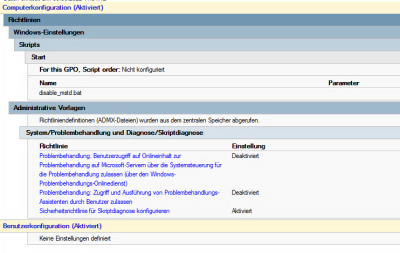
if exist C:\ms-msdt.reg goto Ende
reg export HKEY_CLASSES_ROOT\ms-msdt C:\ms-msdt.reg
reg delete HKEY_CLASSES_ROOT\ms-msdt /f
:Ende
Power BI Desktop installieren
msi ist deprecated / zumindest laut einer Microsoft Seite /
\\vboxsrv\tmp entsprechend anpassen
if exist C:\PowerBI_installed.txt goto Ende
start /wait \\vboxsrv\tmp\PBIDesktopSetup_x64.exe /s ACCEPT_EULA=1
if %ERRORLEVEL% EQU 0 echo > C:\PowerBI_installed.txt
:Ende
\\vboxsrv\tmp\PBIDesktopSetup_x64.exe /s /uninstall
Krita installieren
if exist C:\Krita_installed.txt goto Ende
start /wait \\vboxsrv\tmp\krita-x64-5.1.1-setup.exe /S
if %ERRORLEVEL% EQU 0 echo > C:\Krita_installed.txt
:Ende
if not exist "C:\Program Files\Krita (x64)\uninstall.exe" goto Ende
"C:\Program Files\Krita (x64)\uninstall.exe" /S
:Ende
Testen der Thresholds und Werte + Timeouts
Testen über Intune
mehr checks ID ↔ mail ↔ UPN und zur Sicherheit noch ein „Mindestabstand“ zum Enrollment date
Beschreibung
/ Einrichtung GPOs und Applikation adconnect https://docs.microsoft.com/en-us/azure/active-directory/hybrid/how-to-connect-sso-quick-start
) deaktiviert hat - es muss mit zumindest TLS 1.2 zugegriffen werden
/ welches Raid wird hier eigentlich gebaut ???) - ich hätte eigentlich gern RAID10 - mit 4x6TB SATA Platten
- restart abbrechen mit shutdown -a / Azure integrierter Rechner / Nicht integrierter Rechner Unterschiede
